
Switzerland
September 10-20, 2023
Mike and Judy Henderson
In this installment we depart Lugano and travel to St. Moritz.

+++++++++++++++++++++++++++++++++++++++++
9/15/2023 (Friday) It rained hard during the night, with flashes of lighting that illuminated our hotel room. By morning, it was still raining, but not as hard.
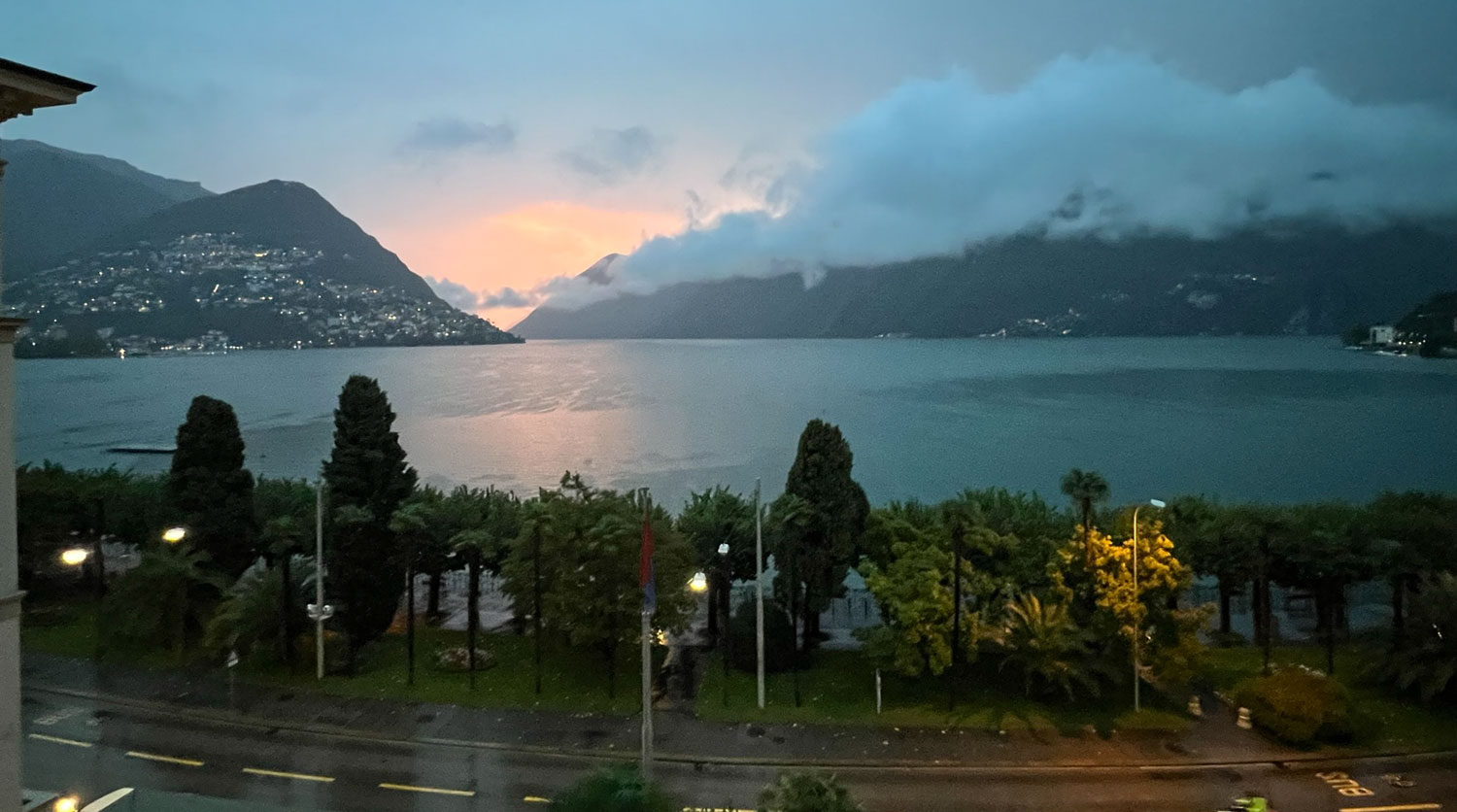
We had breakfast at 7am and met the coach at 8:15. Here's Peter waiting for us at the bus.
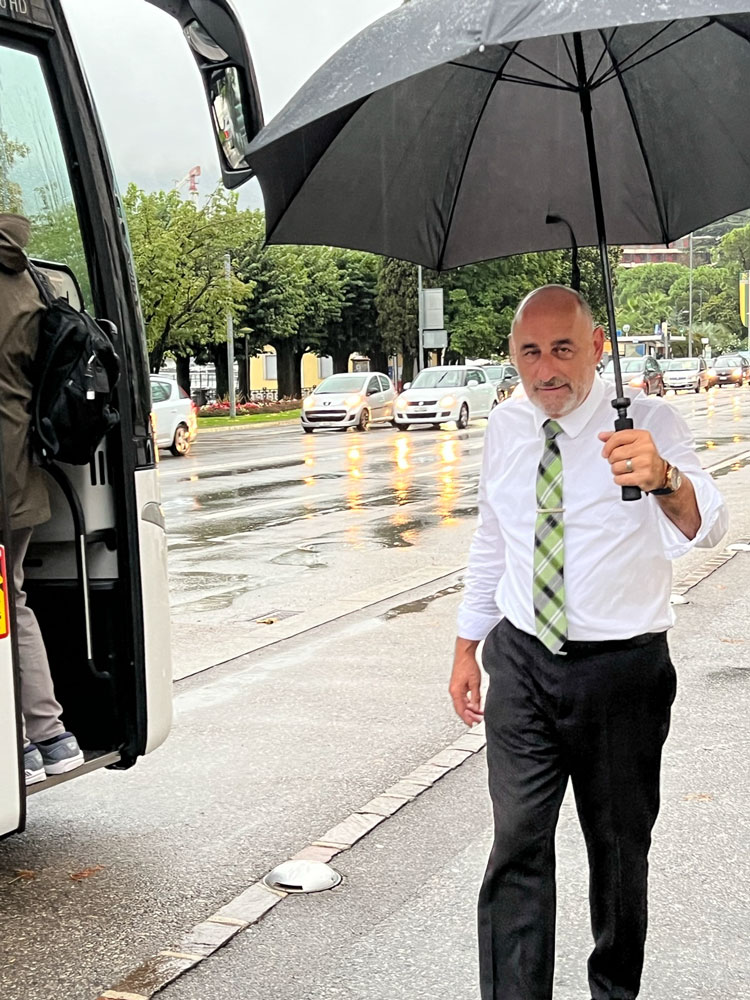
We will travel first to Como, in Italy, then drive up the west coast of Lake Como until we stop across from Bellagio, which we'll visit. Almost all through the drive it was raining, not hard, but continuous.
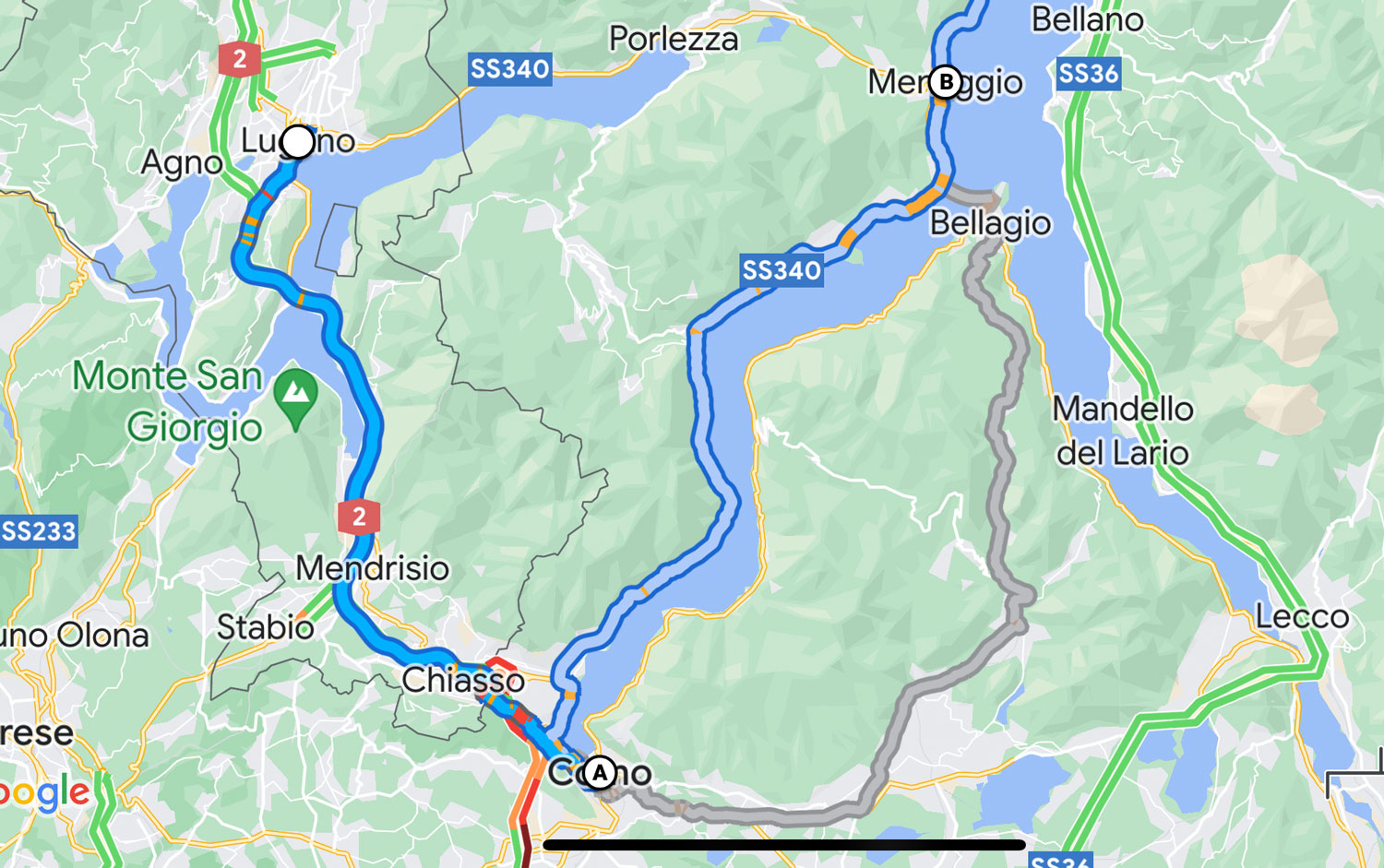
After about an hour and forty-five minute drive, we arrived at the dock across the lake from Bellagio.
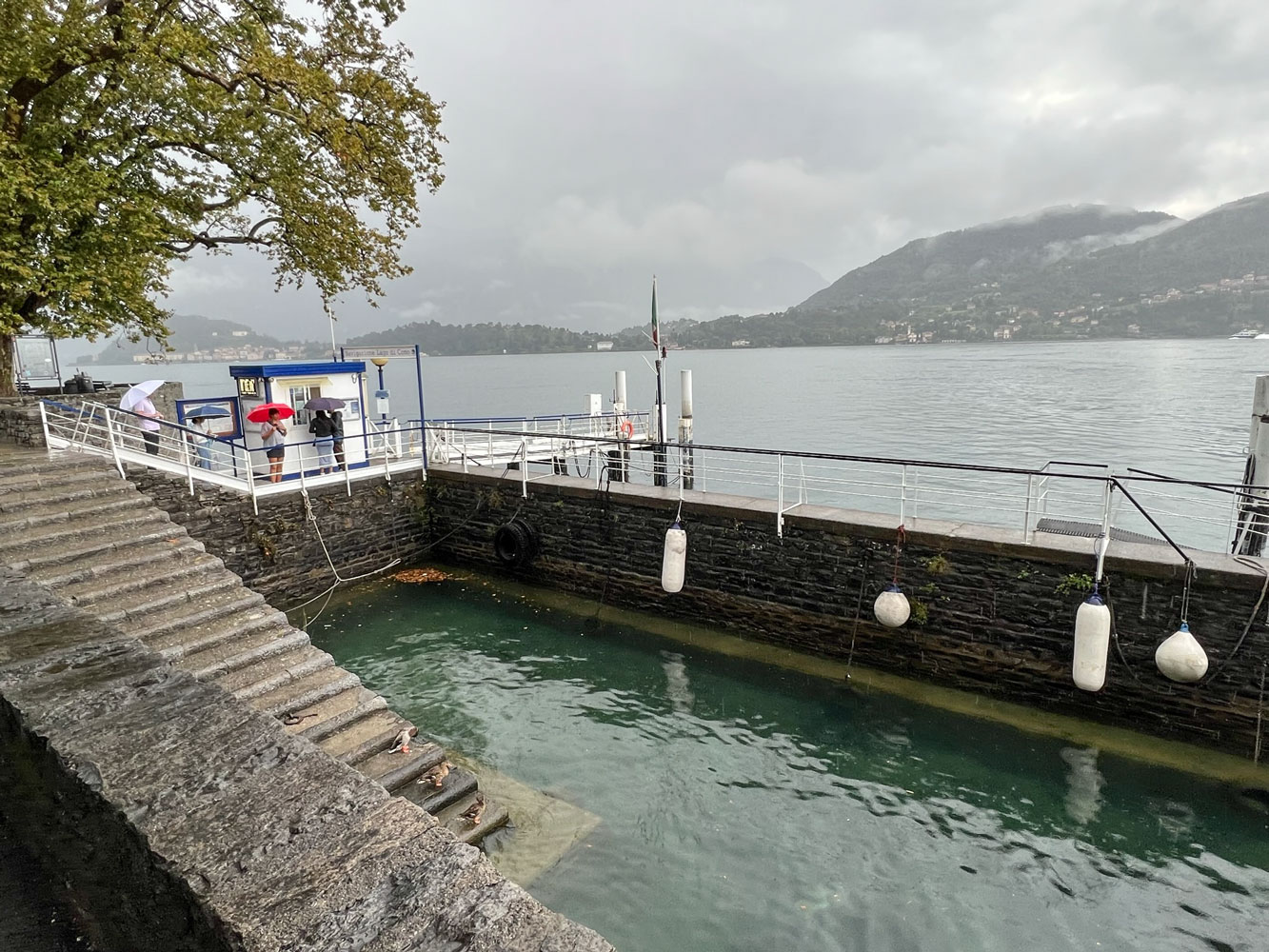
The boat that Tauck had chartered to take us to Bellagio was just arriving.
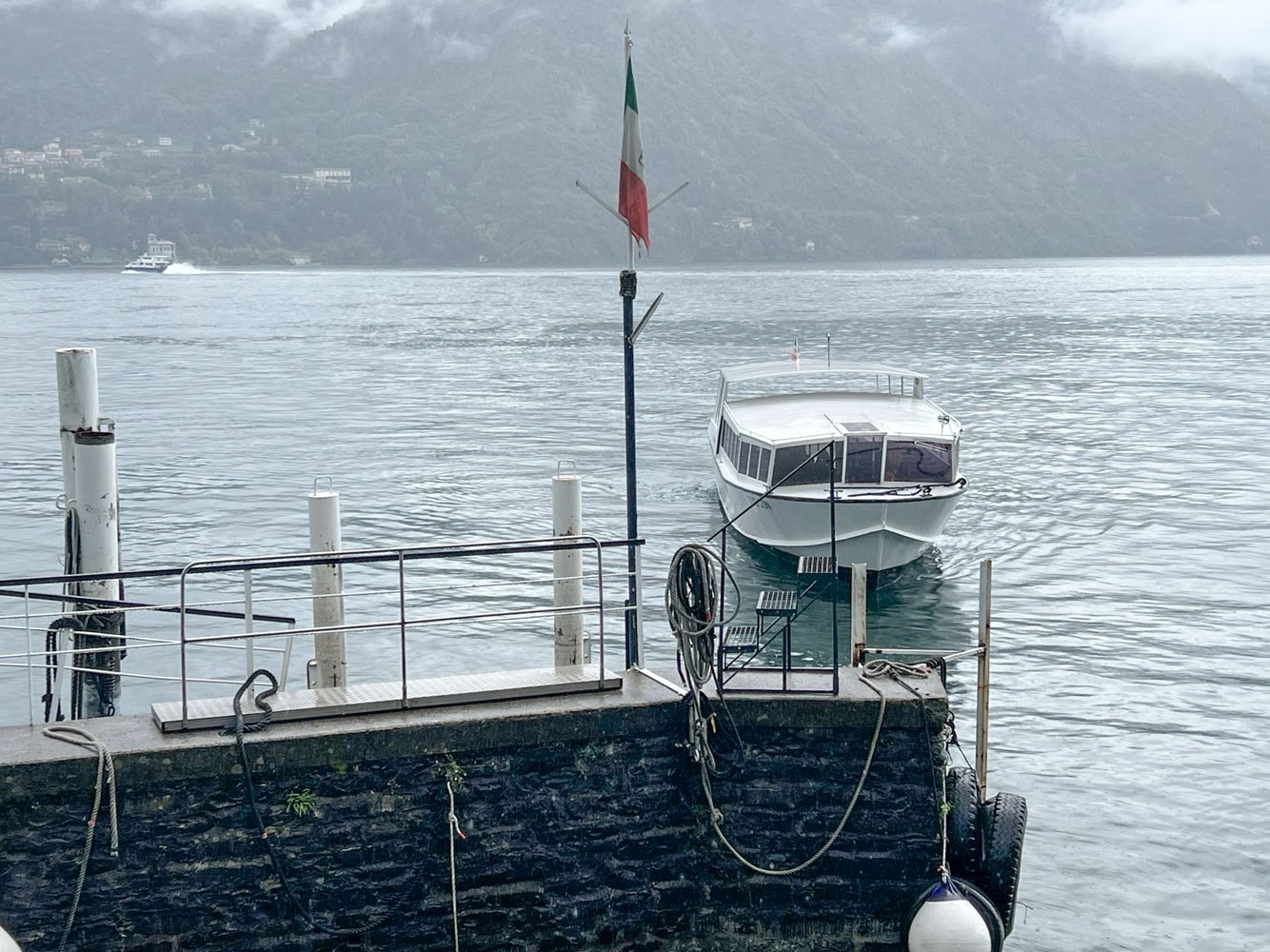
While it had been drizzling, by the time everyone was on board, the rain stopped. Here's Jean on the boat. She said she's never happy with pictures of her, but I thought this one was good.
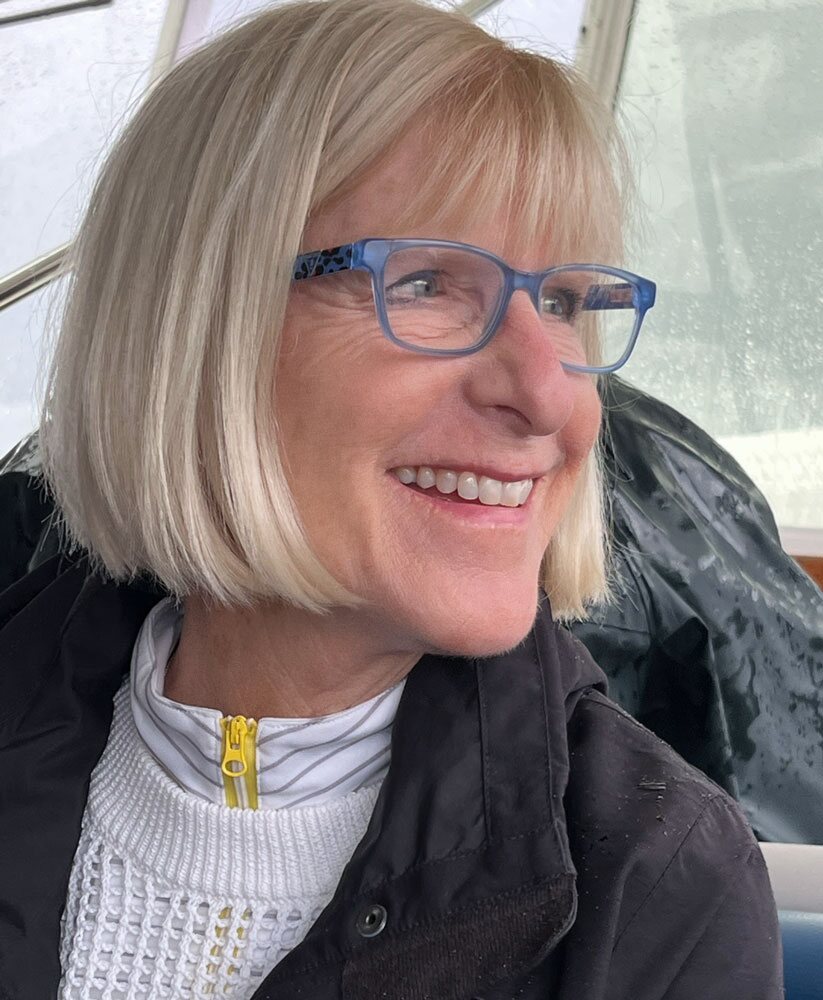
When we arrived at Bellagio, Carrie gave us a briefing, and we all went shopping.
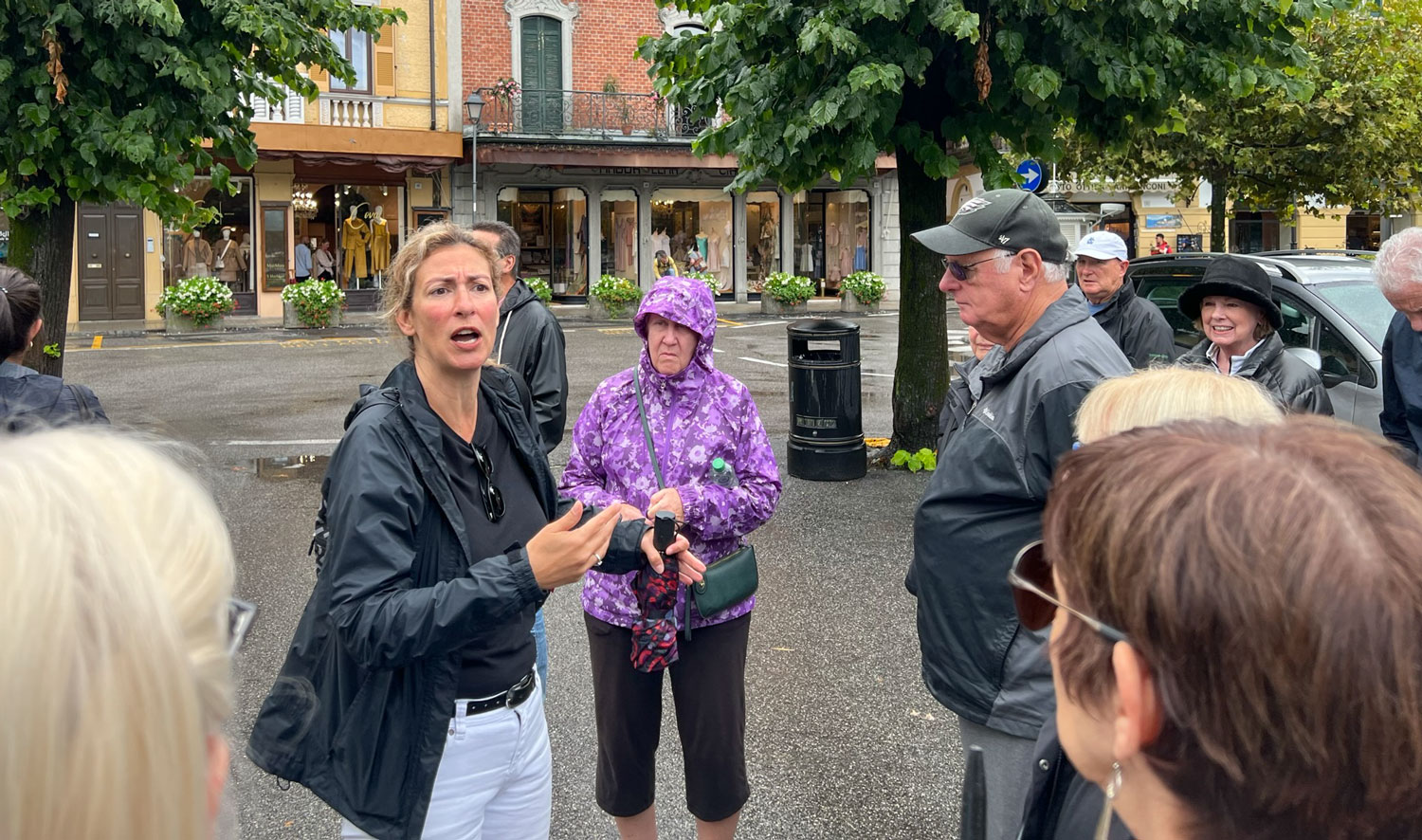
Georgine and Rick are ready to walk up the stairs to the shopping areas.
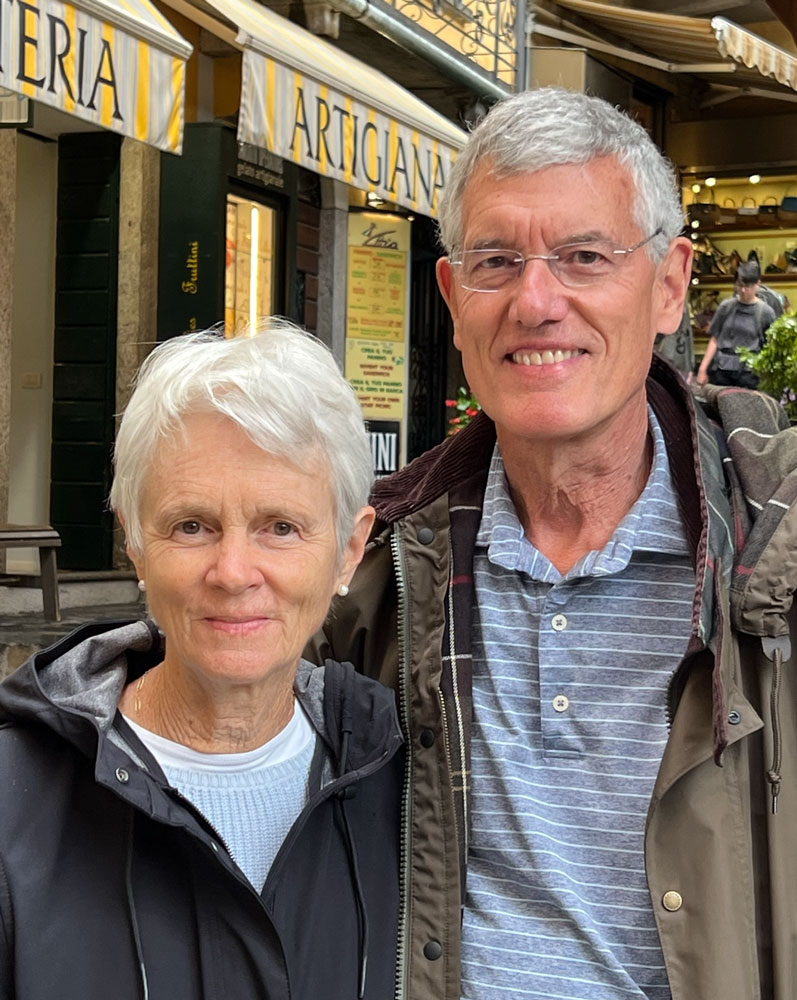
Judy and I had spent some time at Lake Como back in 2015 so we were a bit familiar with Bellagio. The land rises steeply from the lake, and Bellagio is no exception. There are a lot of stairs.
Jean and Judy head up the stairs. This picture makes the stairs look fairly flat. They are not - it takes a significant effort to go from bottom to top.
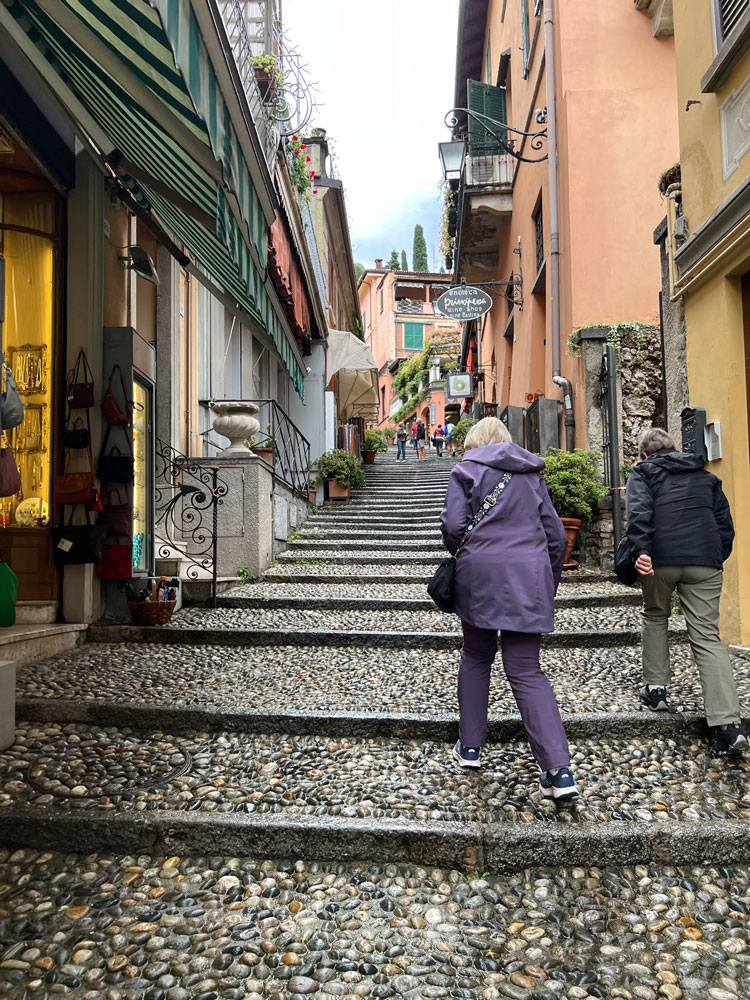
Jean found a scarf store and purchased two beautiful scarves. Sorry, no pictures.
We just walked around the town, did some looking and shopping, and then came back to the lakeside.
Boats are the public buses of this area, and this was the Bellagio station.
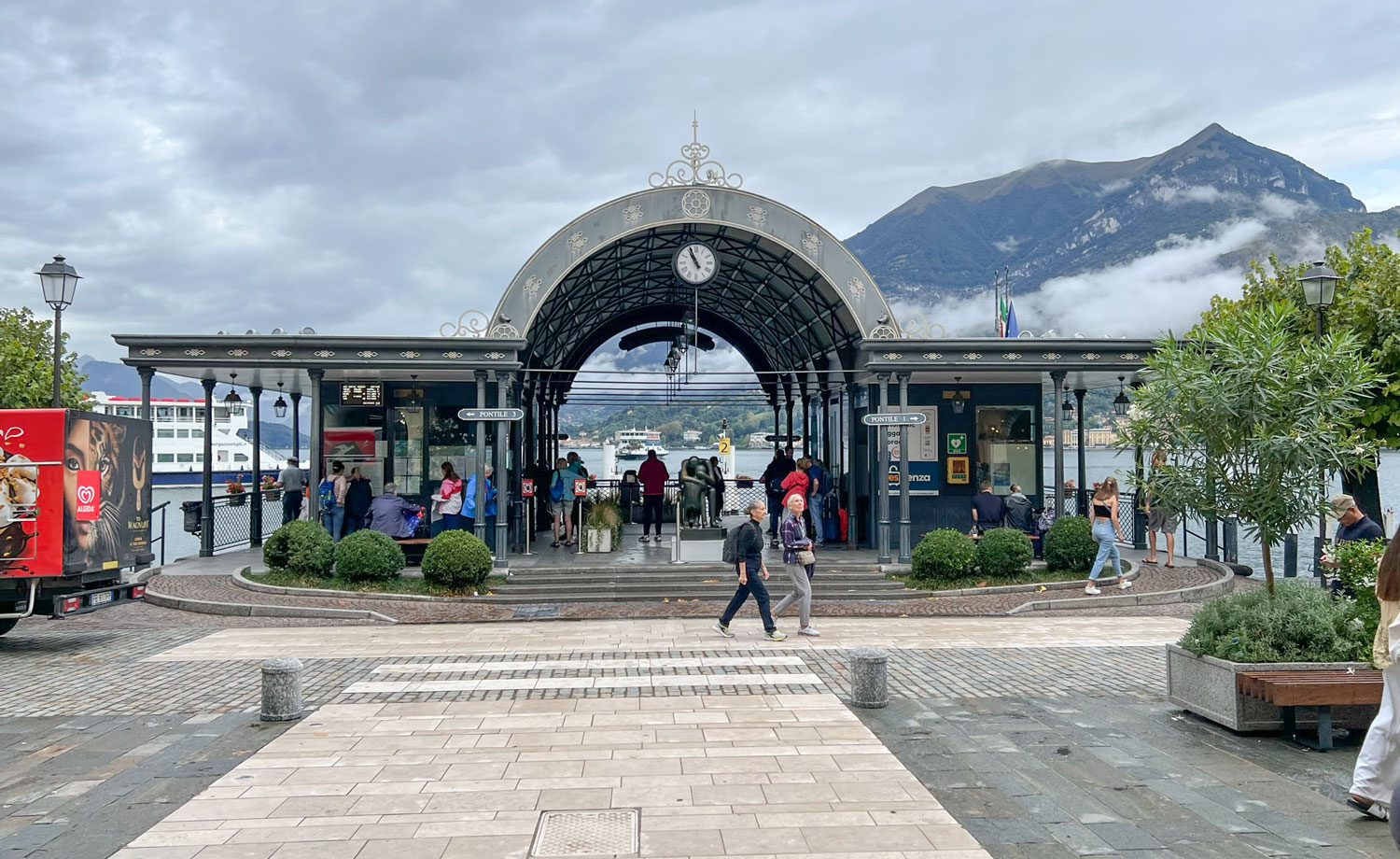
We gathered at the dock where our boat was to pick us up, and as we started boarding the boat, it started raining again. We had no rain during our visit to Bellagio.
Here's our group on the boat as we headed back across the lake to the bus.
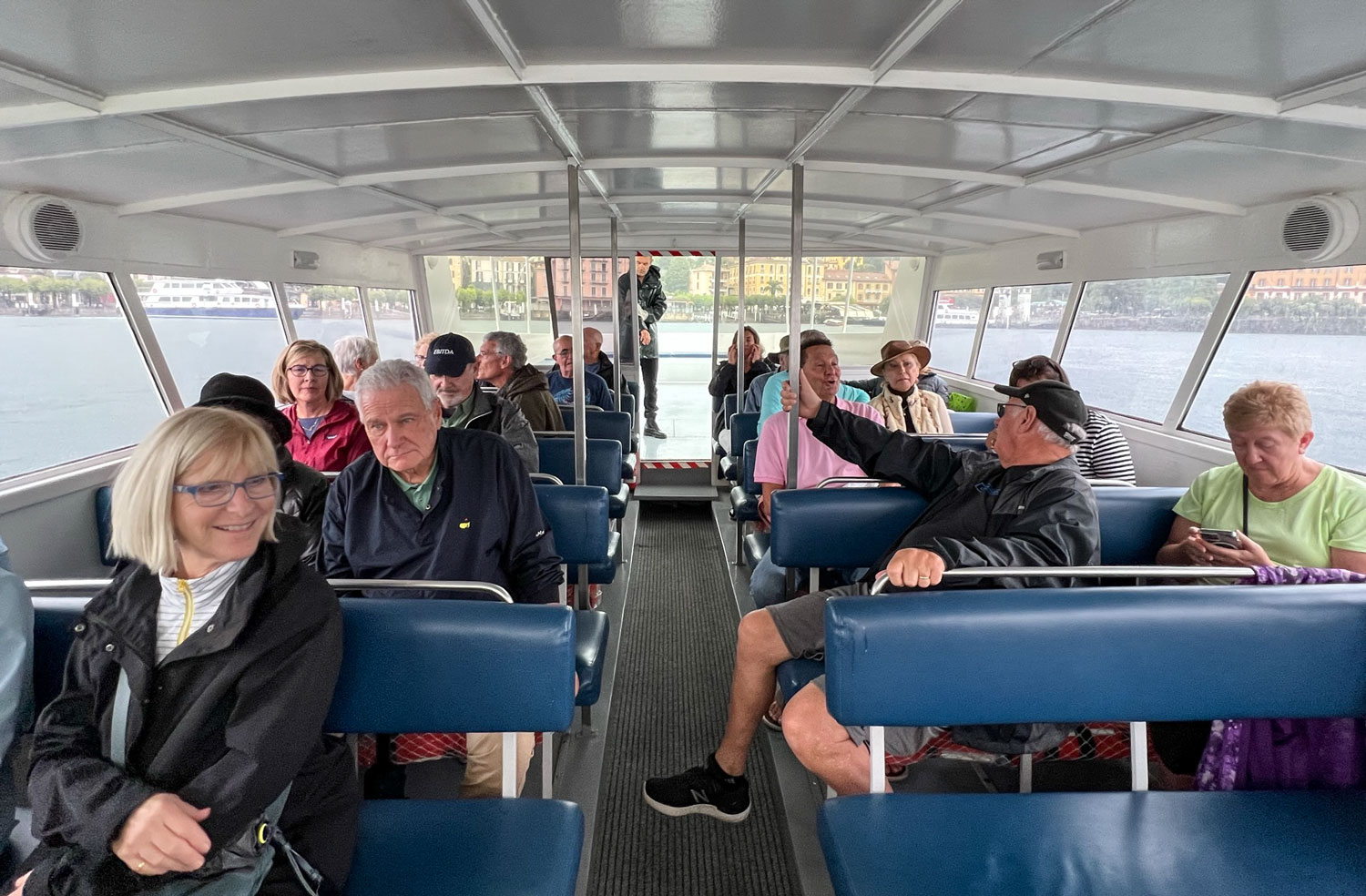
It was getting time for lunch, so we headed a short distance up the road to Menaggio to the Grand Hotel Menaggio for lunch.
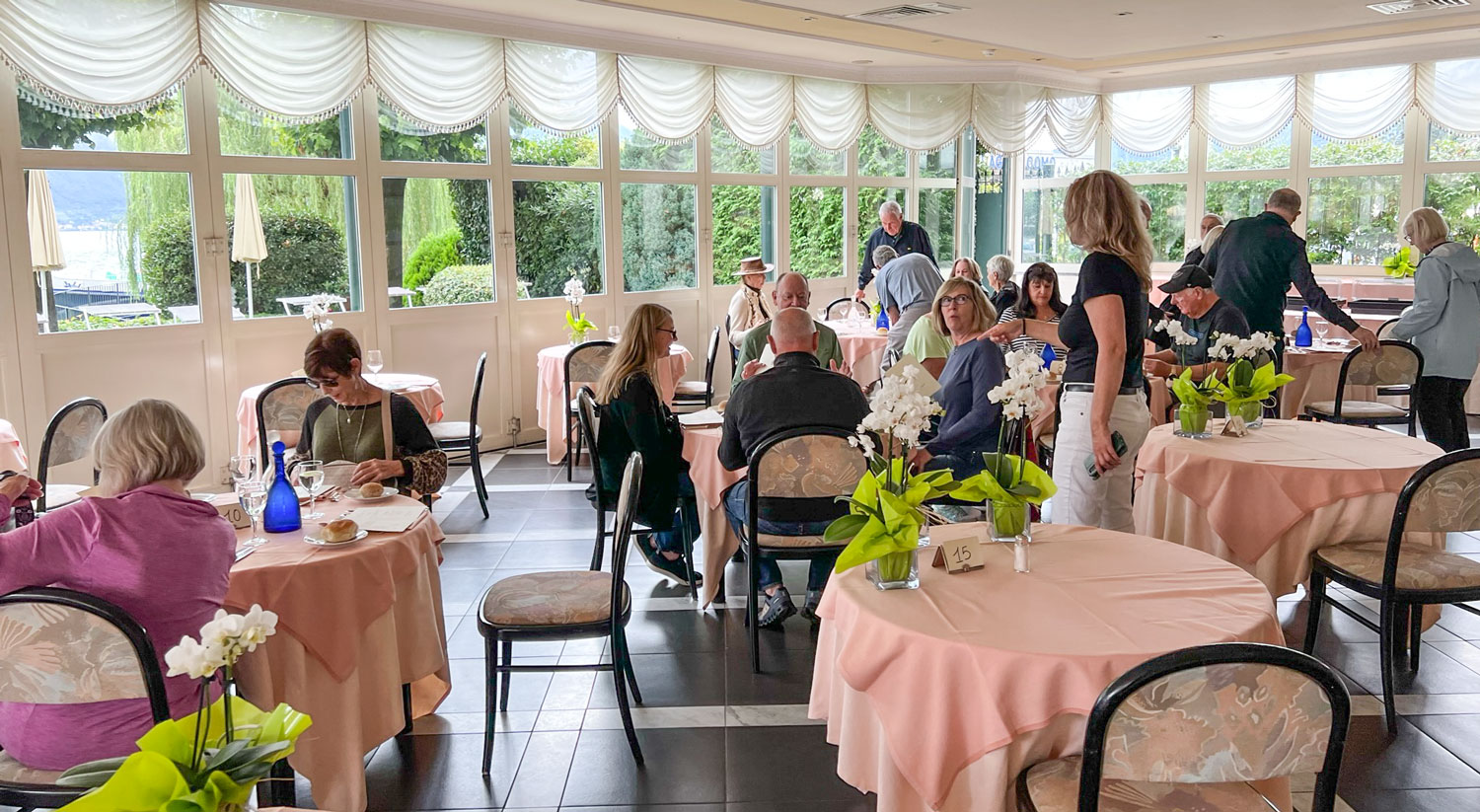
Peter was waiting for us when we finished lunch. I was amazed by Peter's ability to get the bus through some of the intersections and hotel driveways. He's actually sitting ahead of the front wheels so it often looks like he's going to run into something on a tight turn, but he always makes it.
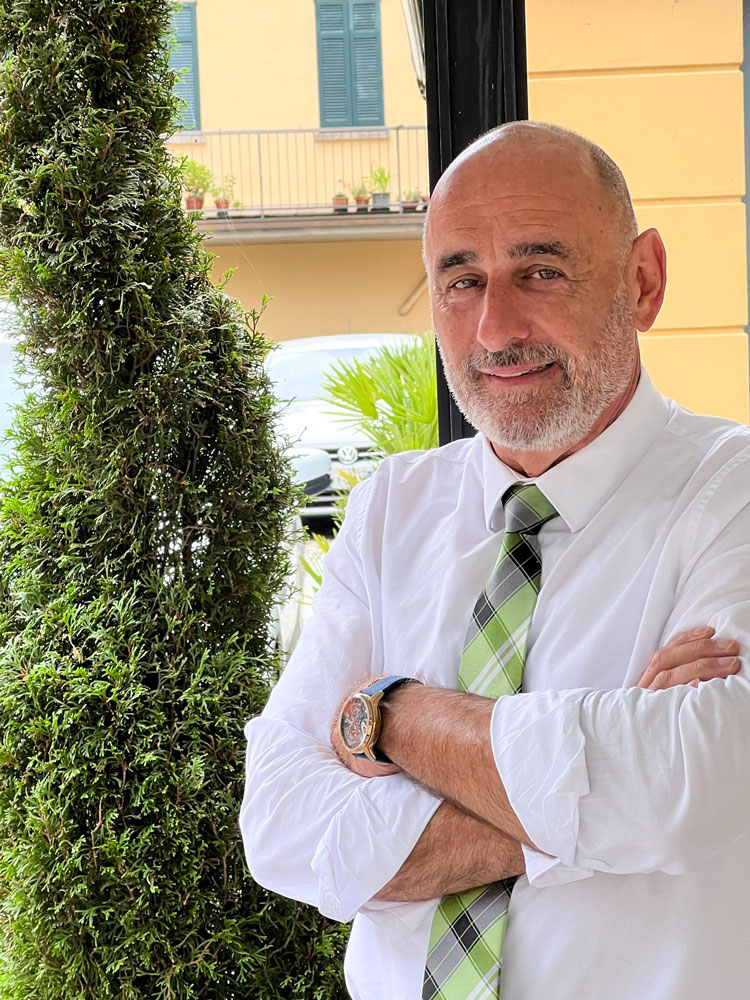
Soon we were back on the road to St. Moritz.
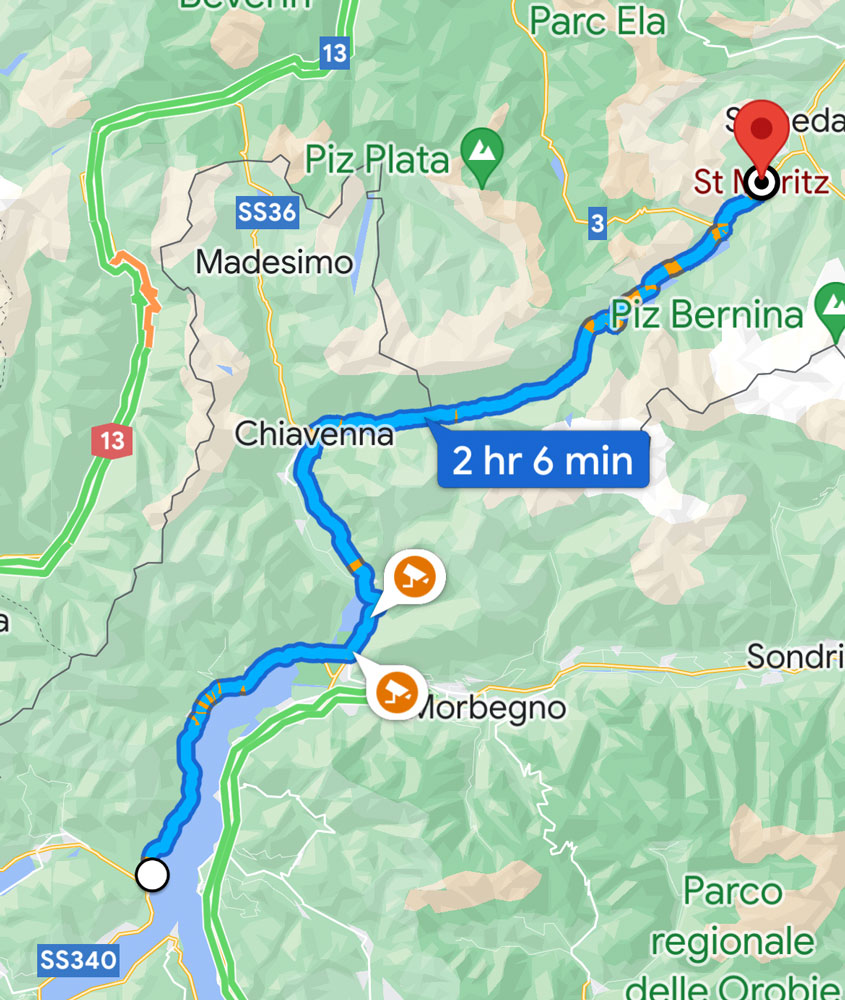
It was a long drive to St. Moritz, so we stopped in Chiavenne at a gelato place and Carrie treated each of us to a gelato.
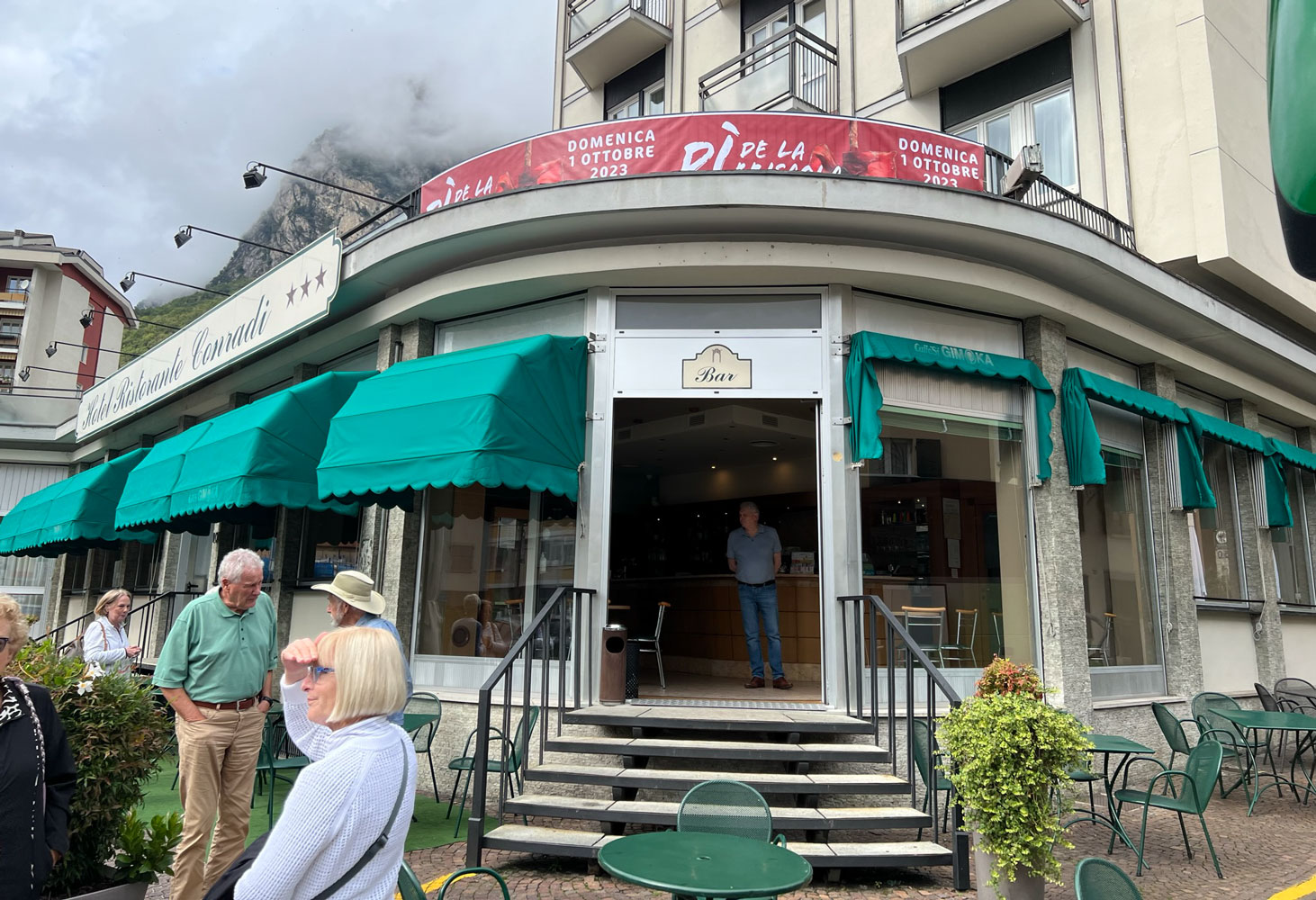
Along the way to St. Moritz, we went through the Maloja Pass. To ascend the pass, you go through a number of switchbacks. This picture only shows a few of the switchbacks on the road. Peter's remarkable driving skills were on full display.
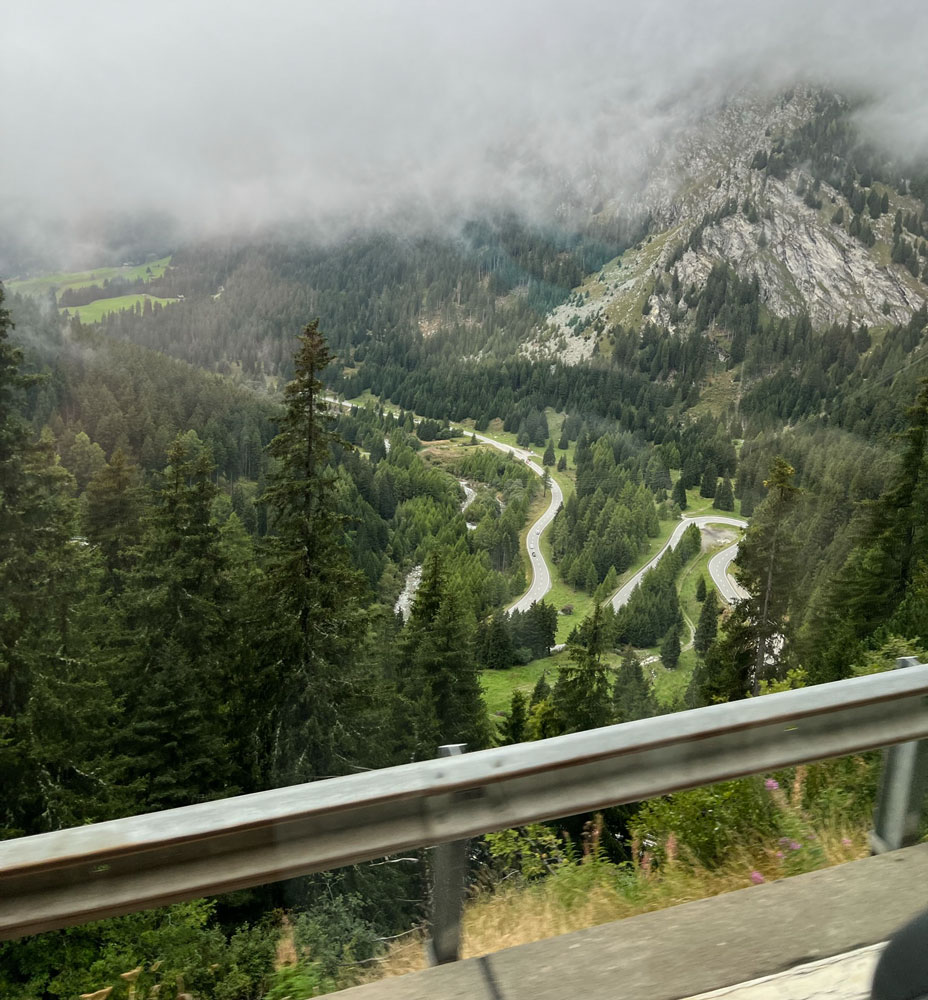
Here's an aerial shot of the road, taken from the web. The road goes goes up 1,486 meters, about 4,875 feet. At the top of the pass, we were about 6,000 feet.
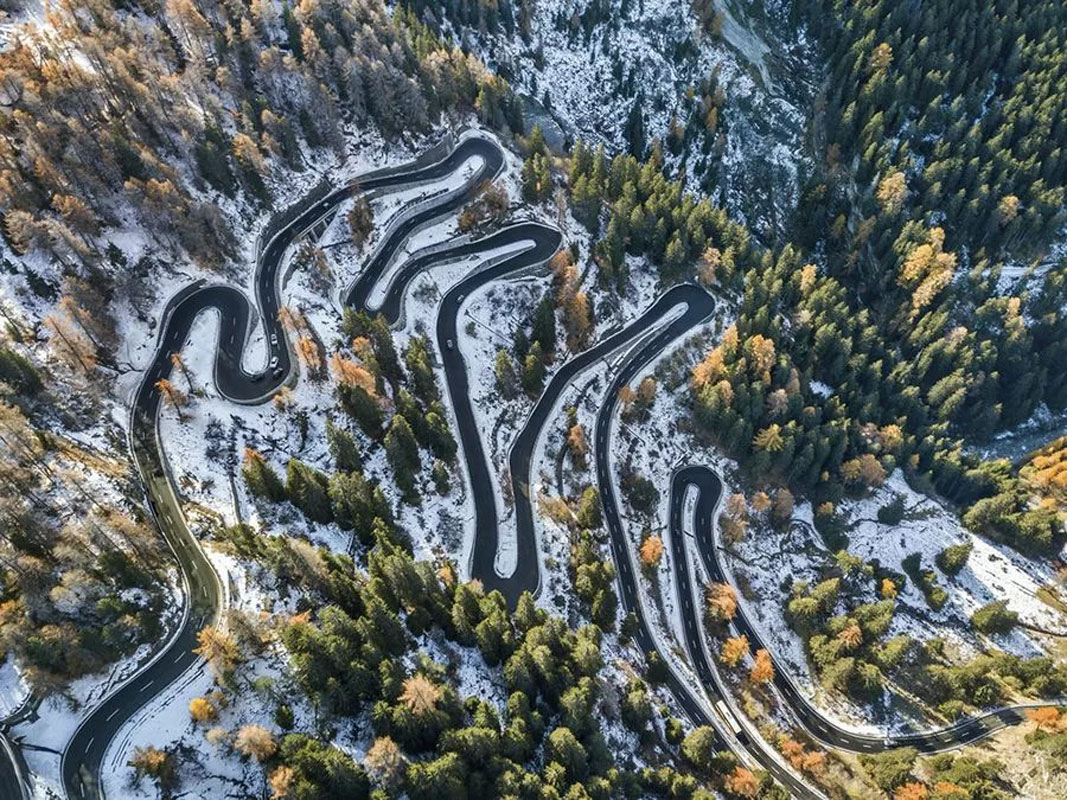
From the pass it was just a short ride to our hotel in St. Moritz, the Grand Hotel des Bains Kempinski. I didn't get a picture of the hotel, but here's one from their website.
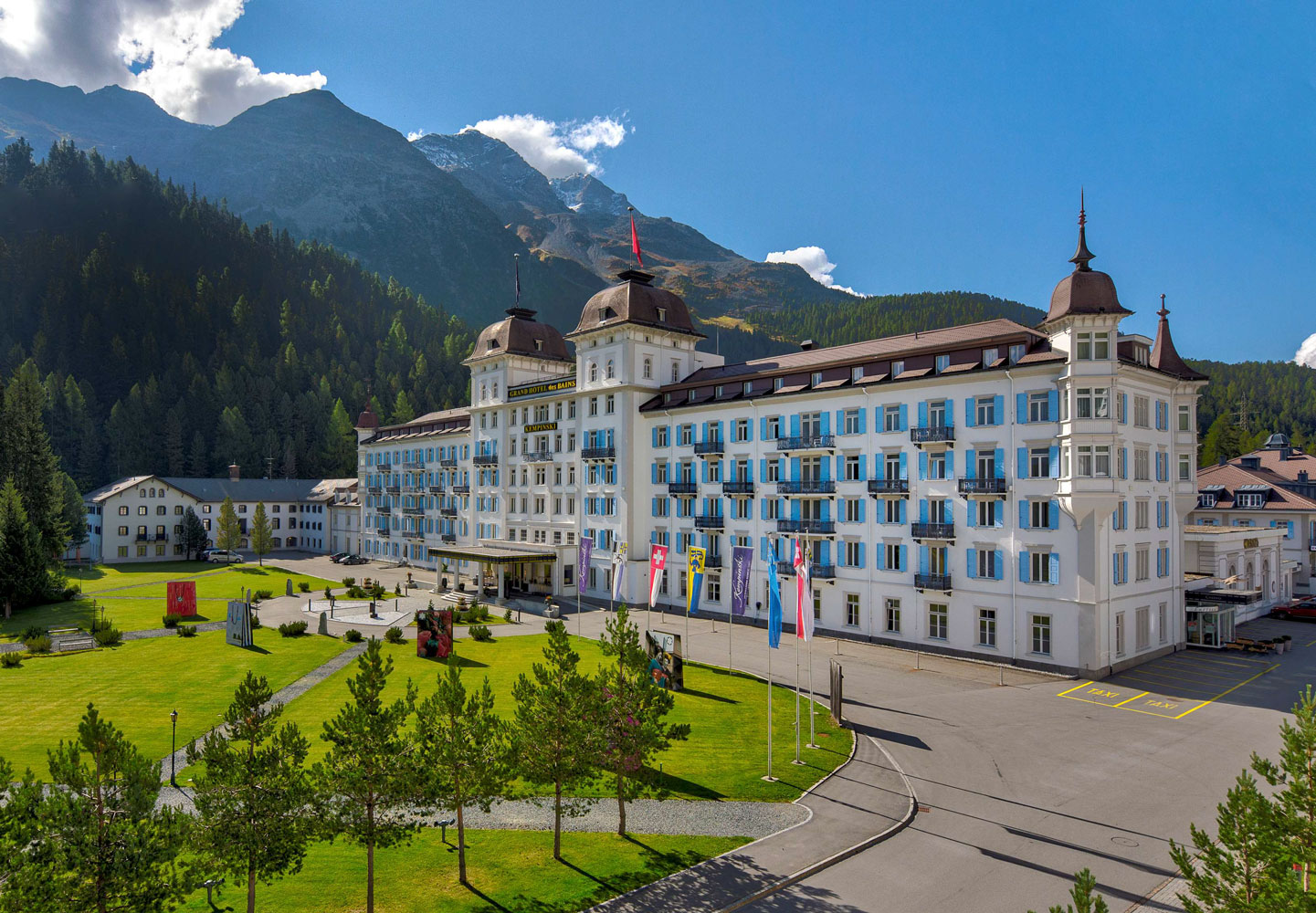
It was an elegant hotel, probably the best we've stayed at so far in Switzerland. It was about 4pm when we arrived, and we were to leave very early the next day so we didn't have a lot of time to enjoy the hotel.
They were hosting a car show of older sports cars on the lawn in front of the hotel.
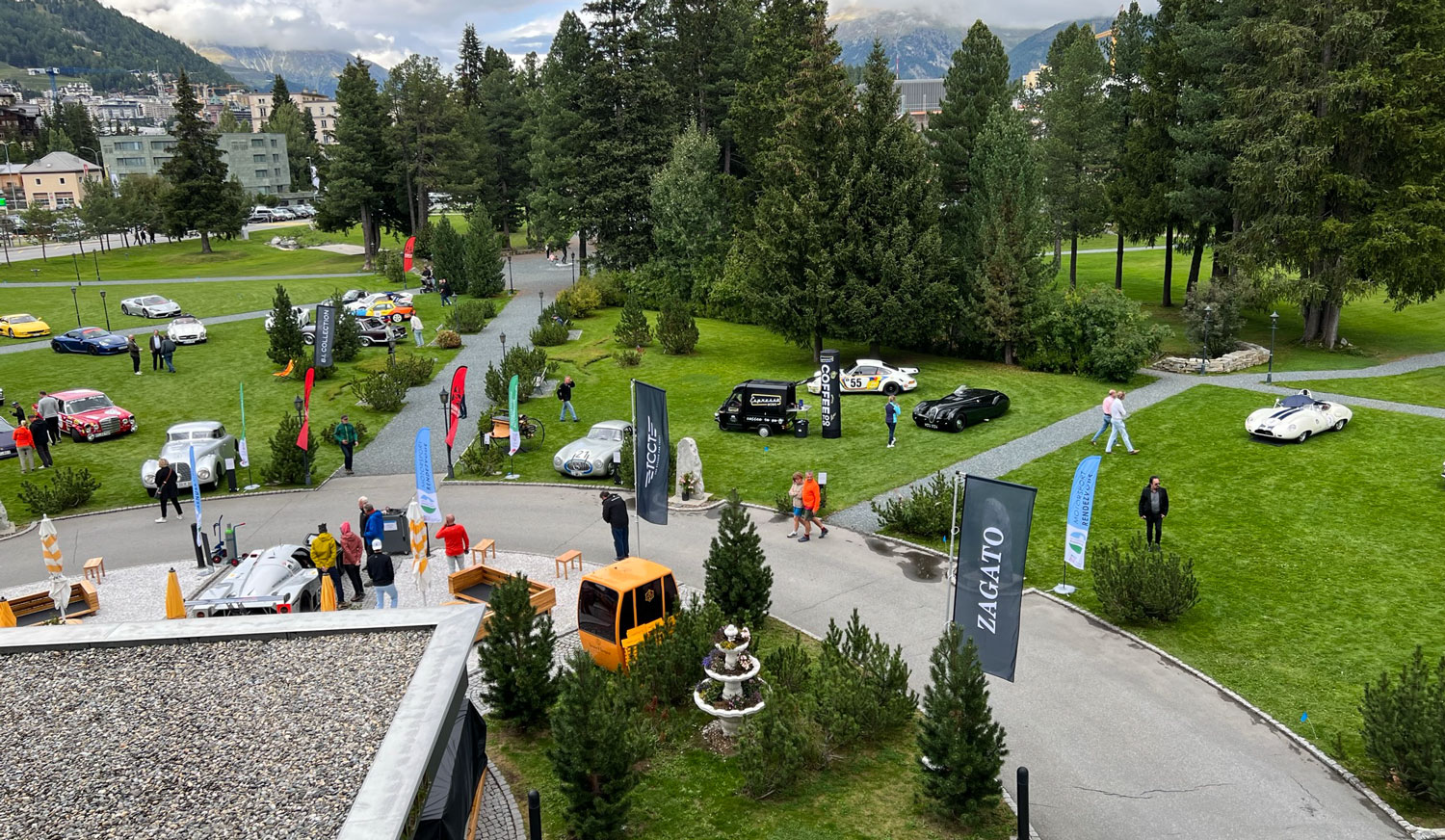
Our room faced out toward the front of the hotel (that's how I got the previous picture), and was very nice. It had lots of storage space, a walk-in shower, outlets by the bed (on the front of the nightstand), night lights, and very good Internet access.
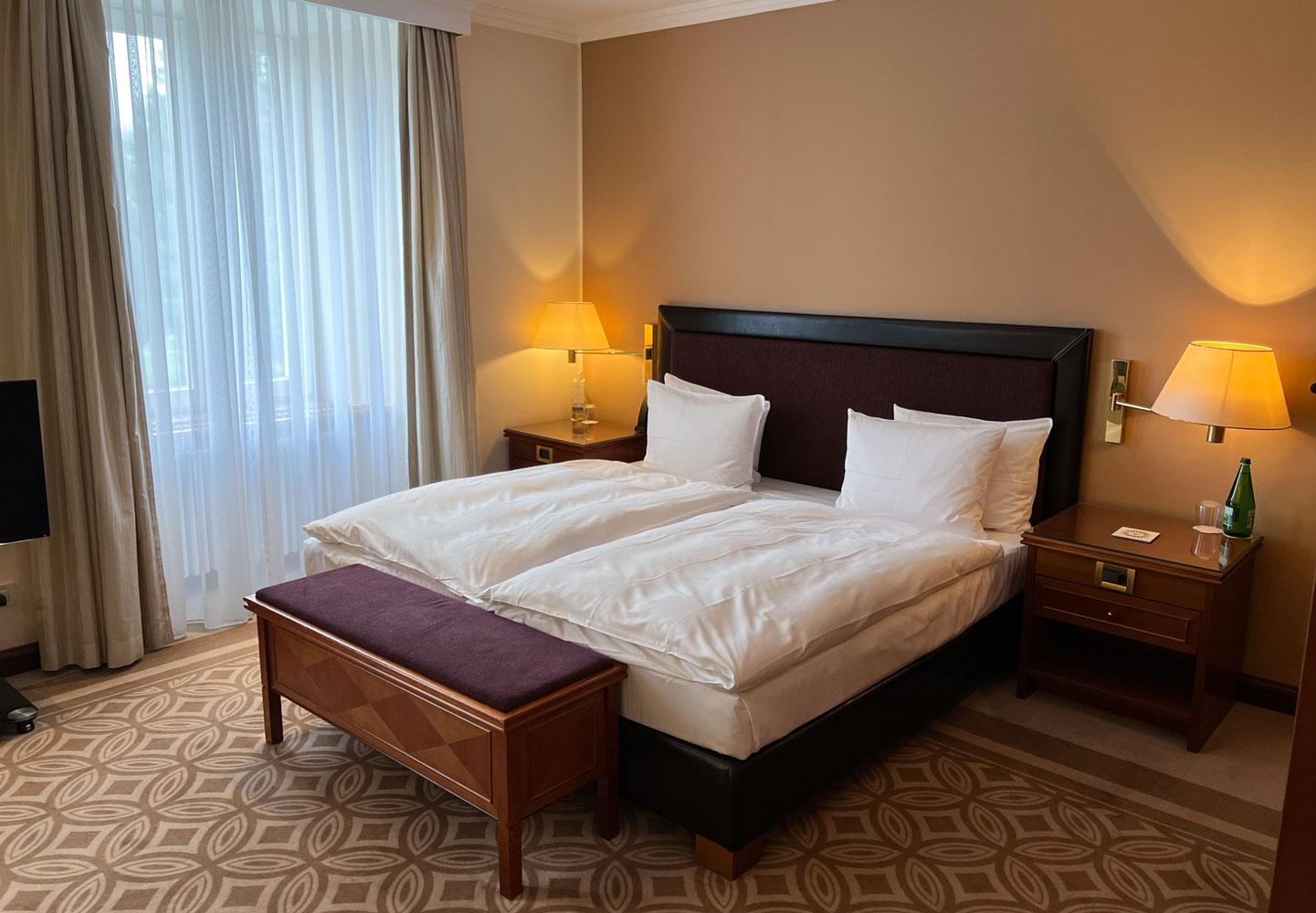
We had dinner in the hotel restaurant. The food was okay, but our waiter was very interesting. He has degrees in Hospitality and is working at this hotel to gain practical experience. His goal is to become the Minister of Tourism in the Dominican Republic, his home country. His English is perfect.
+++++++++++++++++++++++++++++++++++++++++
9/16/2023 (Saturday) We have a 6am departure this morning to get to the Glacier Express train. We boarded the bus while it was still dark. The hotel had prepared a breakfast bag for each of us, and had coffee and pastries in the lobby for us before we left.
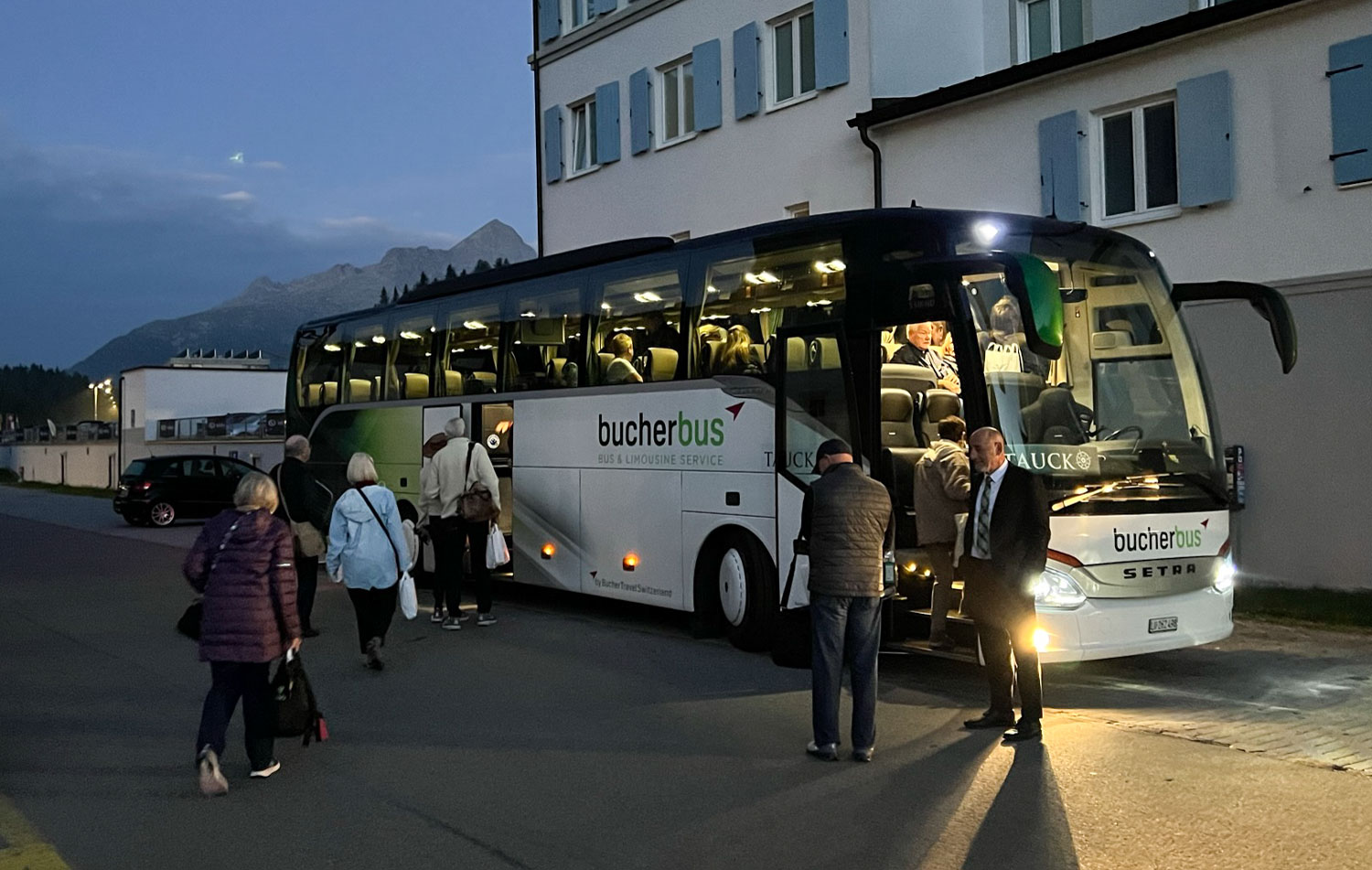
It was a very short ride to the St. Moritz train station. Here we are waiting to board the train. The Glacier Express is a narrow gauge train (1 meter track) and uses center buffer and chain coupling. It's possible to go all the way to/from Zermatt/St. Moritz but we're going to only go from St. Moritz to Andermatt.

Just a view of the train.
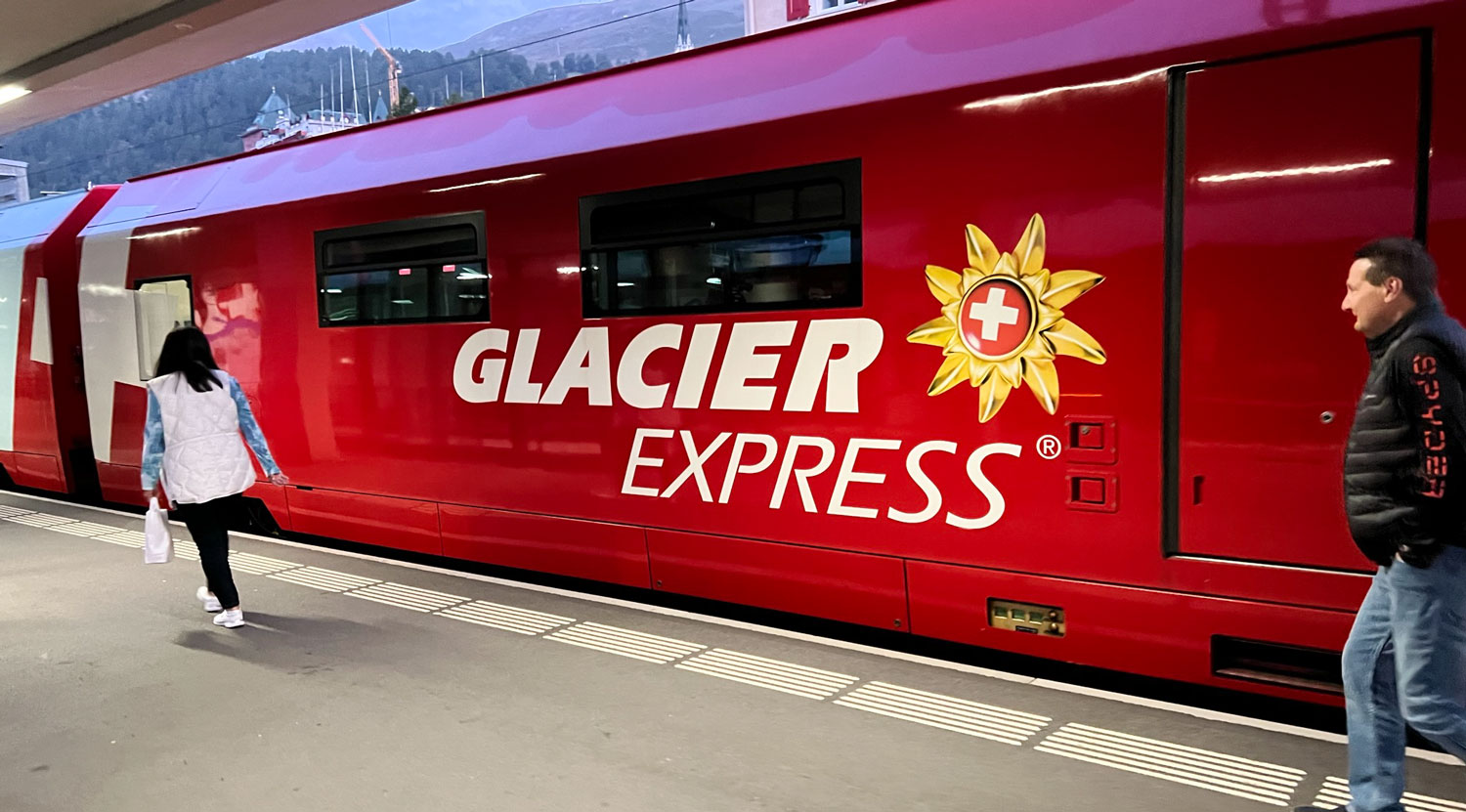
You can see our route on this map. We leave from St. Moritz and go to Chur, which is actually the end of the line. Then, they move the engine from the front of the train to the "back" and we depart Chur heading to Andermatt, where we'll meet the bus again.
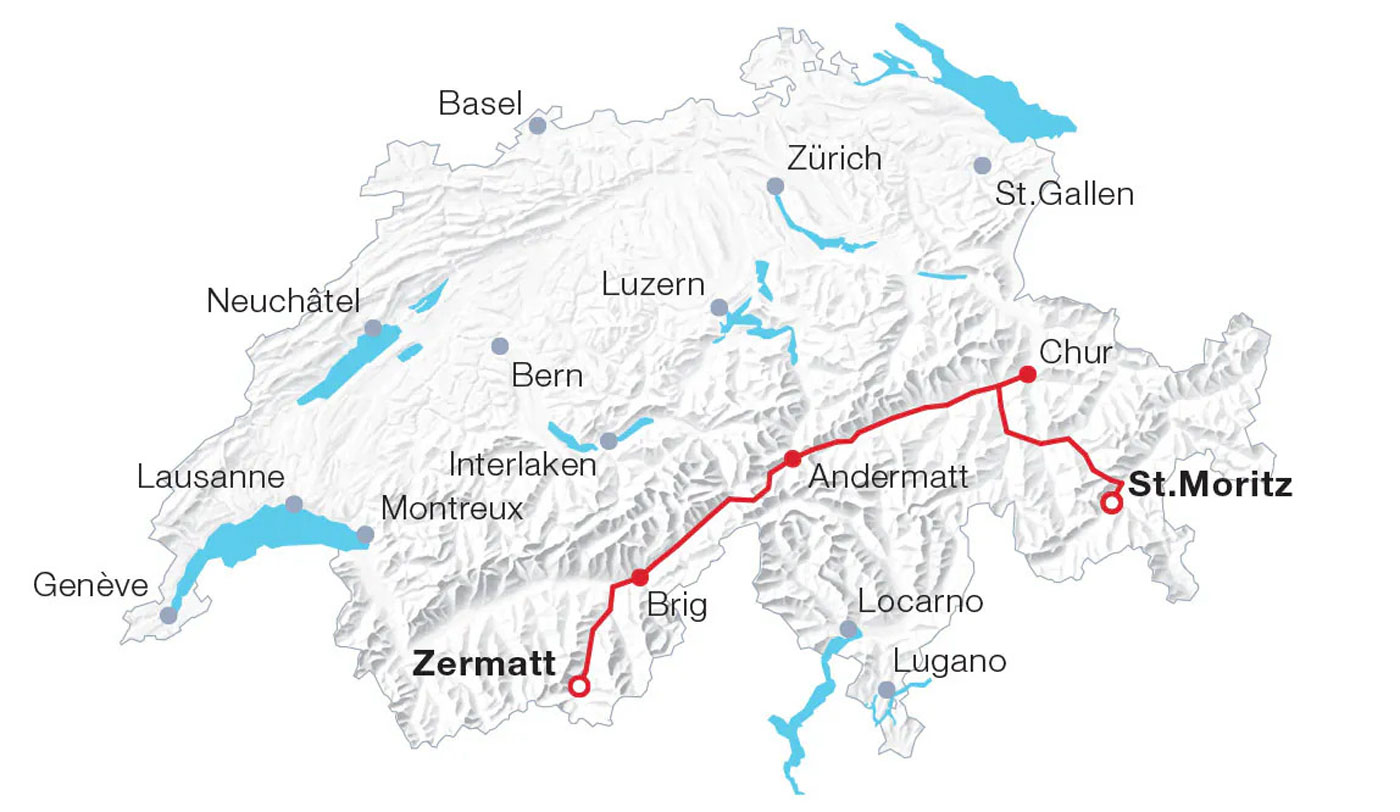
There was a lot of interesting scenery as we rode along, but it was very difficult to get good pictures because of the speed of the train and the reflections in the windows.
Eventually, we came to the Landwasser Viaduct, which is the "photo op" of the route from St. Moritz to Chur. But it was almost impossible to get a good picture of the viaduct from the train. Here's what I took, which only shows a part of the viaduct, and has a lot of reflections.
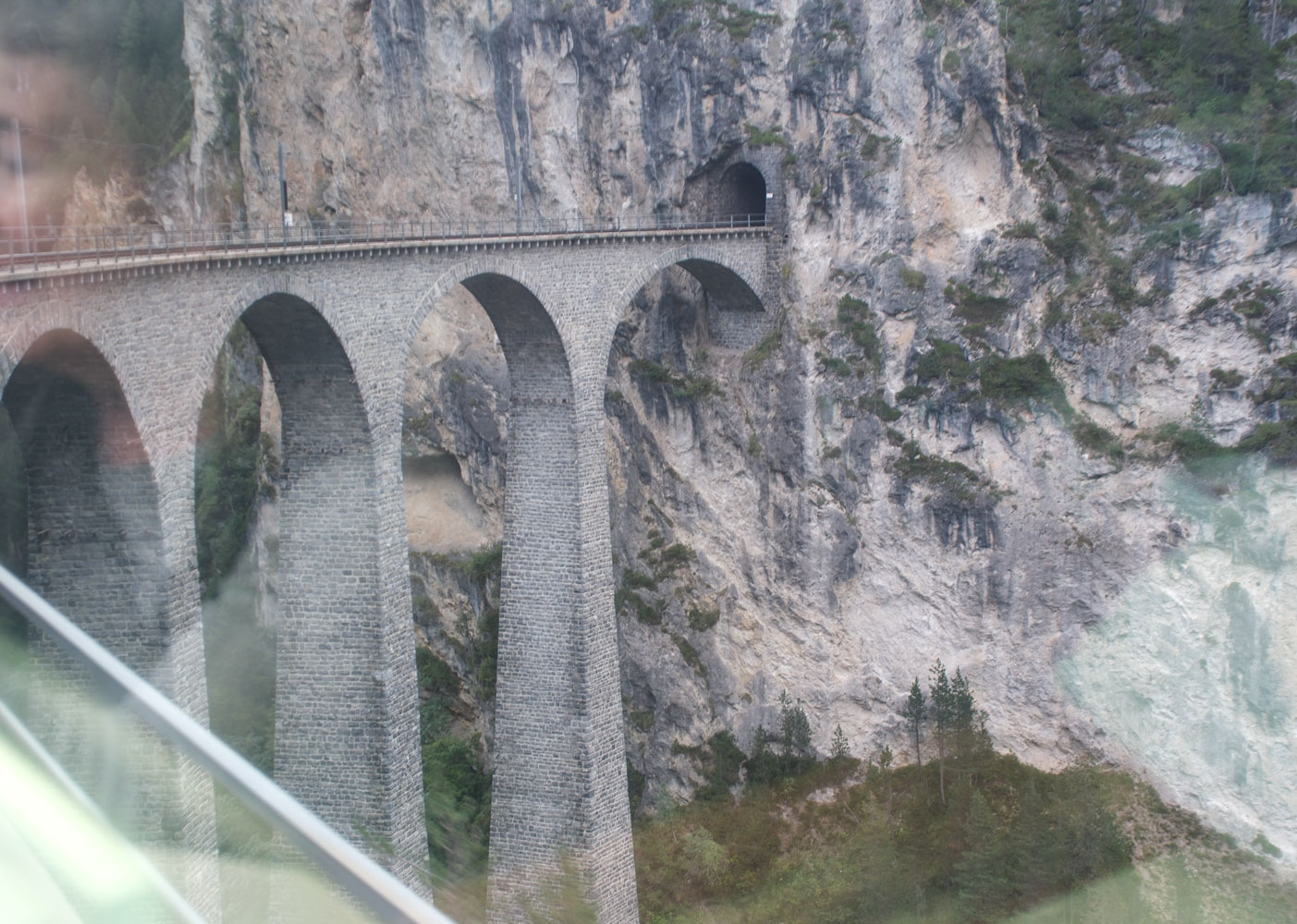
I went on the web looking for a better picture, and found these two, one looking from each side of the viaduct.
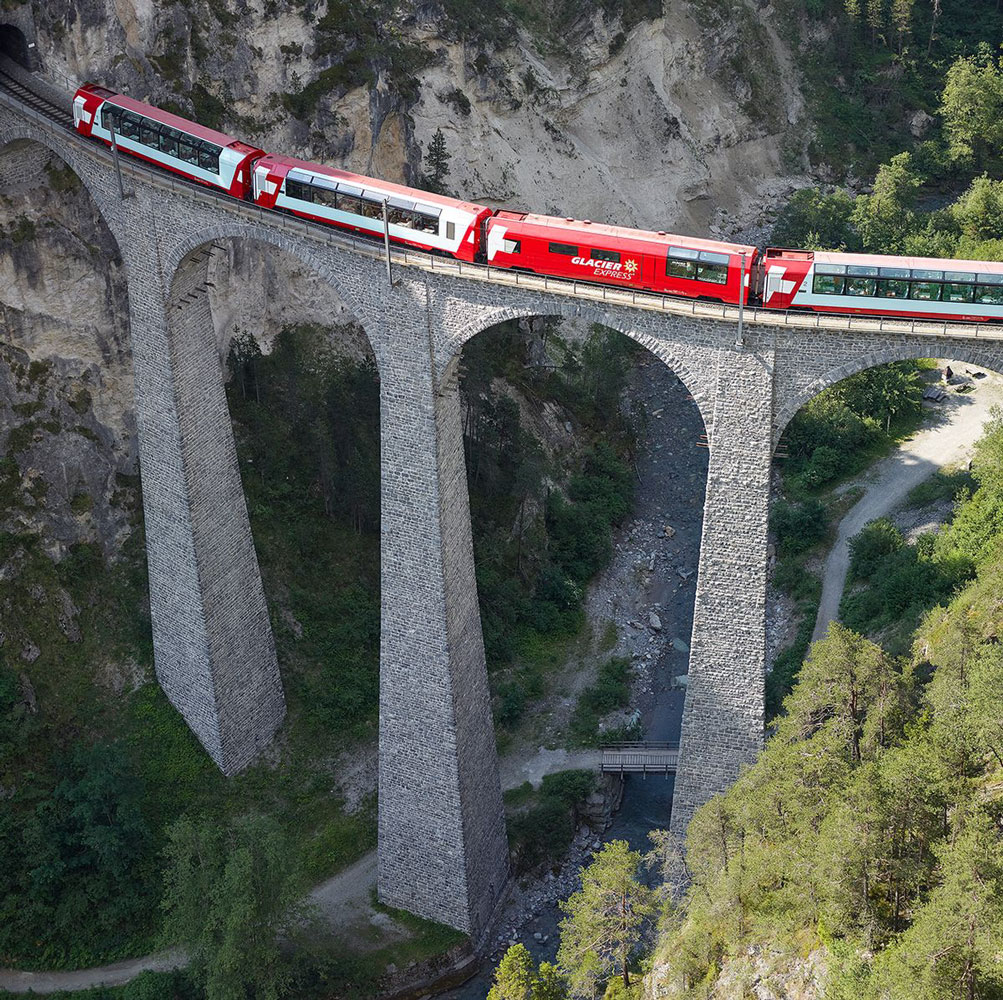

Eventually we arrived in Chur and had some time to get out in the air while they hooked an engine on the opposite end of the train.
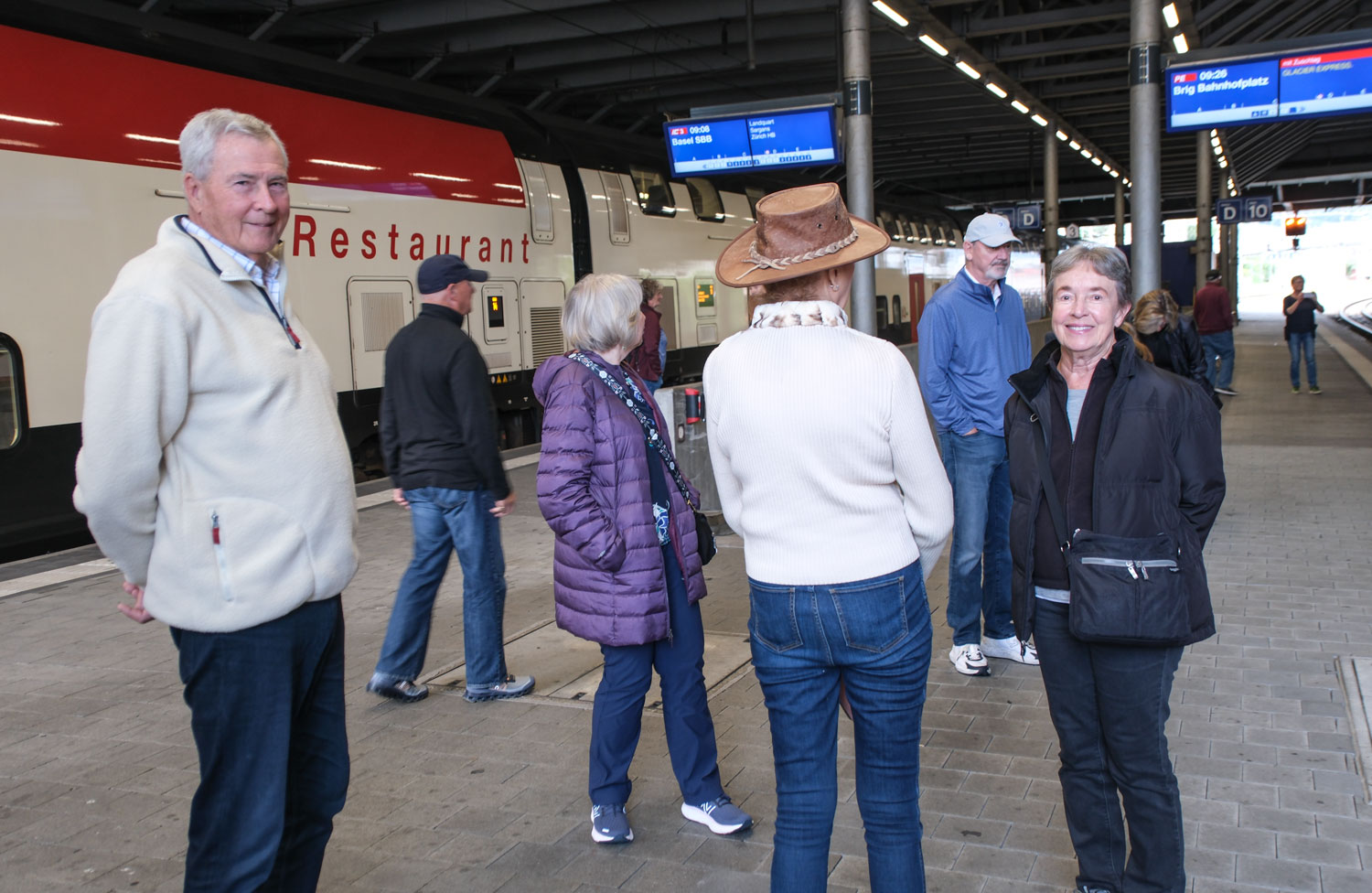
Here's the engine coming to be hooked up.
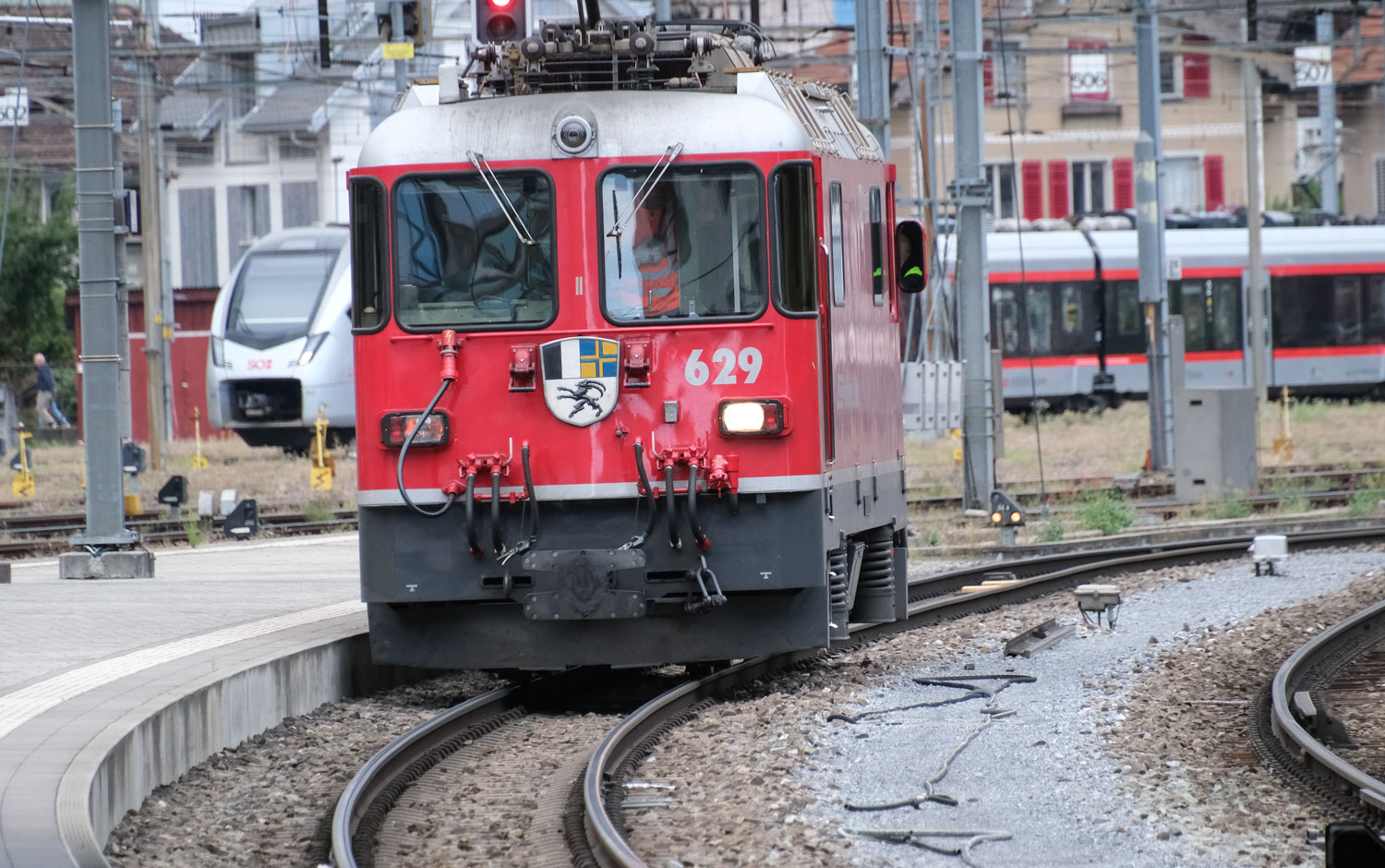
And two trainmen ready to get everything - power, air, and the connection mechanism - hooked up.
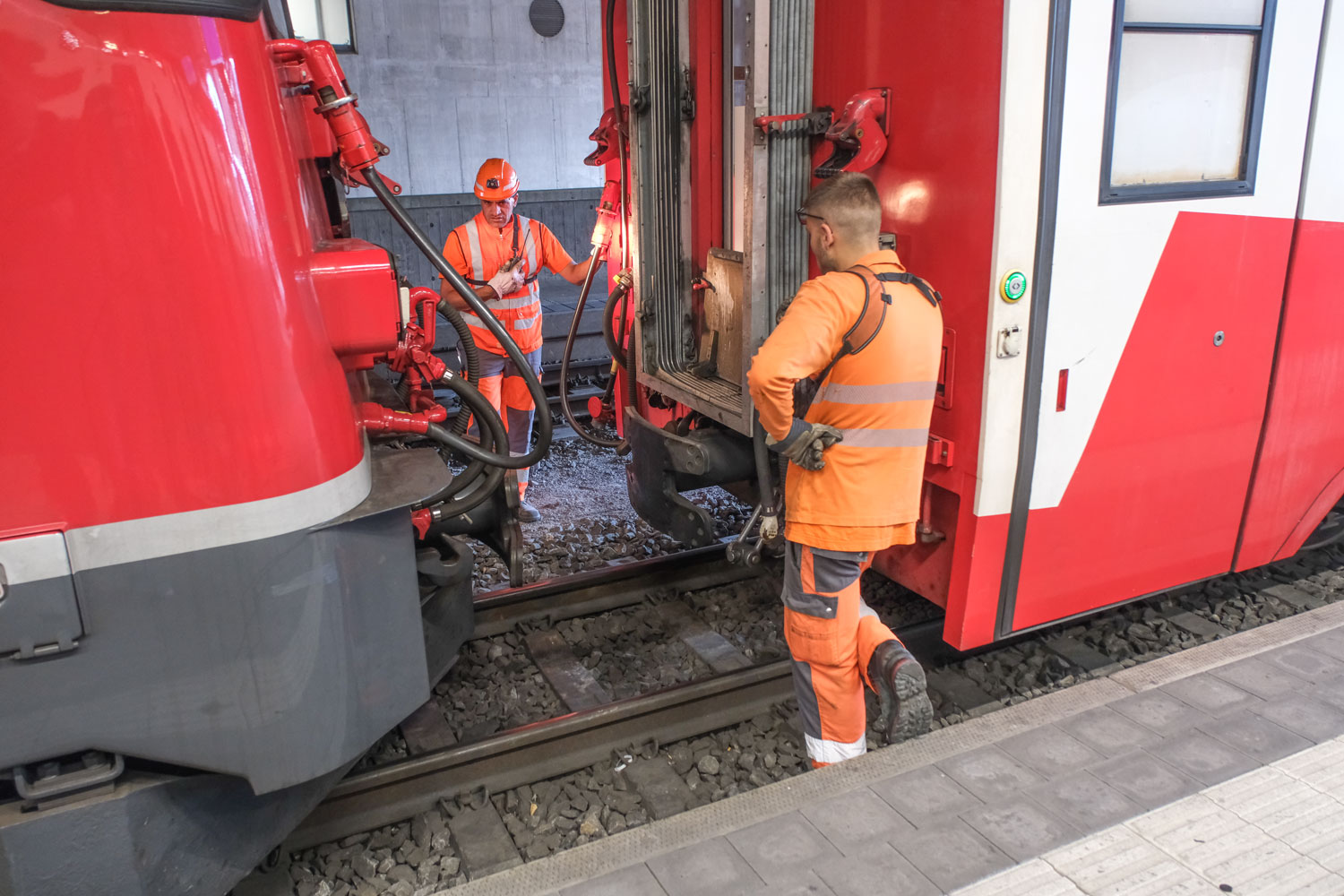
Soon we were off for Andermatt. I didn't get any interesting pictures during the trip, but we had lunch of chicken stroganoff on the train. Just a side note, while there's a lot of interesting scenery, there are no glaciers on this train ride.
Past Andermatt (toward Zermatt), the train used to climb to the Furka Pass and would go close to the Rhône Glacier. But now, it bypasses the Furka Pass and takes the Furka Base Tunnel. The Furka Pass would snow in during the winter and travel in the Glacier Express would be cancelled in winter. With the Furka Base Tunnel, they can run the train all year long.
Peter was waiting at Andermatt for us and we headed to Interlaken, about a two hour drive.
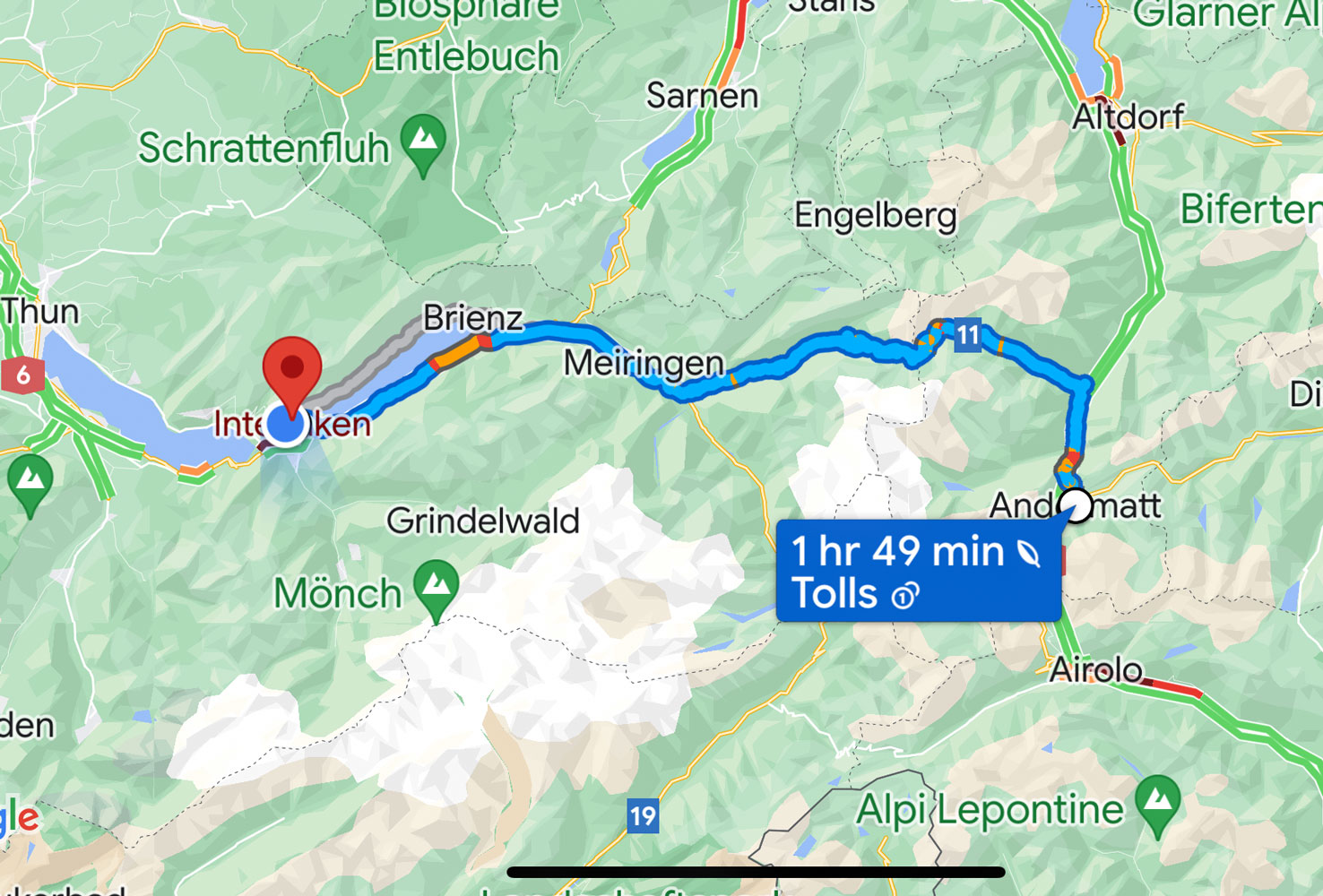
Along the way, we stopped in Altdorf to see the statue of William Tell.
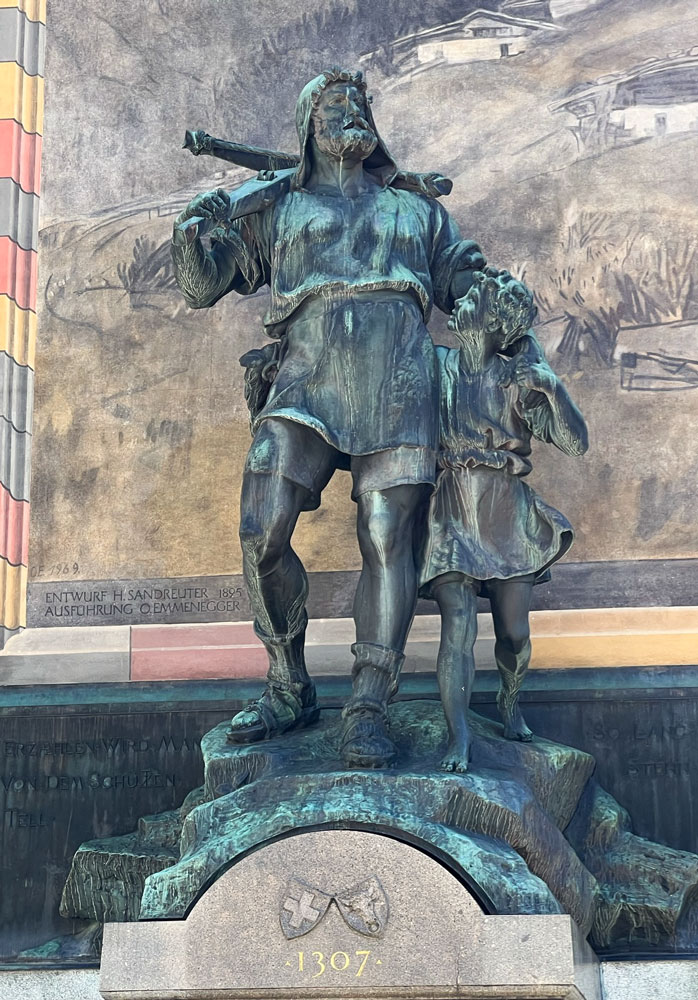
It was just a short stop, and then we continued to Interlaken. Along the way, we had a restroom stop in Alpnachstad about 1:45pm, where you can catch the Pilatus Railway, the steepest track railway in the world, with a maximum gradient of 48%. (Gradient is calculated by taking the rise over the run and multiplying by 100. So, 48% means that the track rises 0.48 meters for every 1 meter in horizontal length. If the track was at a 45 degree angle the gradient would be 100%.) The track leaving the station is pointed to by the black arrow. We didn't take a ride on the railway.
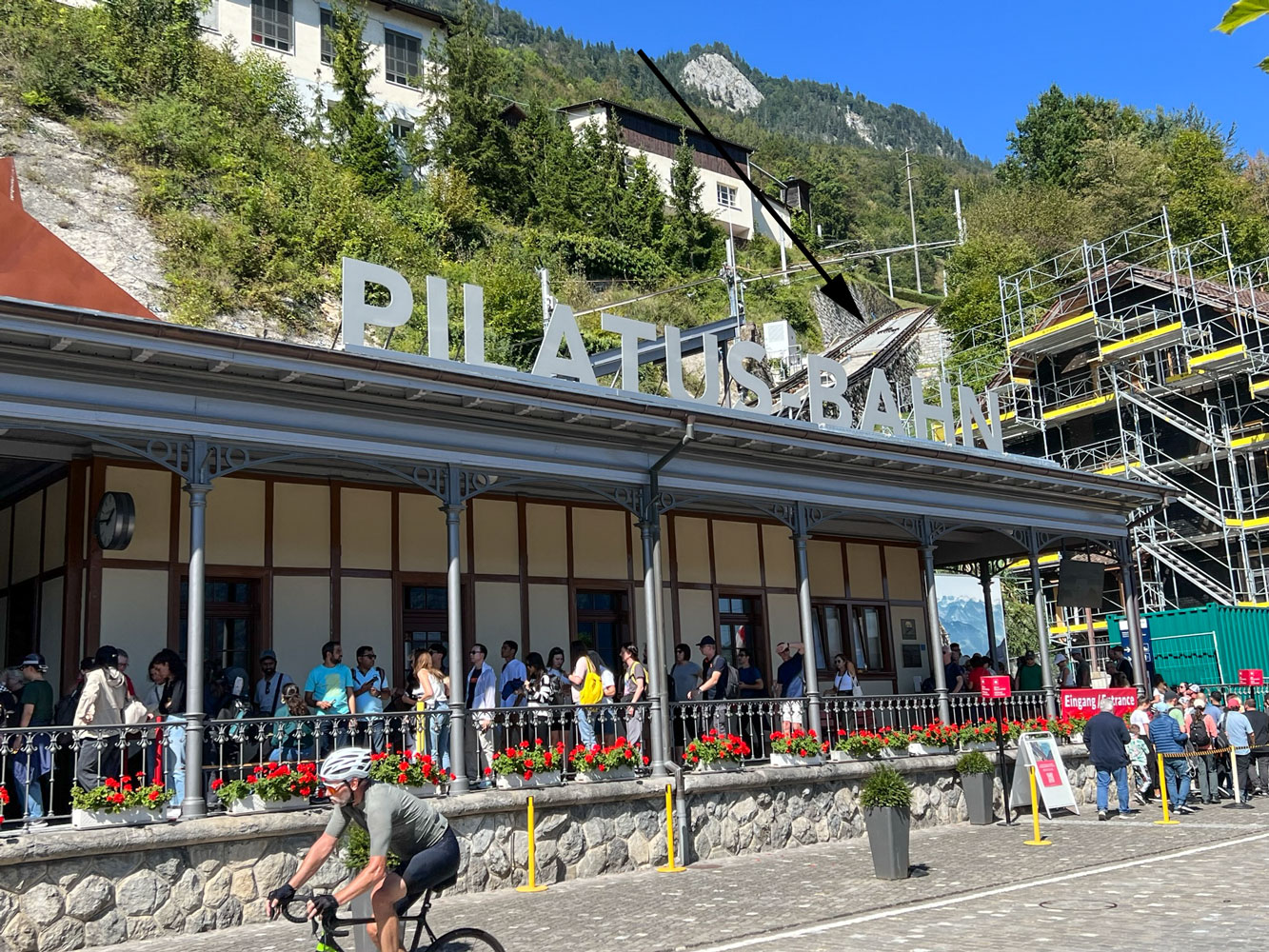
For those who are interested, this cog railway uses a different cog system because of the high gradient. A standard cog system (Strub System) has the driving cog wheel vertical. But on a high gradient, the driving wheel can disengage from the rack. The system used on this railway uses two horizontal driving wheels (Locher System) to the rack. The cog wheels also have flanges on their lower side which prevent the wheels from disengaging from the rack.
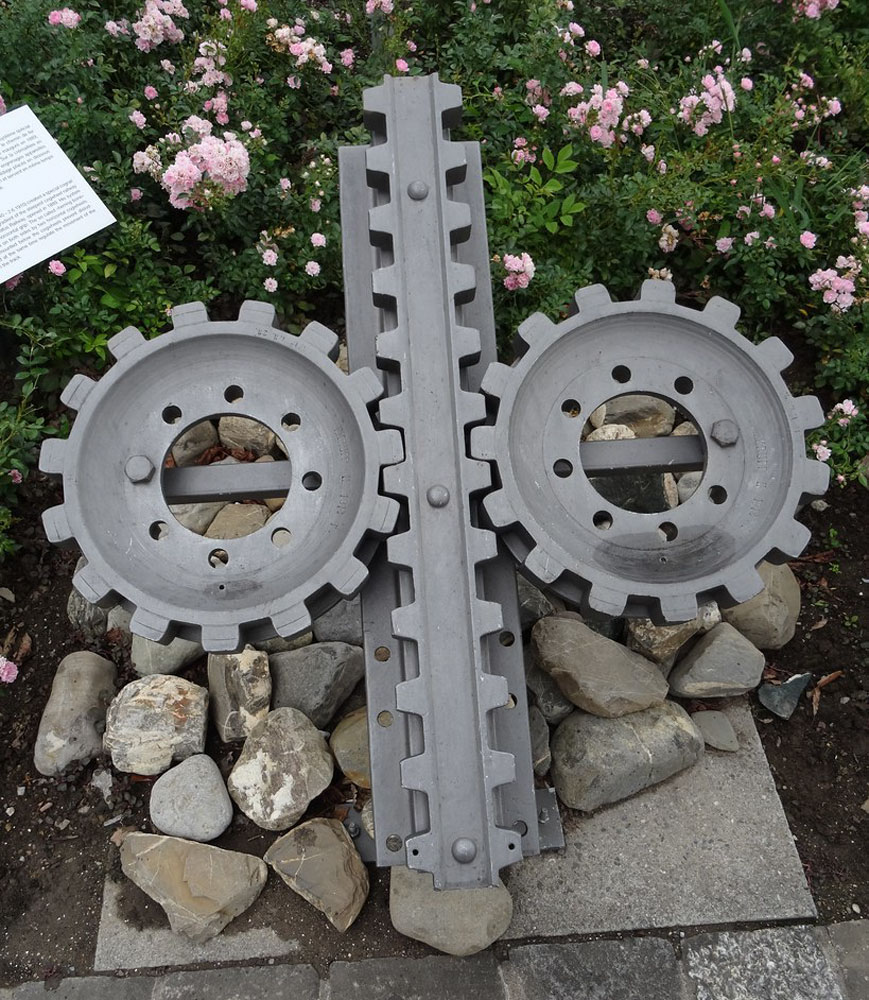
We arrived at the Victoria-Jungfrau Grand Hotel & Spa about 3pm. It's a nice hotel, very modern.
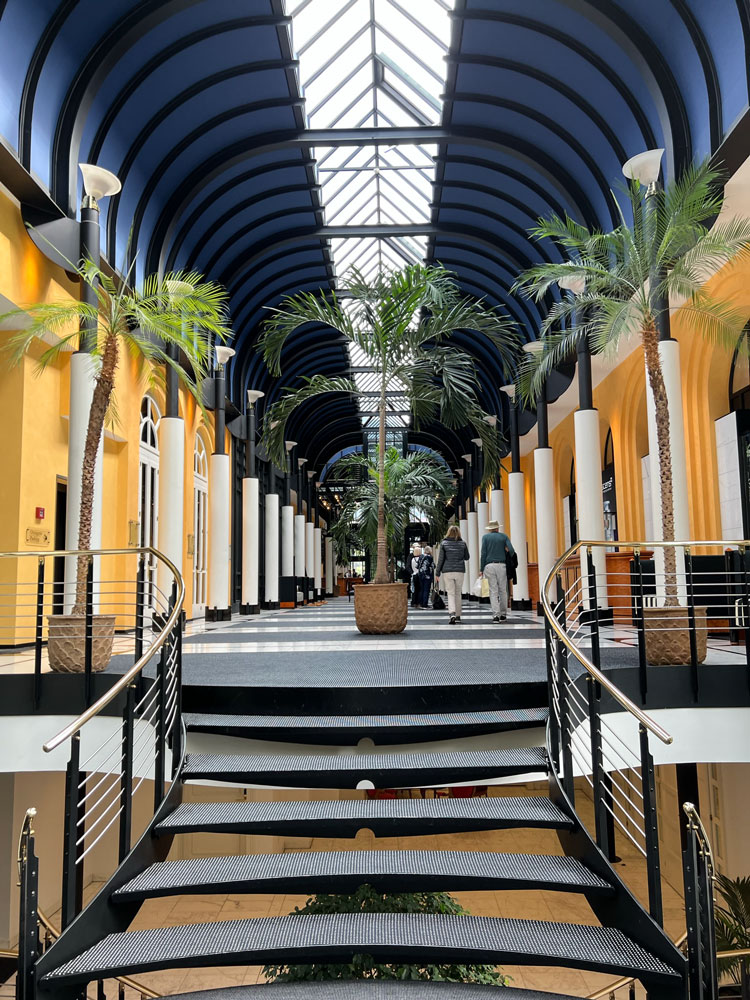
We have a large room, somewhat divided into a sitting area and a bedroom. It has good Internet access and a walk-in shower, so it meets my needs:-)
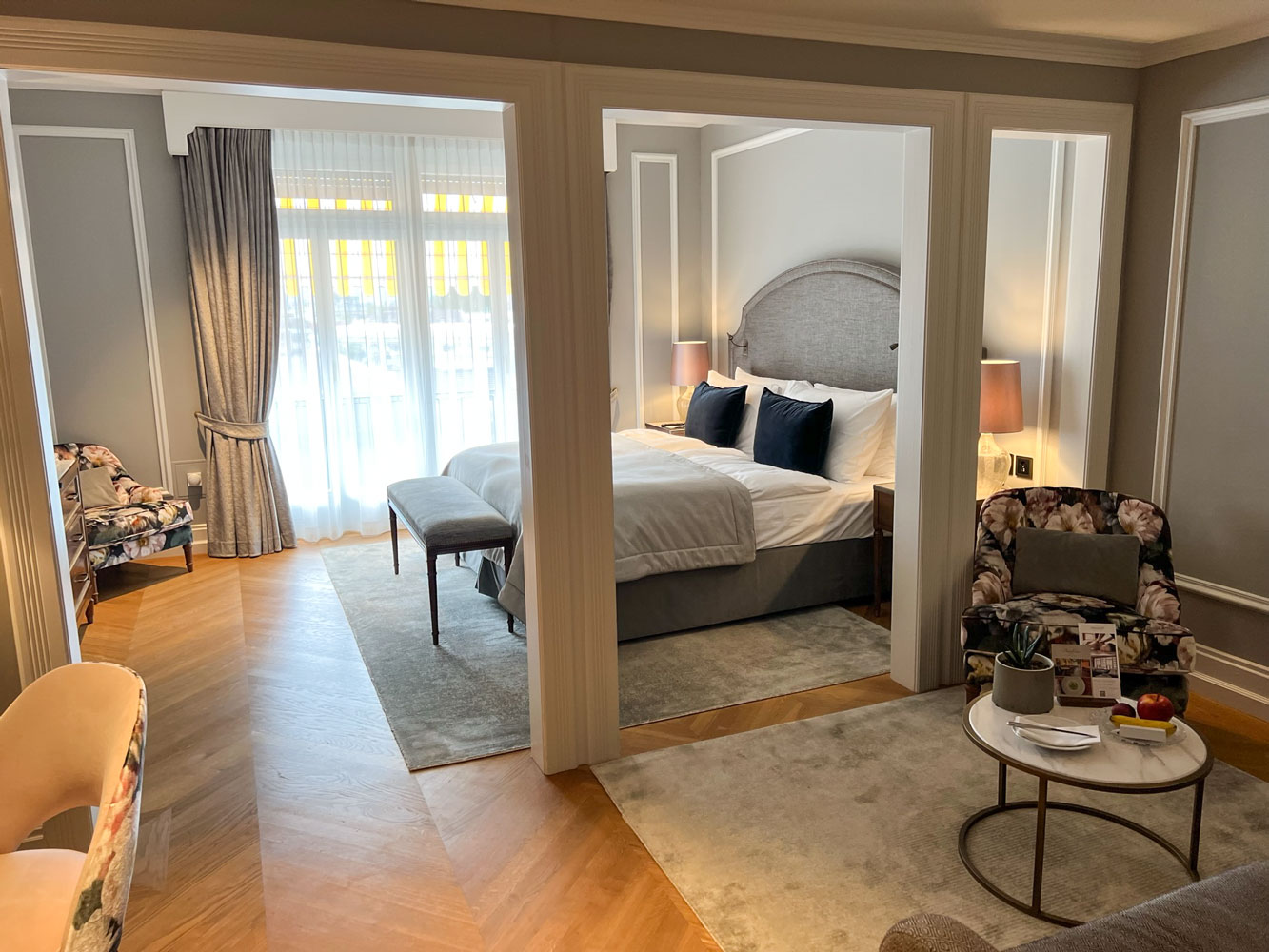
We didn't have a lot of time to rest because we had reservations at the Panorama Restaurant, Harder Kulm at the top of the Harderbahn Funicular. The funicular has a significant lift. At the base, it's about 1,900 feet and at the top about 4,300 feet, a lift of 2,400 feet. It can be steep - Wikipedia reports that the maximum incline is 64 degrees.
We walked to the Harderbahn. Here's the lower station. There were lots of people waiting to go up, but we had a reserved time and were able to avoid the line.
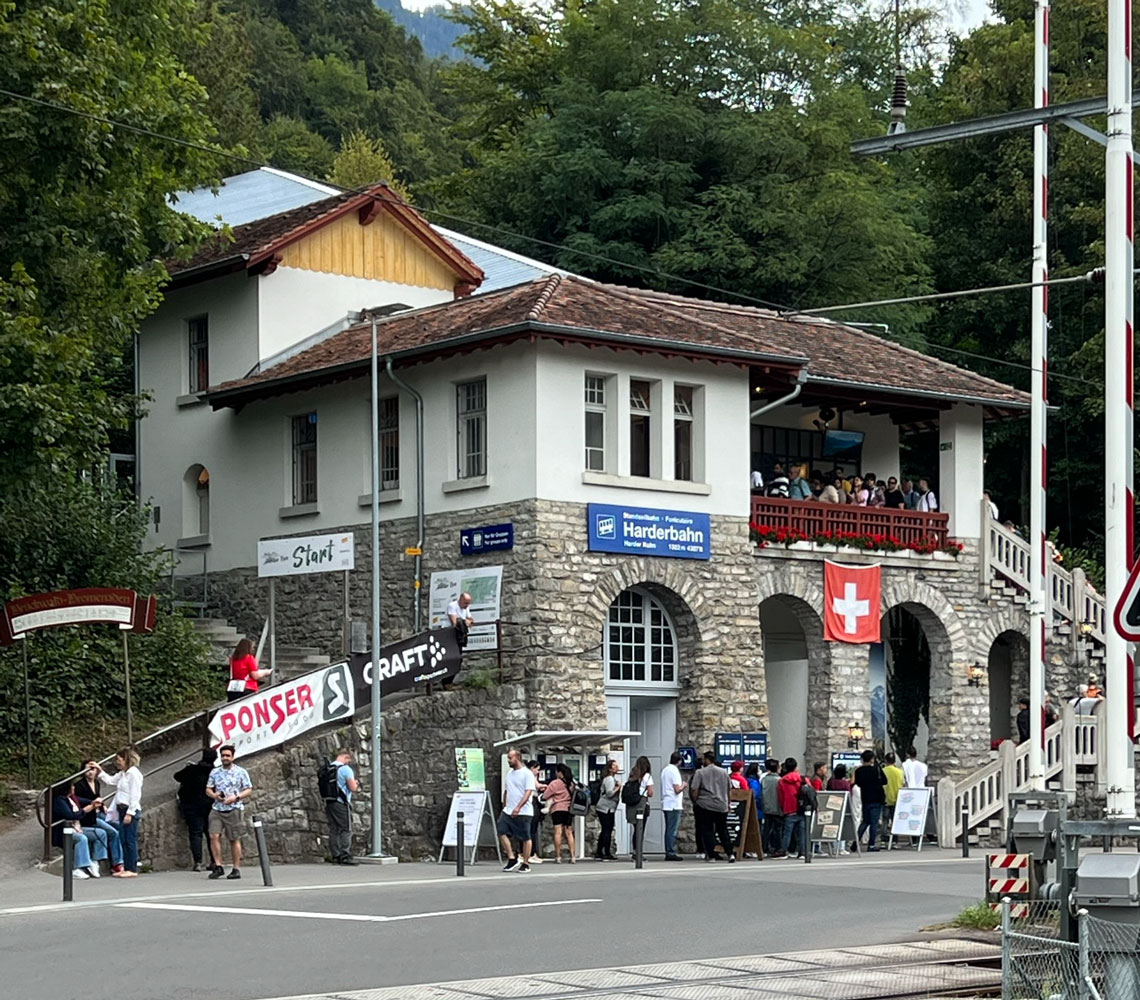
Here's one of the cars coming into the lower station.
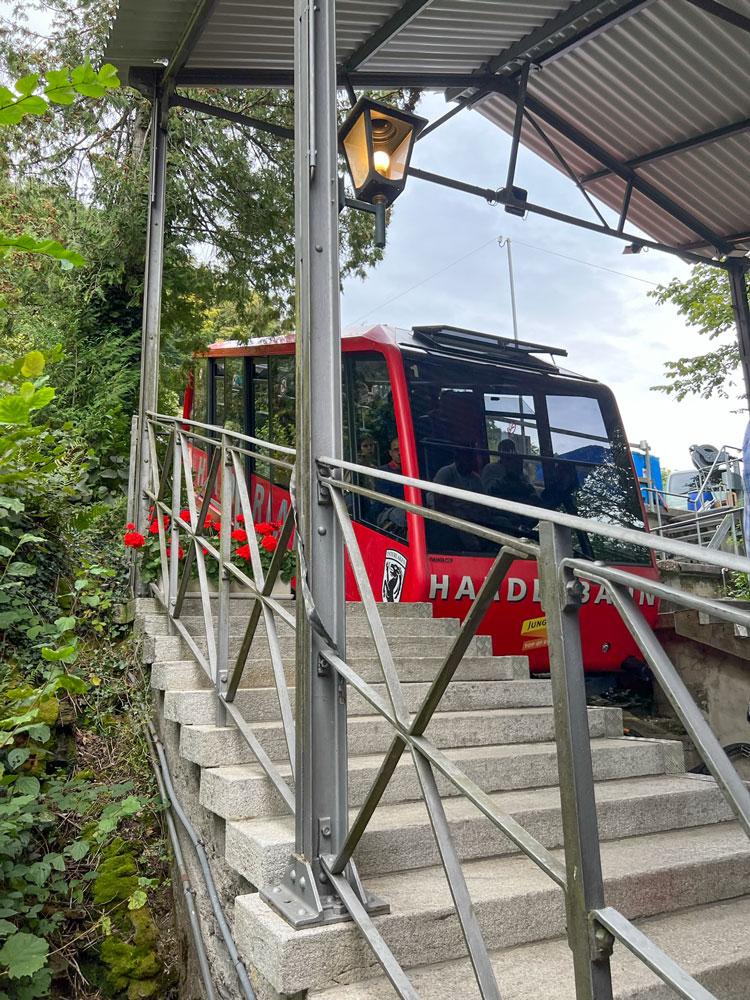
Very soon we were off.
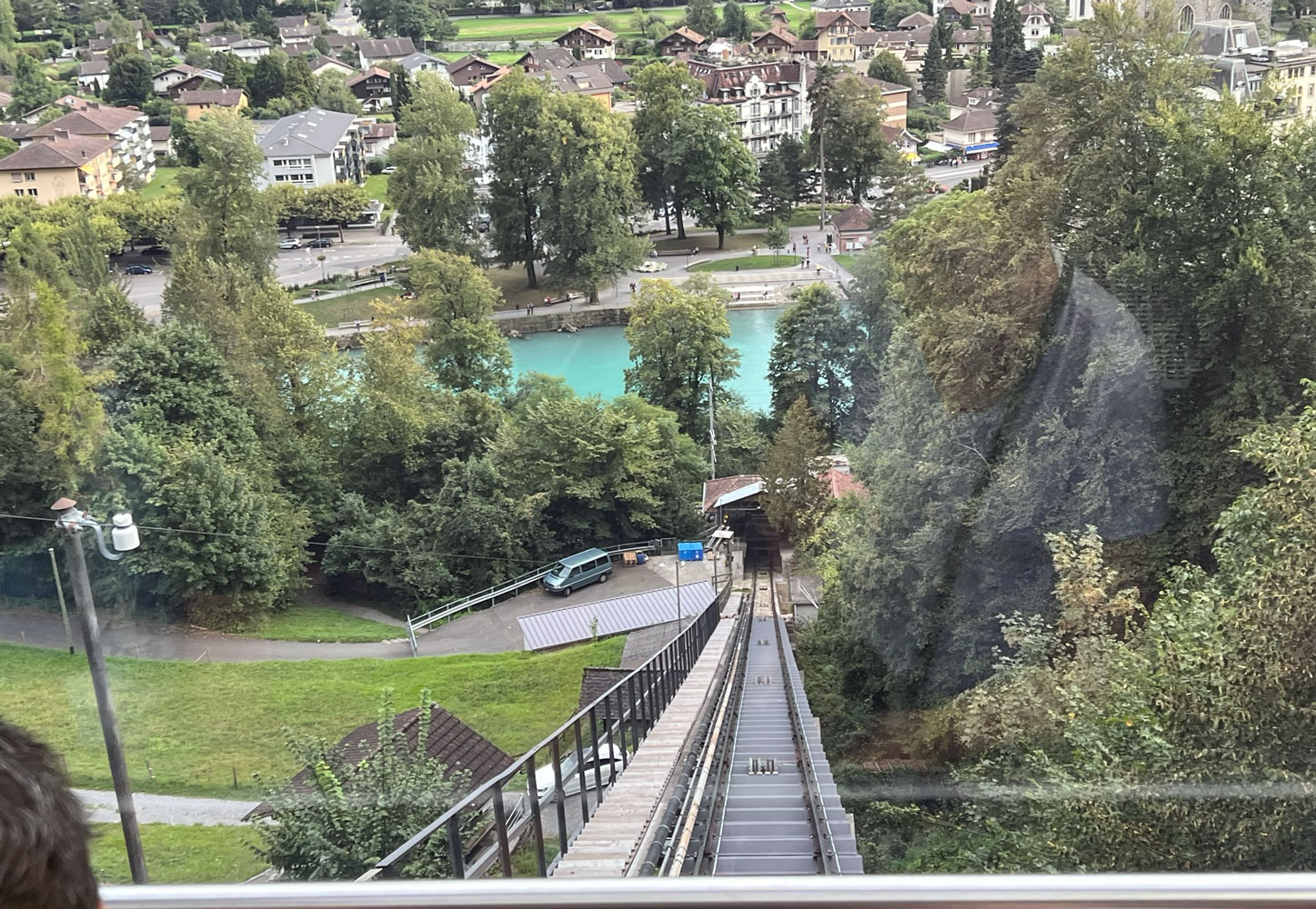
Just a comment about a funicular. There are two cars and one is moving up while the other is moving down. There is only one traction cable for both cars and the cable is powered from the top station.
You might be concerned about only having one cable supporting both cars but there is an automatic brake mechanism that grabs the rails if tension is lost on the cable. It's similar to the automatic brake system on elevators.
As with all funiculars, there's a point where the up-going car meets the down-going car. At that point, the track diverges into two tracks and the cars pass each other.

A view of the valley from the top.
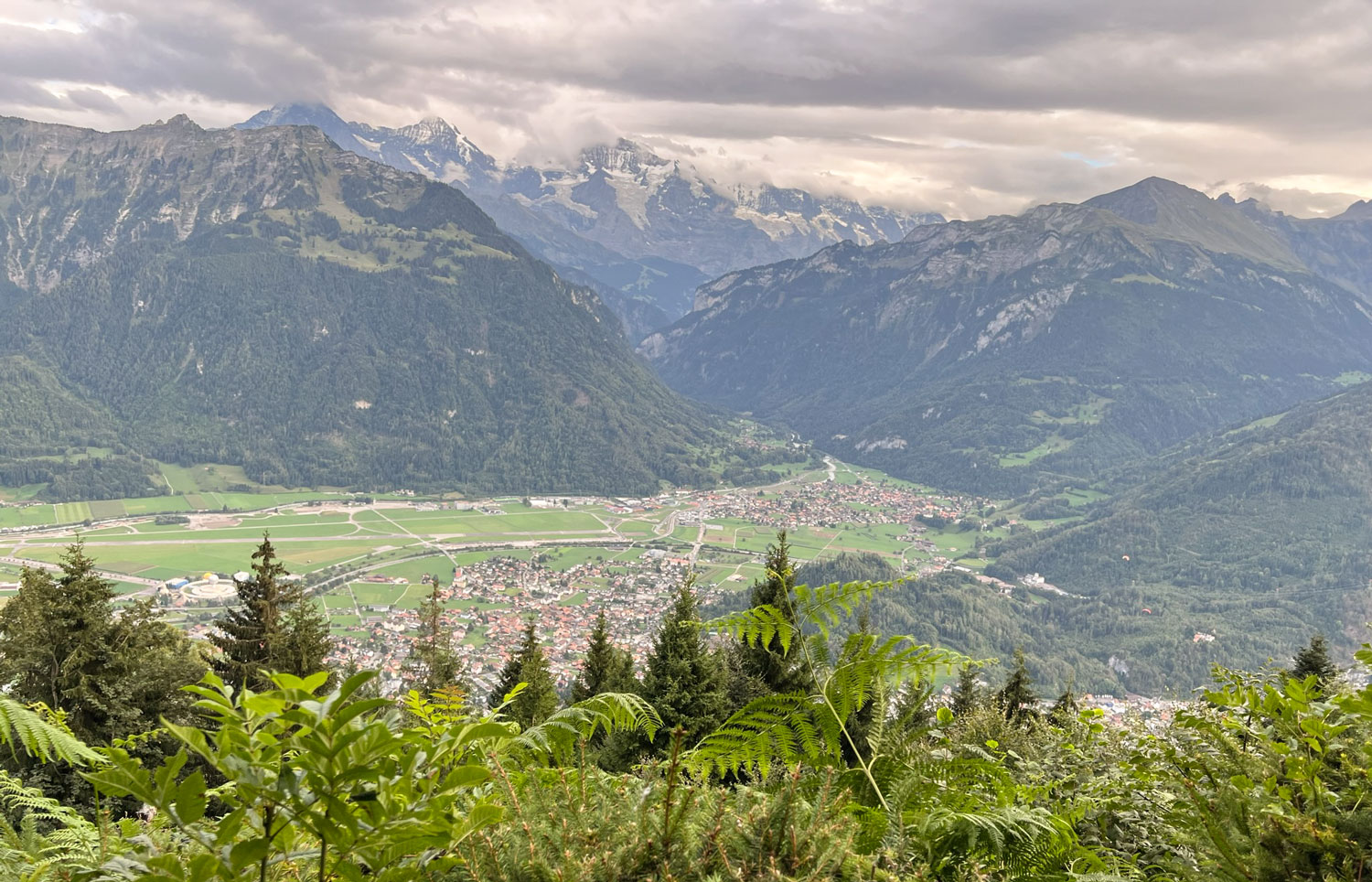
A picture toward the west towards sunset.
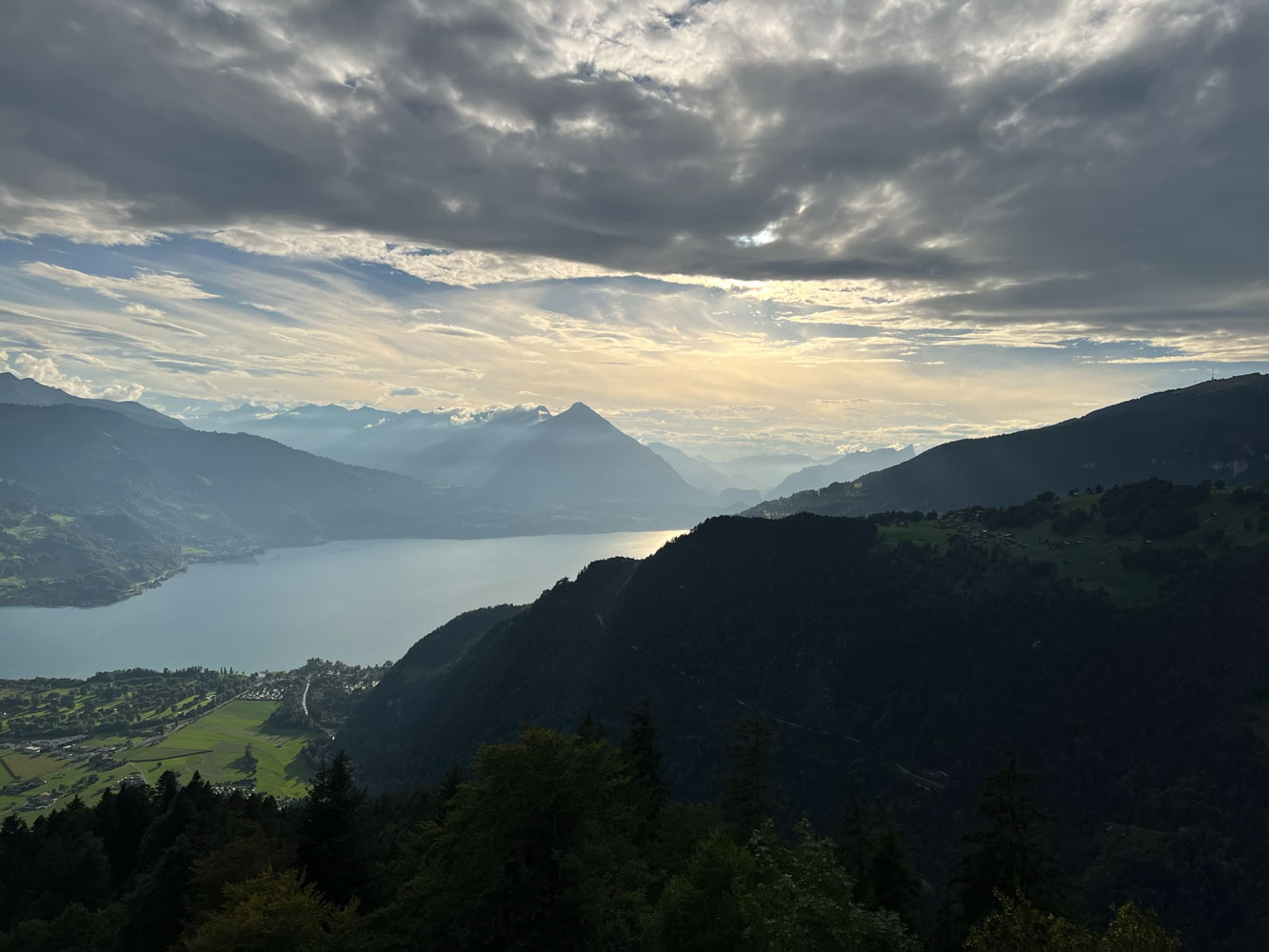
Our group at dinner. The food wasn't great but you don't go to the top of Harder Kulm for the food.
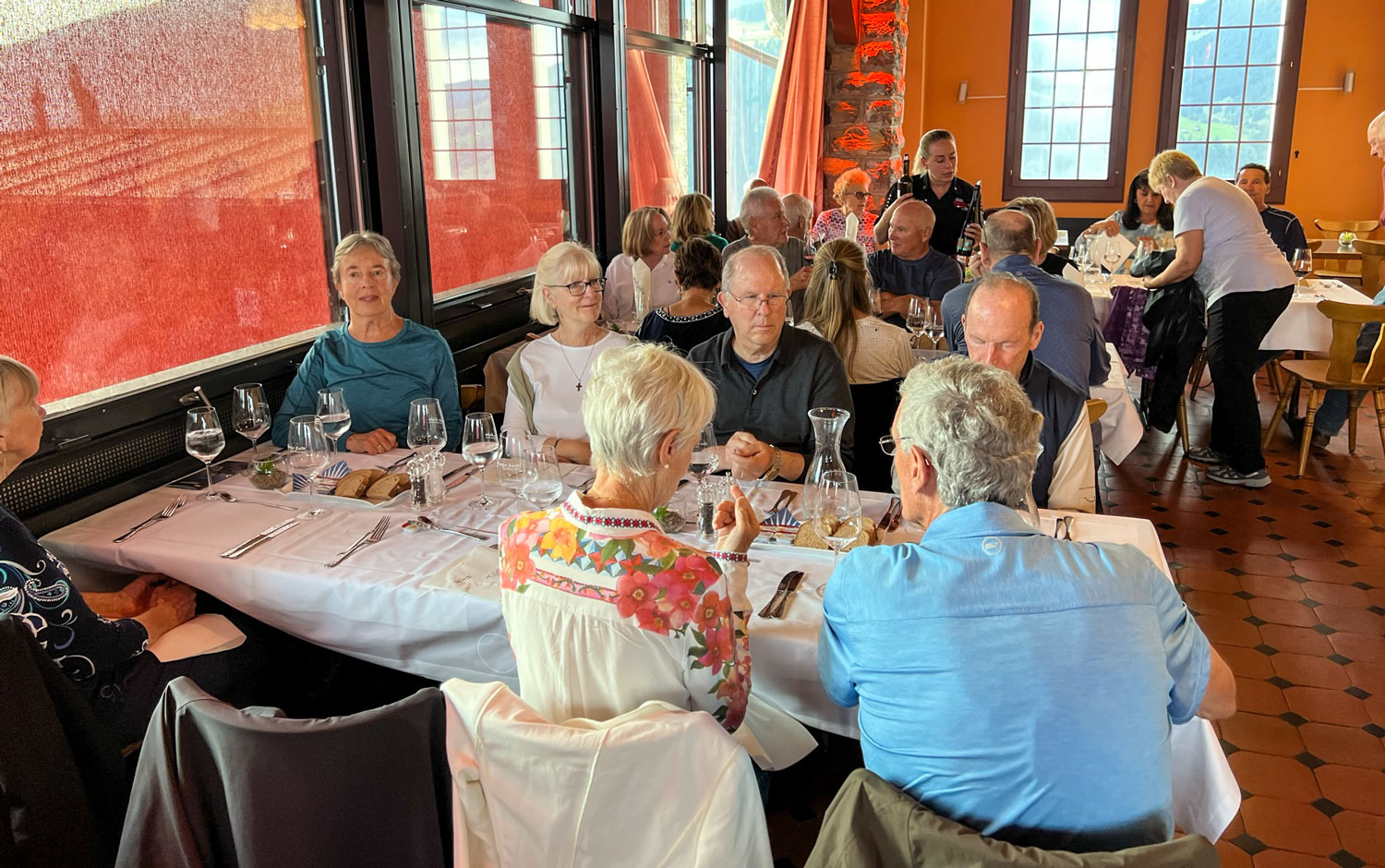
Two accordion players came and played a few tunes in the dining area.
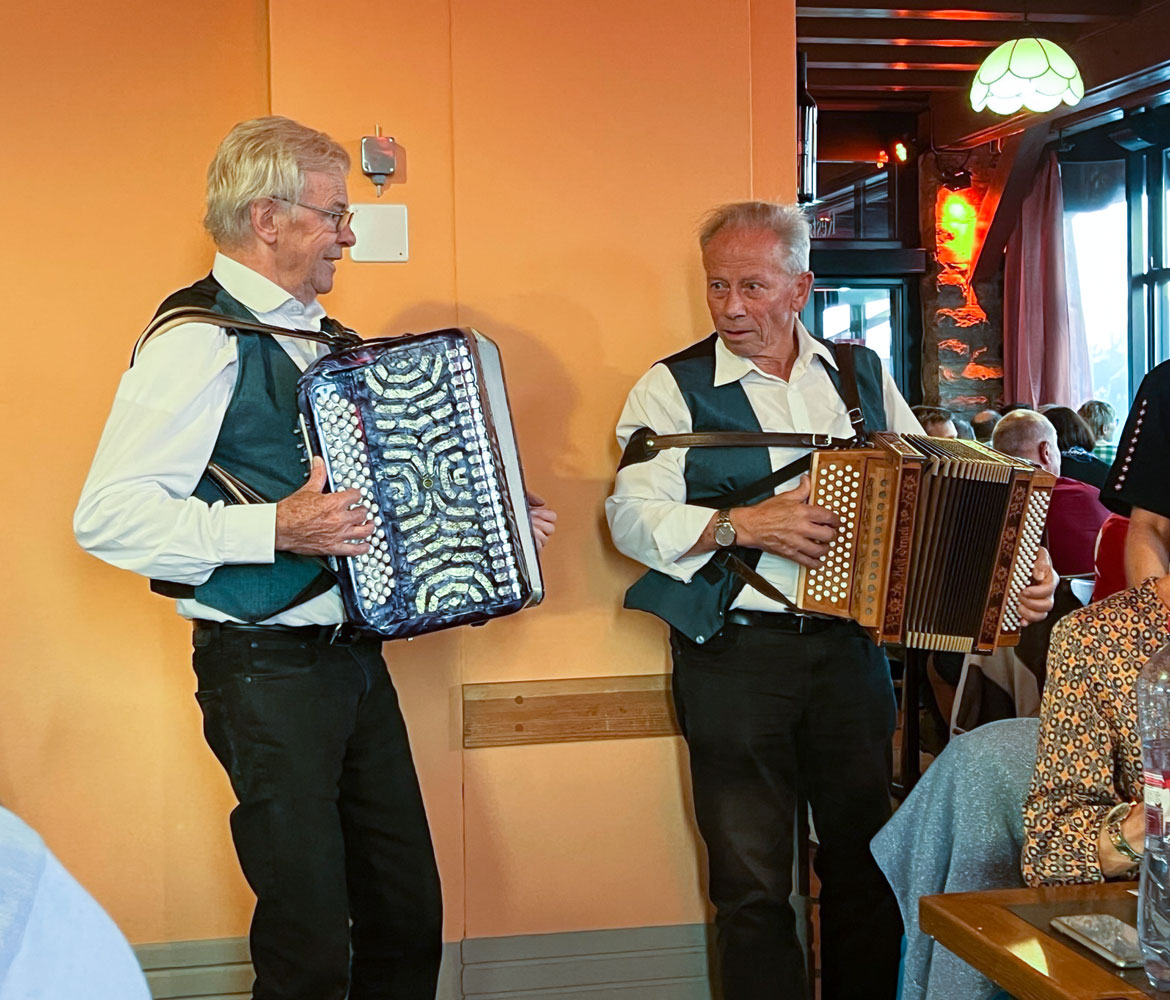
Then a young man came to our area with an alphorn and played a couple of tunes.
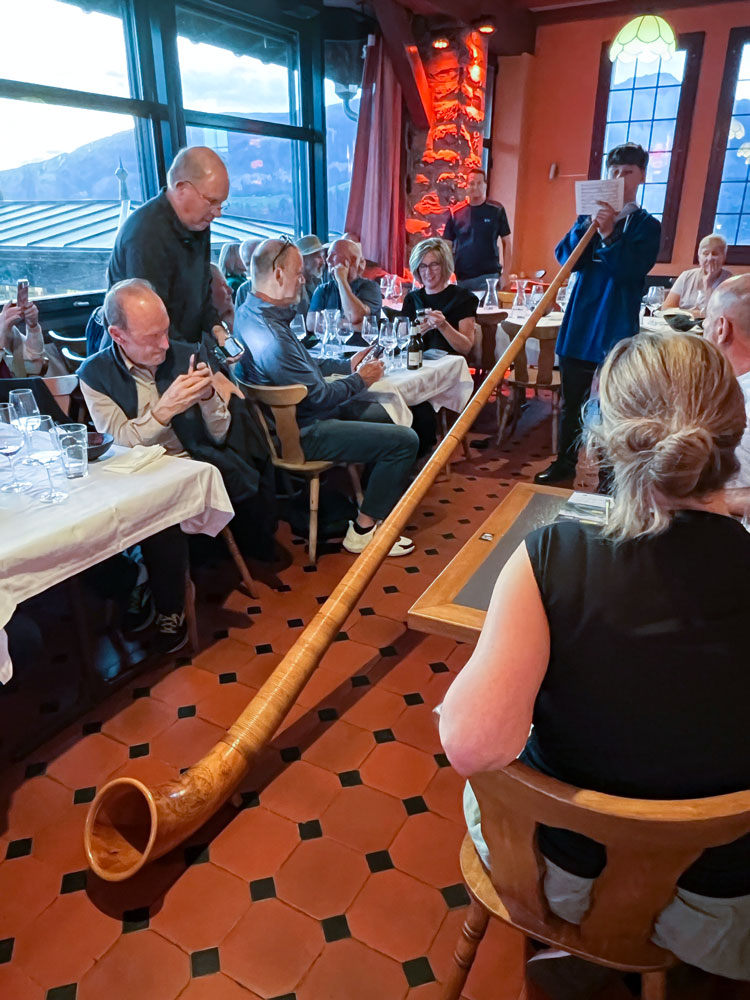
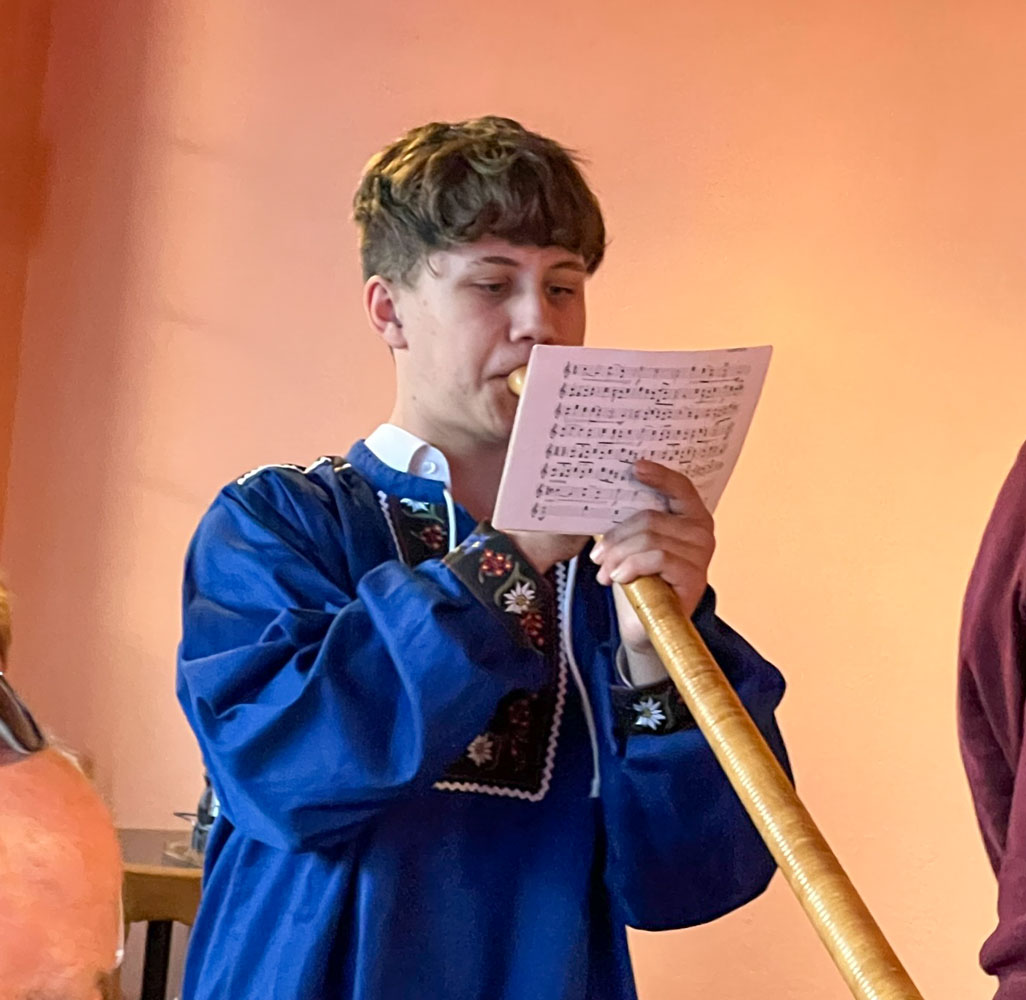
Then dinner was over and it was time to take the funicular back down to the valley and our hotel. That was the end of our day. Tomorrow, we go to the Jungfraujoch - the top of Europe.
+++++++++++++++++++++++++++++++++++++++++
9/17/2023 (Sunday) After breakfast, we met the bus at 8am and departed for our excursion to the Jungfraujoch. We're headed to the Grindelwald Grund railway station where we'll catch the first cog railway train. We'll take that train to the Eigergletscher railway station where we'll transfer to a different cog railway train which will take us to the Jungfraujoch.
On the way down, we'll take the new Eiger Express cable car from Eigergletscher to Grindelwald.
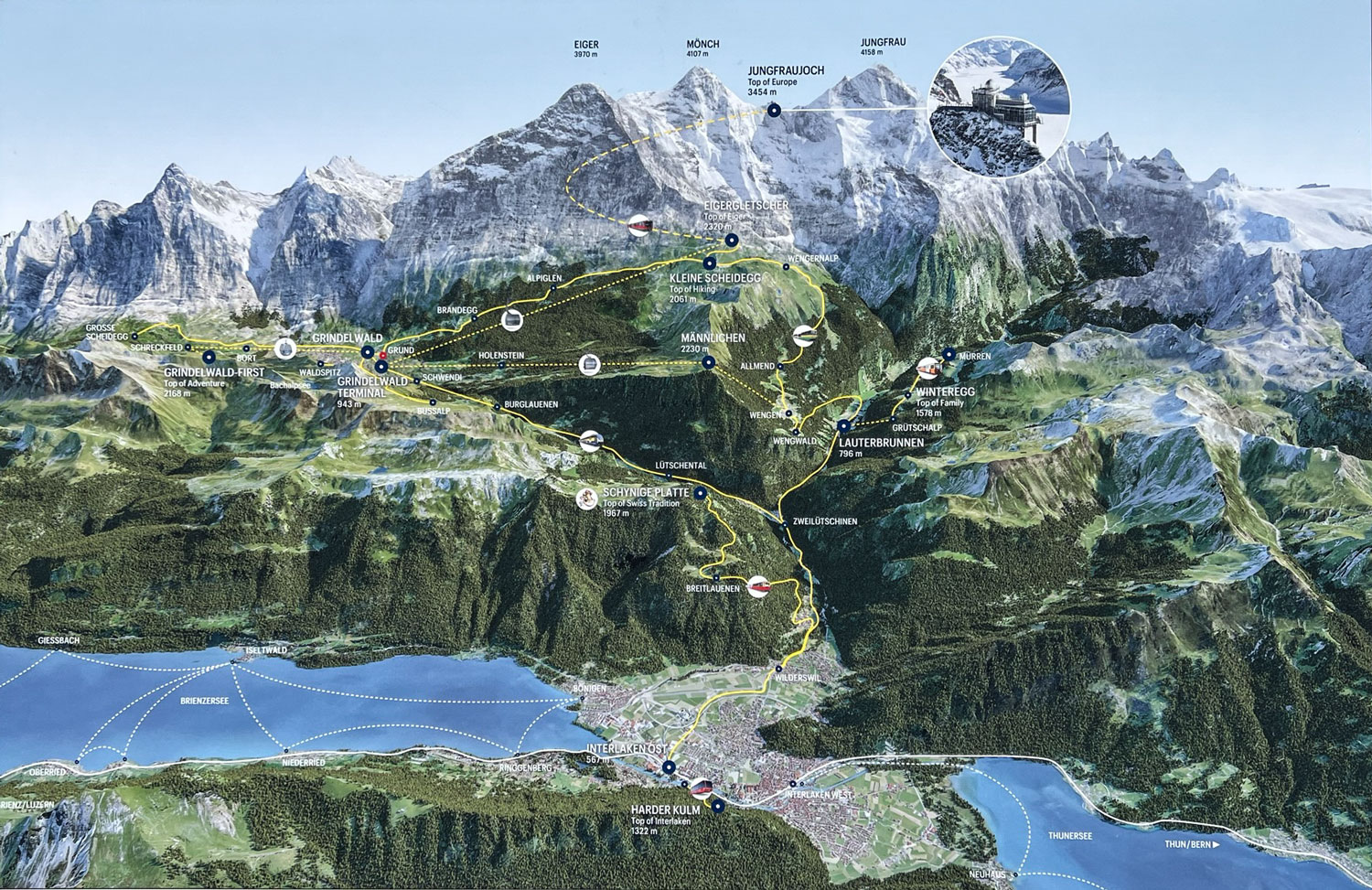
We were met at the Grindelwald Grund railway station by our two guides.
Erika Mattle
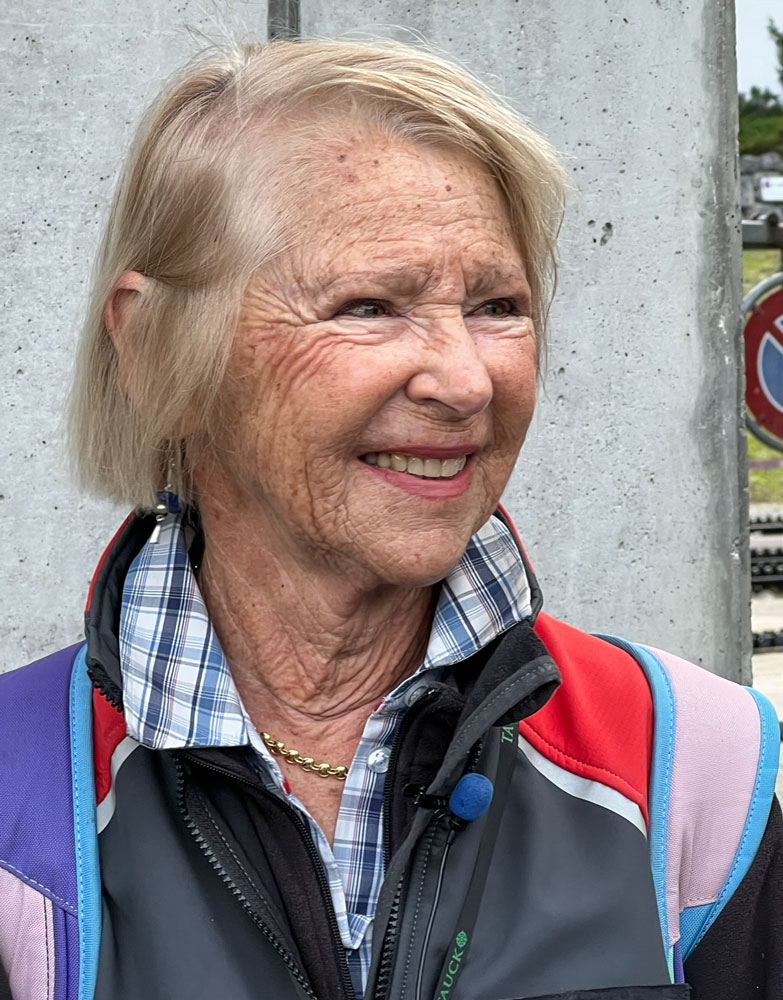
And Niklaus Gammeter.
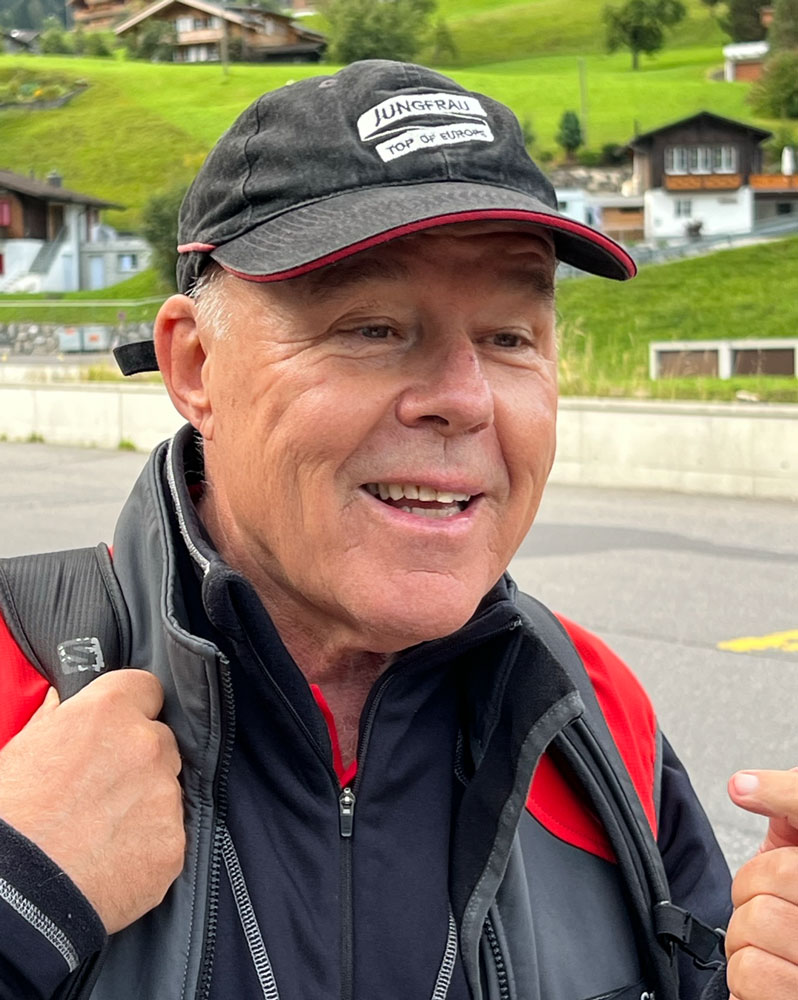
We boarded the train on time and soon reached Eigergletscher, where we change trains. Here's Carrie and Erika leaving the train we arrived on.
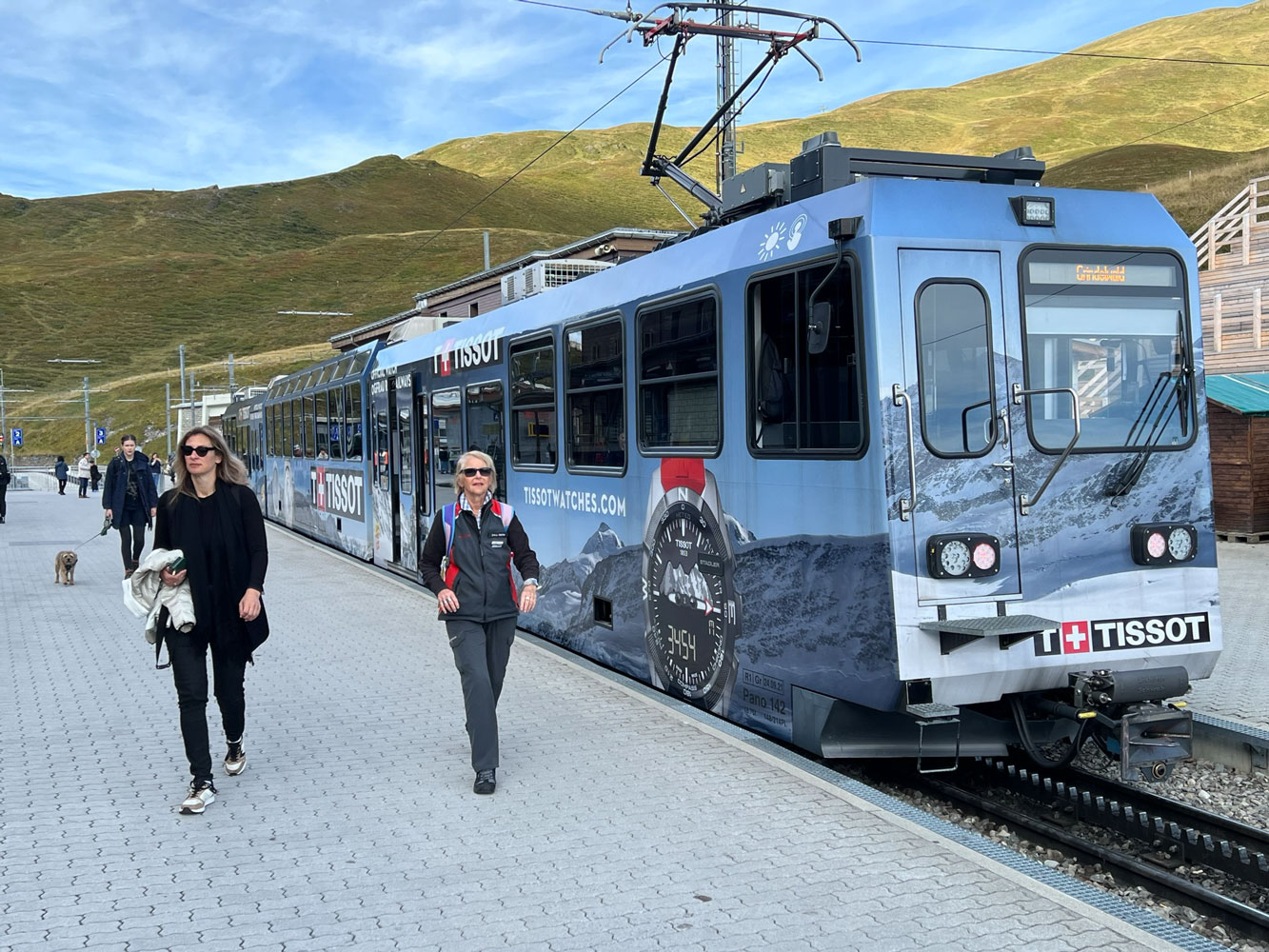
We all took pictures of the area. In this panoramic shot, the train track on the left is the route towards the Jungfraujoch. The arrow points to the structure where we're going. The peak on the left is the Eiger, which means ogre. The next peak is the Mönch, which means monk, and the last one is the Jungfrau. That translates to young girl. In legend, the monk is protecting the young girl from the ogre. The Jungfraujoch (saddle) is between the Mönch and the Jungfrau.
This gives me an opportunity to mention the 1975 film, The Eiger Sanction, starring Clint Eastwood. I saw it long ago and don't remember it as a great movie, but it was filmed on location. We'll probably watch it again now that we've been there.
[Update 10/6/2023: We watched "The Eiger Sanction" this evening. It's an interesting movie - the plot is non-existent but the climbing sequences are great. I would still recommend it, especially if you were in Switzerland on this tour.]
The Eiger was first climbed in 1858 via the west face. The east and south faces were also climbed but the north face remained through the 1930's. There were a number of unsuccessful attempts, with the 1936 attempt by four climbers perhaps the best known. The north face was eventually conquered in 1938 by a German-Austrian team.
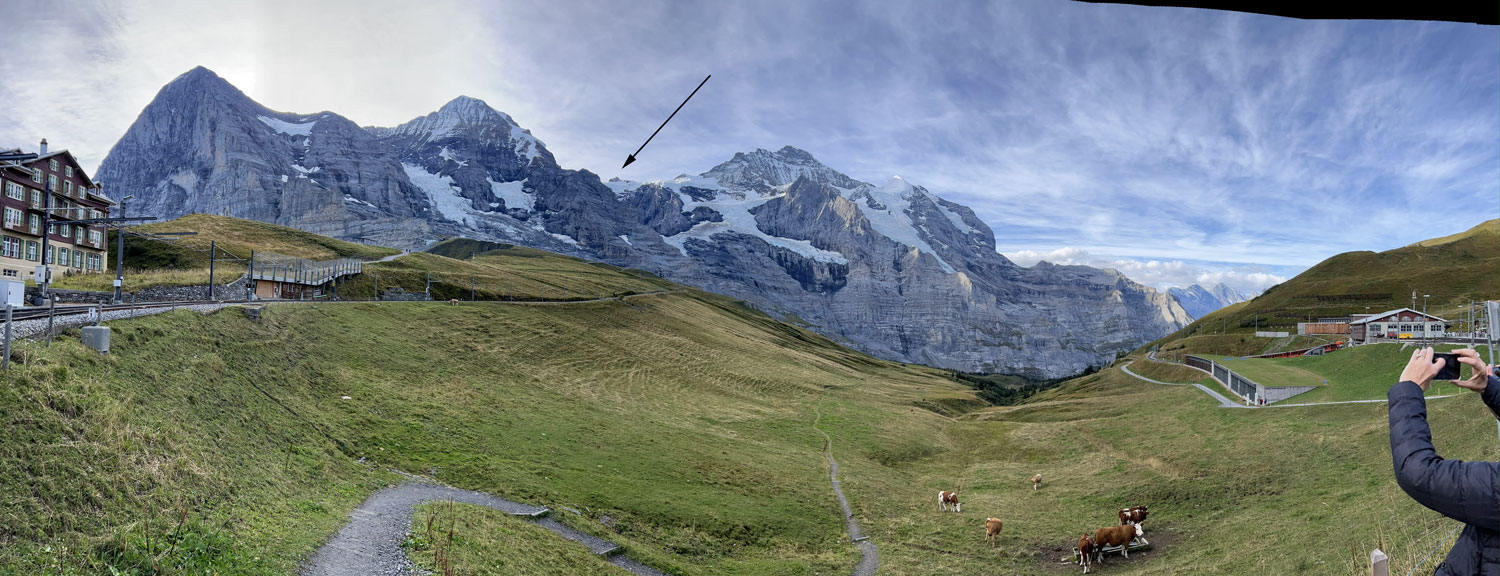
Here's a telephoto shot of the building, our destination.
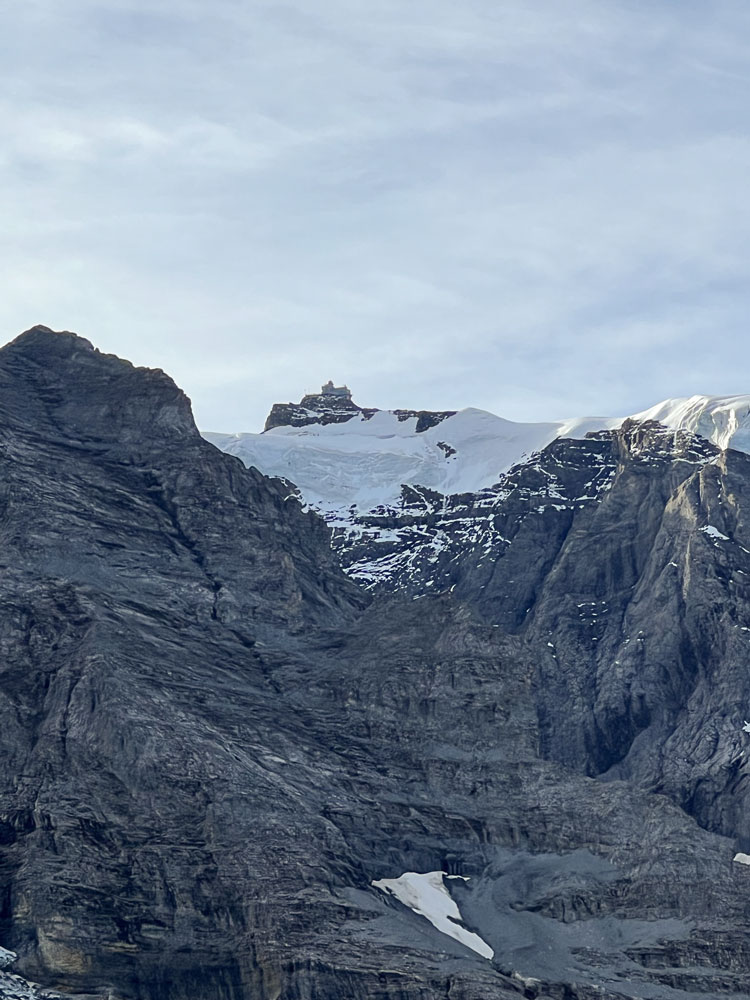
And an aerial view, taken from the web.
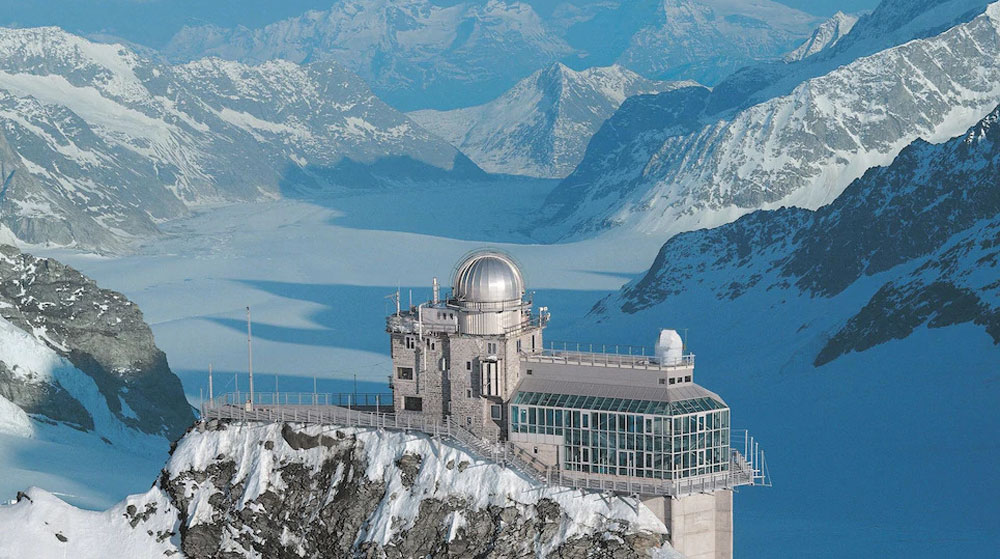
Here are Judy and Jean at the station. Note the train on the left side of the picture. That's the train we'll take to the Jungfraujoch. At this point, we were at 6,760 feet (according to my altitude app).
Note that to reach the Jungfraujoch the rail line runs in a south-west direction. We're on the north side of the Eiger.
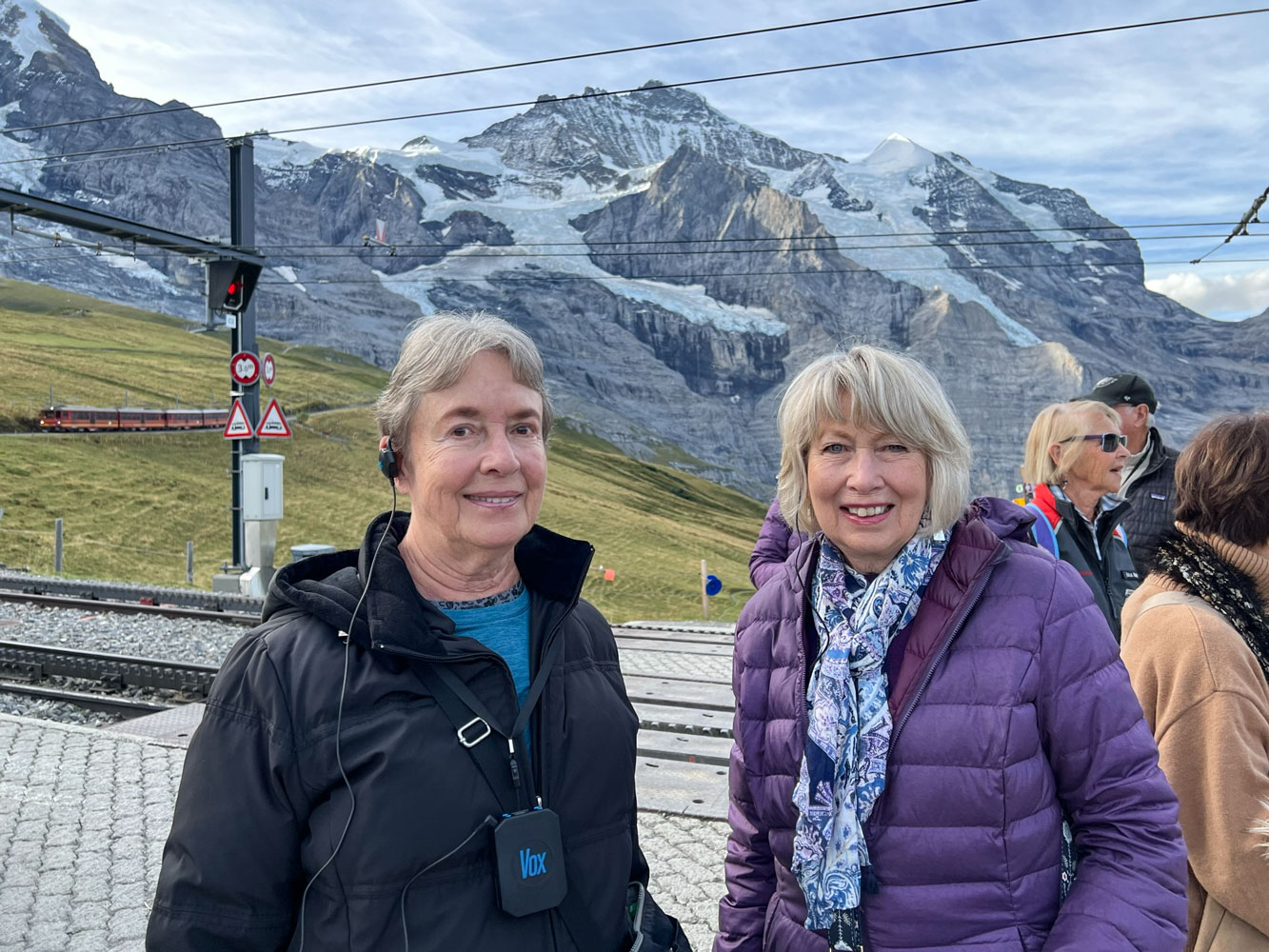
Here's the train we'll take to the Jungfraujoch. That's our guide, Erika, in the picture.
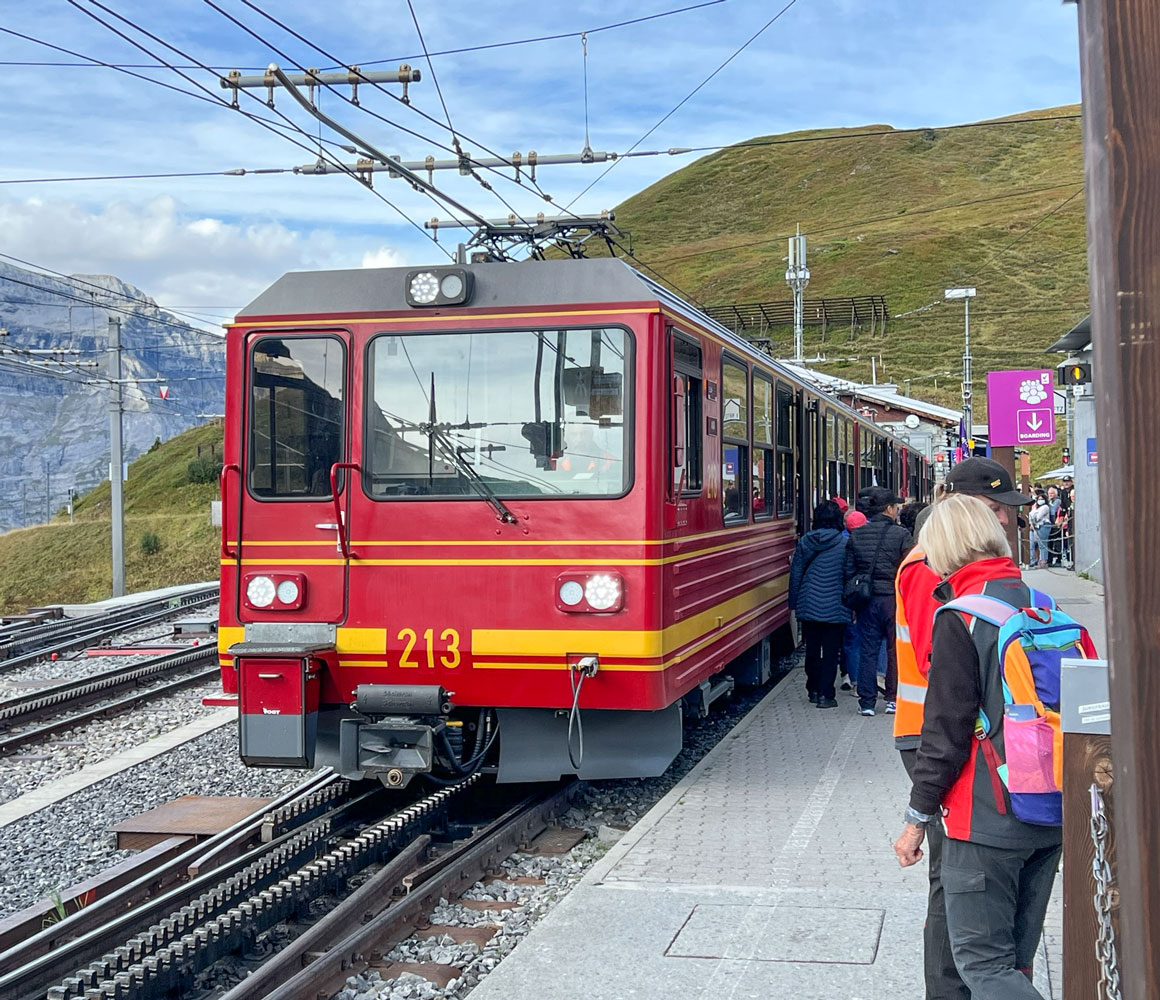
The train goes through a 7.3km tunnel on the face of the Eiger. The story of the digging of the Jungfrau Railway tunnel can be found here. The tunnel was completed in 1912 and began operation later that same year. It has operated continuously since then. It was built for winter tourism - skiing - but now supports tourism both summer and winter.
When they were digging the tunnel, they made some side tunnels to the outside of the Eiger for ventilation and to dump the rock they dug out of the tunnel. One of those side tunnels plays an important part in the film, The Eiger Sanction.
The train did stop once, at the Eismeer Station, near one of those side tunnels, and we could take some pictures. This picture is of the Eismeer (the sea of ice) on the east side of the Eiger.
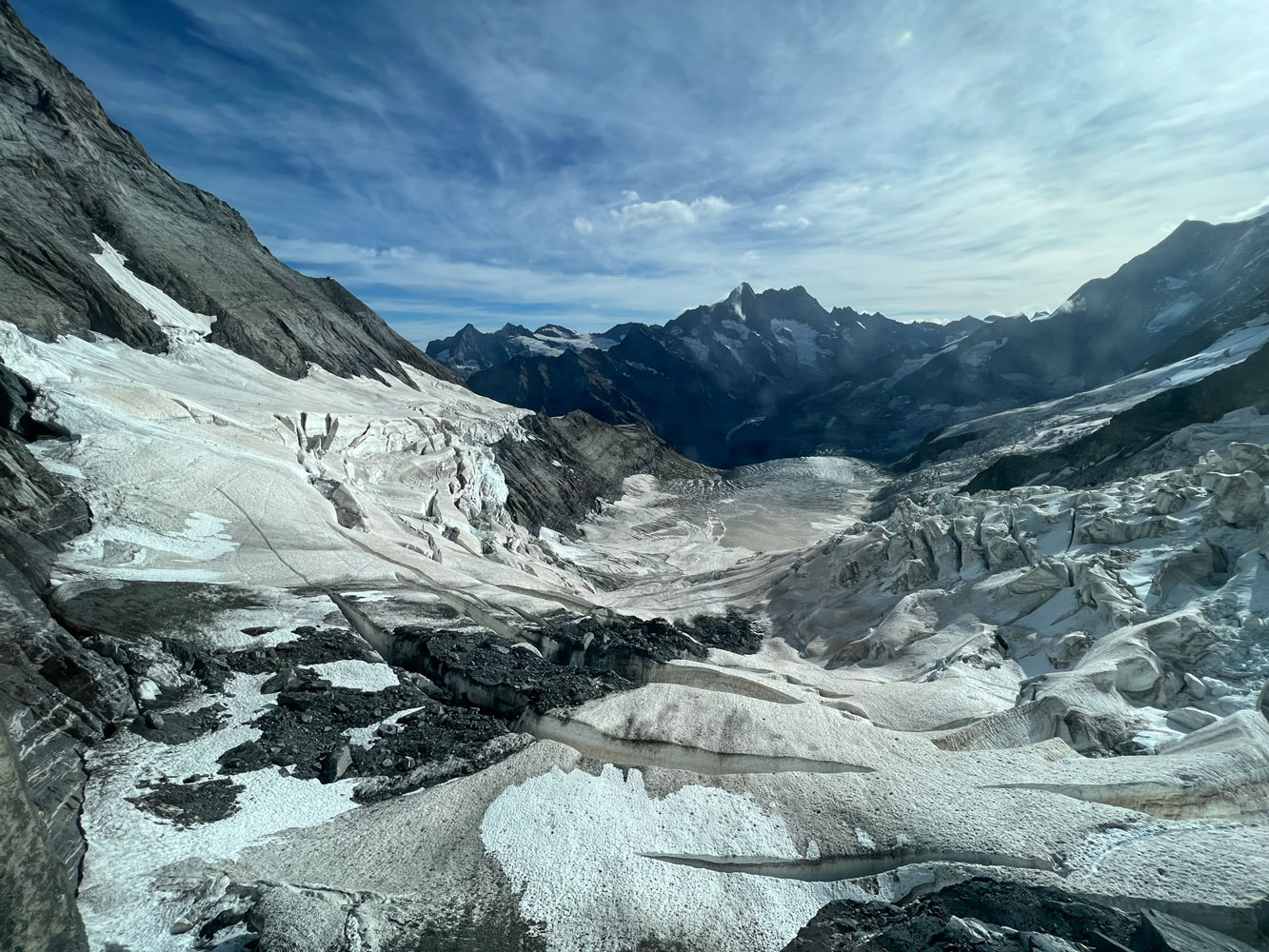
Miserable picture, but it's all I had that shows the side tunnel and the viewing window.
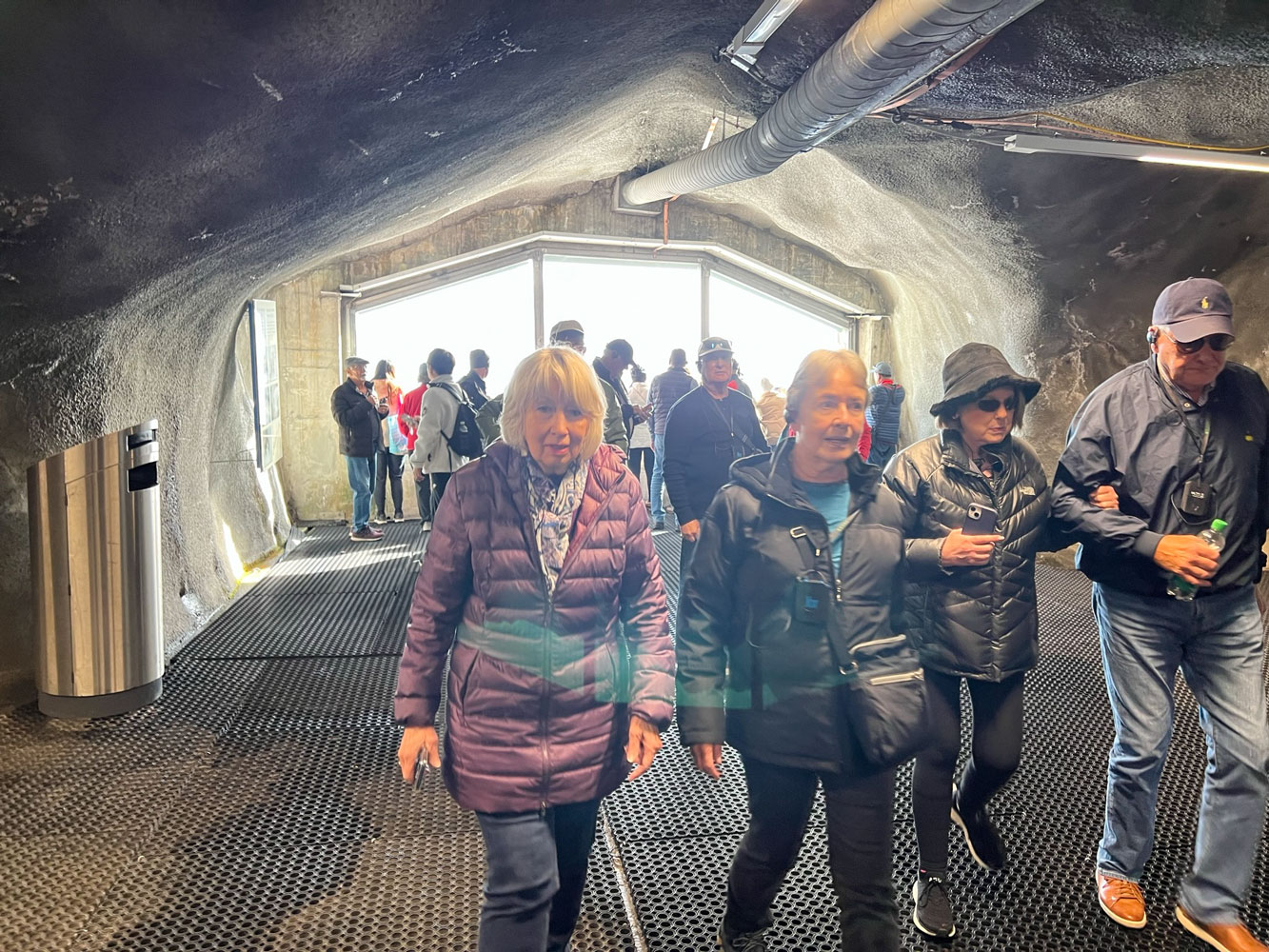
It was a fairly short ride to the station at the Jungfraujoch. The sign says 3454 meters, about 11,332 feet.
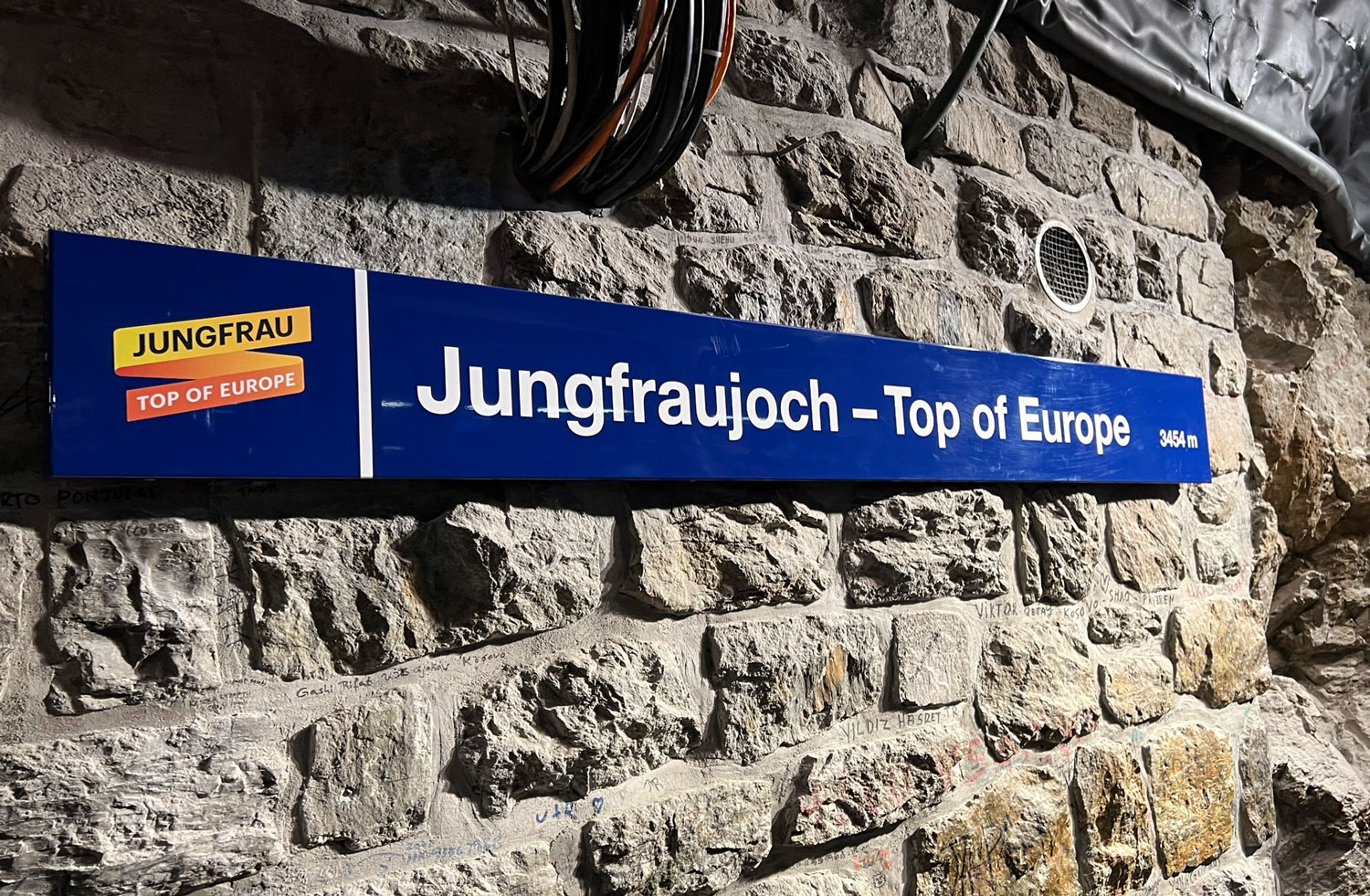
We were on floor 0 of the station, and took a restroom break. I shot this picture through a window, which affects the color.
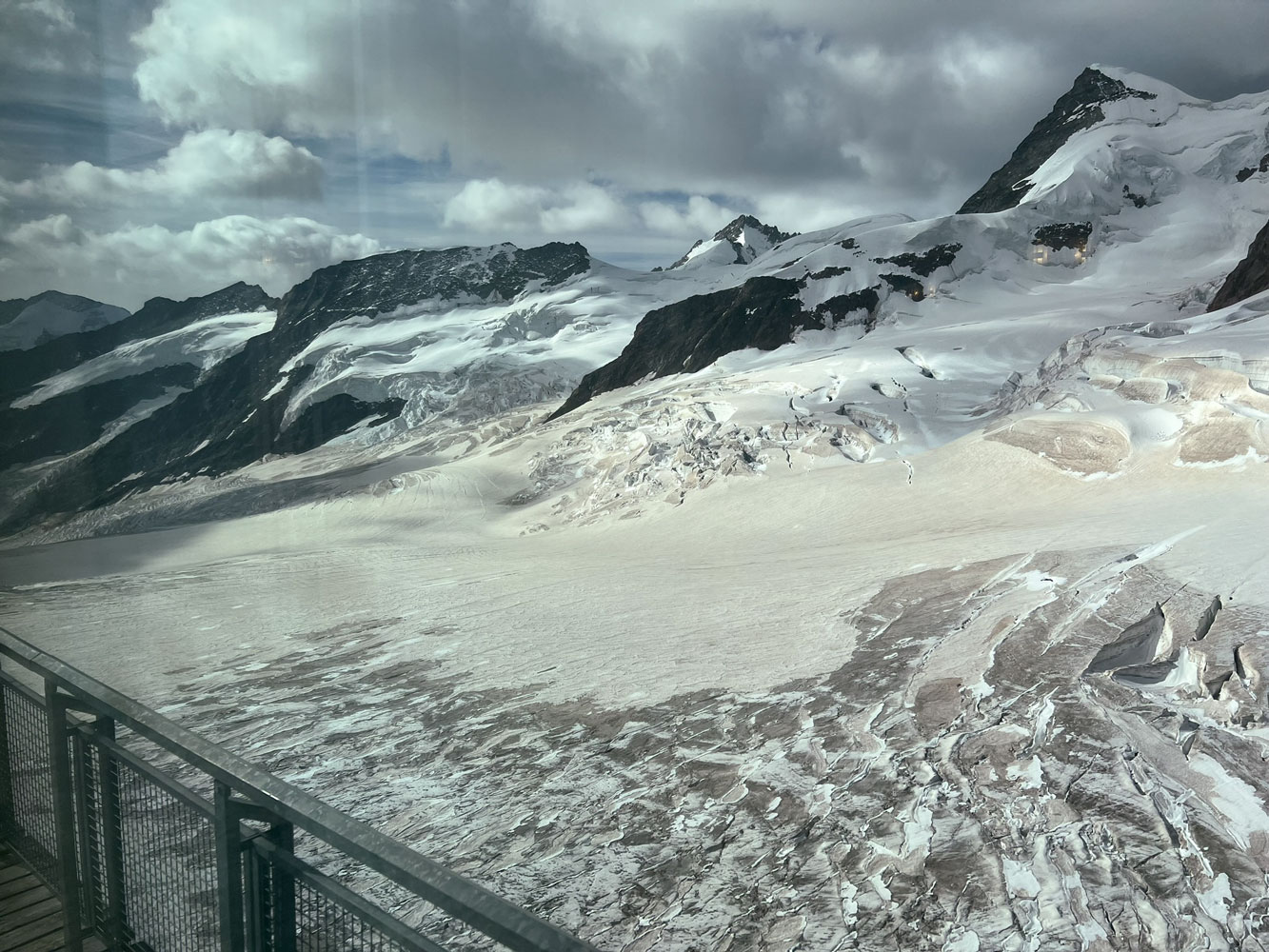
The Jungfraujoch was very crowded, which detracted from the visit. Many of the tourists were not very polite and there was much pushing and crowding.
Near the cafe on level 0 was this mailbox. Carrie had given each of us two post cards and two stamps. Judy addressed the cards to us and mailed them in the box. Carrie said that the cards would receive a special stamp indicating deposit at the Jungfraujoch. She also indicated that it would take a long time for the cards to reach us, as much as a month.
[Update: We mailed the cards on September 17th and received them on September 26th. Pretty fast service for international post cards.]
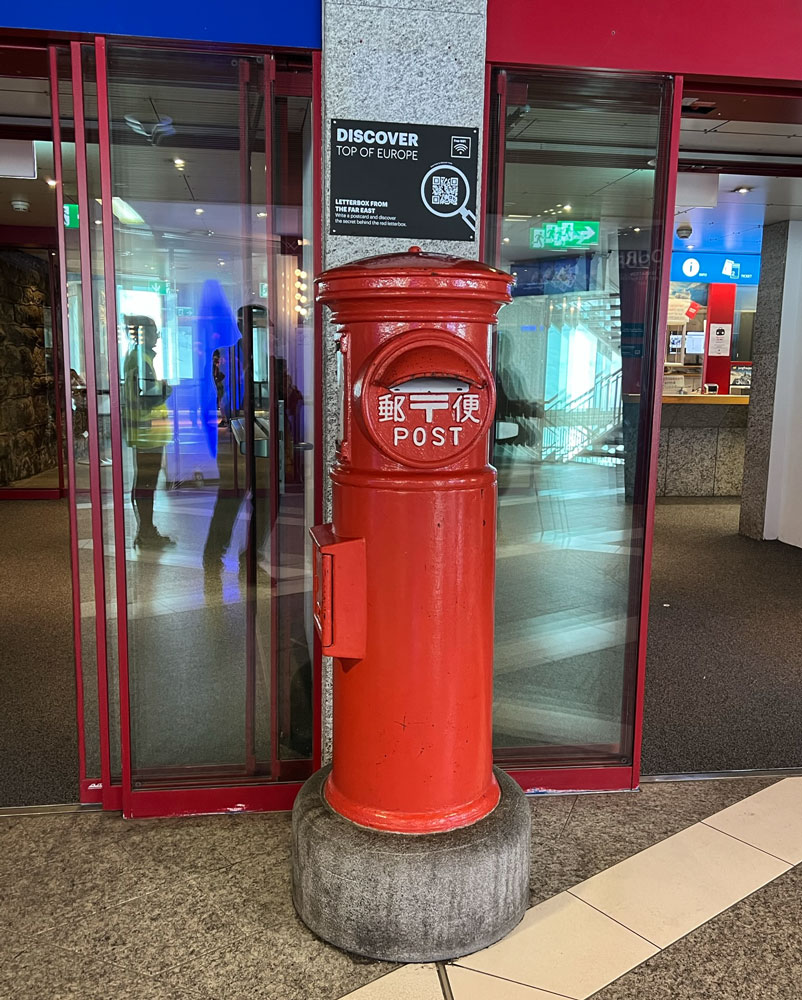
From here we headed to the Ice Palace (Eispalast) which is cut into the glacier.
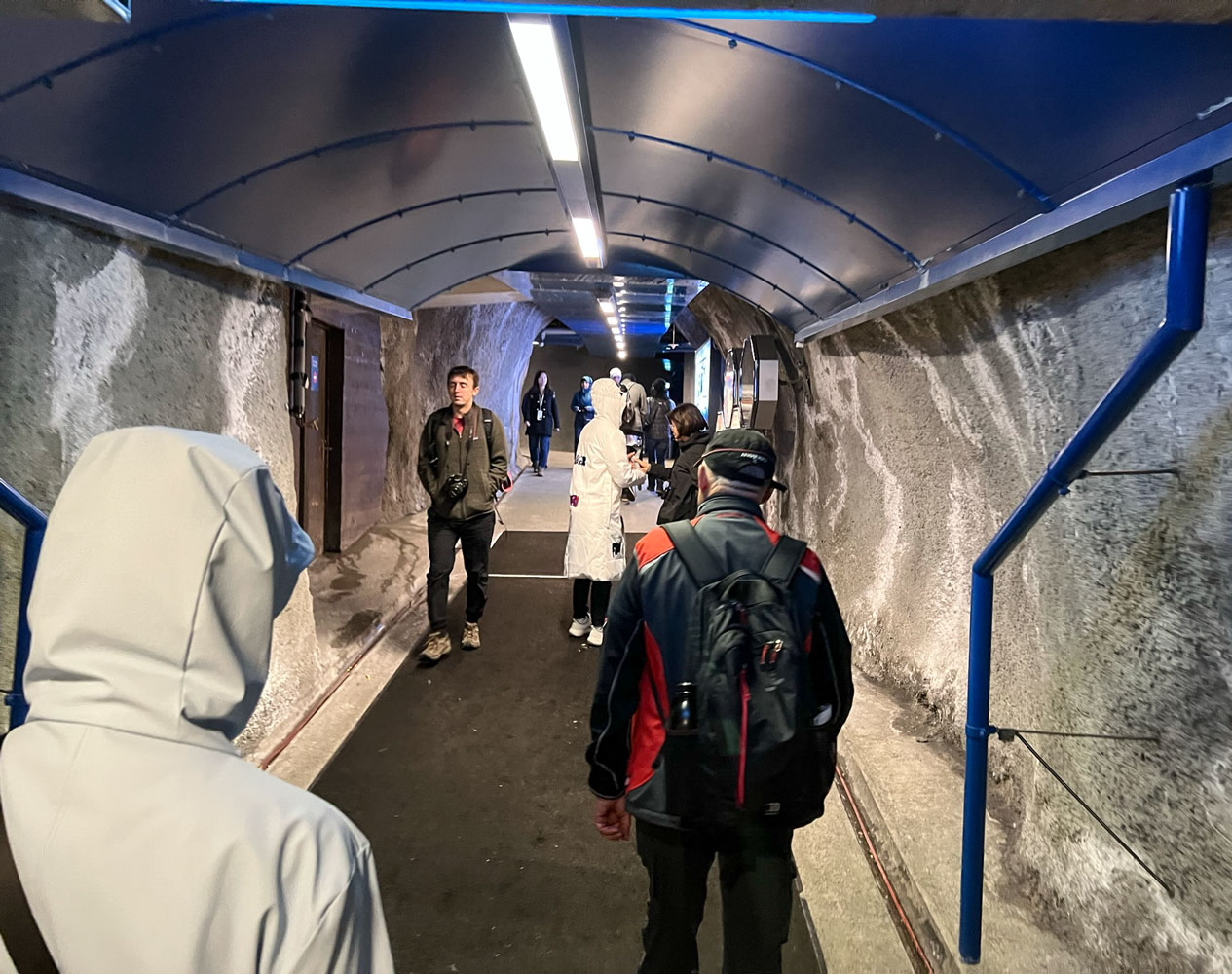
Here we are entering the Ice Palace. Notice the graphic of the boot with crampons indicating "not permitted".
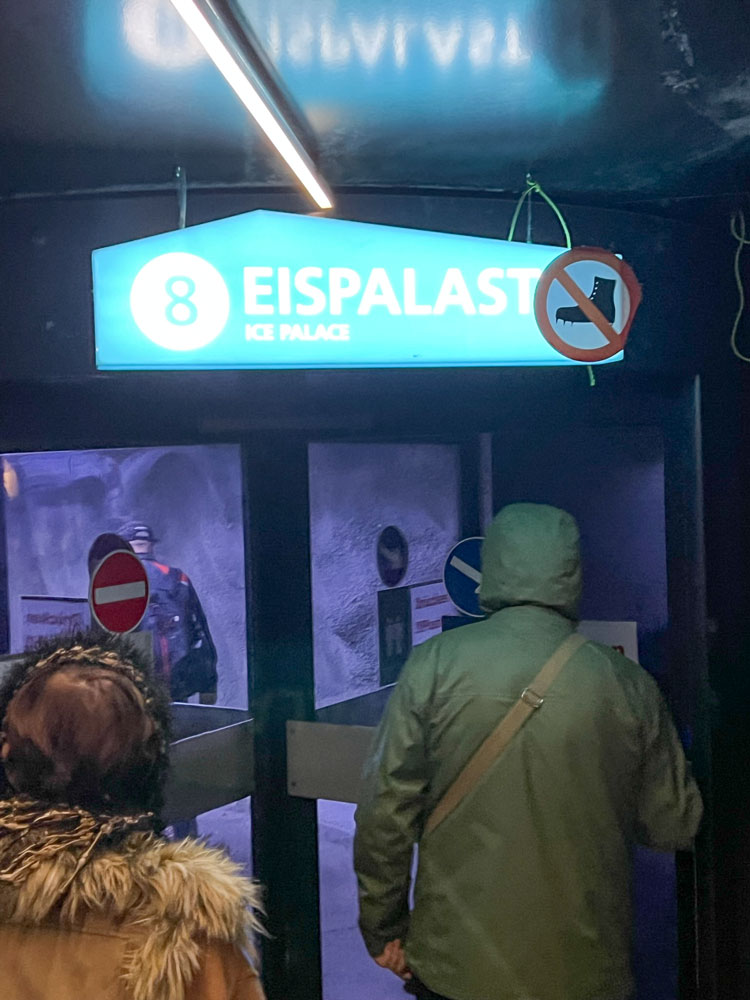
While this was supposed to be the highlight of the visit to the Jungfraujoch, I did not enjoy it. You are walking on ice, like an ice rink, and my shoes did not give me sufficient traction to be comfortable. Additionally, I was very concerned about Judy slipping. If she had fallen it's possible she could have been badly injured, given that she's had two hip replacements
It would be MUCH better if Tauck would provide booties which we could tie to our shoes and would give better traction. In fact, I don't know why the Swiss don't spread sand on the floor to give better traction and improve the experience for their guests. Sand would not melt the ice, and some sand is mixed in with the glacier ice from the environment - just not enough to provide traction.
Slip and fall accident are a serious problem for older people, and most of us on this tour fall into that category. I'll bet the medical people treat a lot of slip and fall accidents every week.
*******************************
[Update: People who do the sport of "Curling" have to actively move on ice, so there must be some shoe product that allows them to have good traction. After some research, I found these "curling grippers" offered by several companies. Here's another company offering them. They're not cheap, about $18, but they could significantly improve your experience in the Ice Palace. Google "curling grippers" and you'll find many options.
I found a couple more at Lee Valley Tools - here and here. All of these are less expensive than a trip to an emergency room.]
*******************************
Here we are walking into the Ice Palace. There were handholds in most places, and we used them.
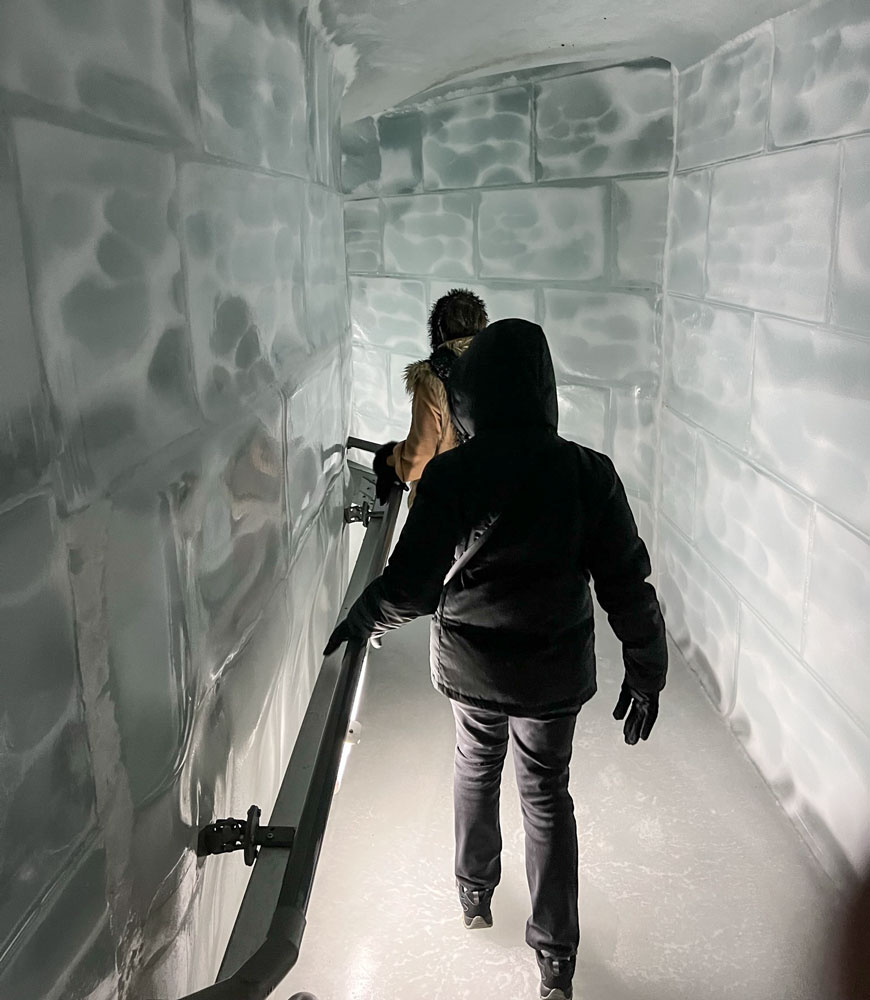
Another view as we entered.
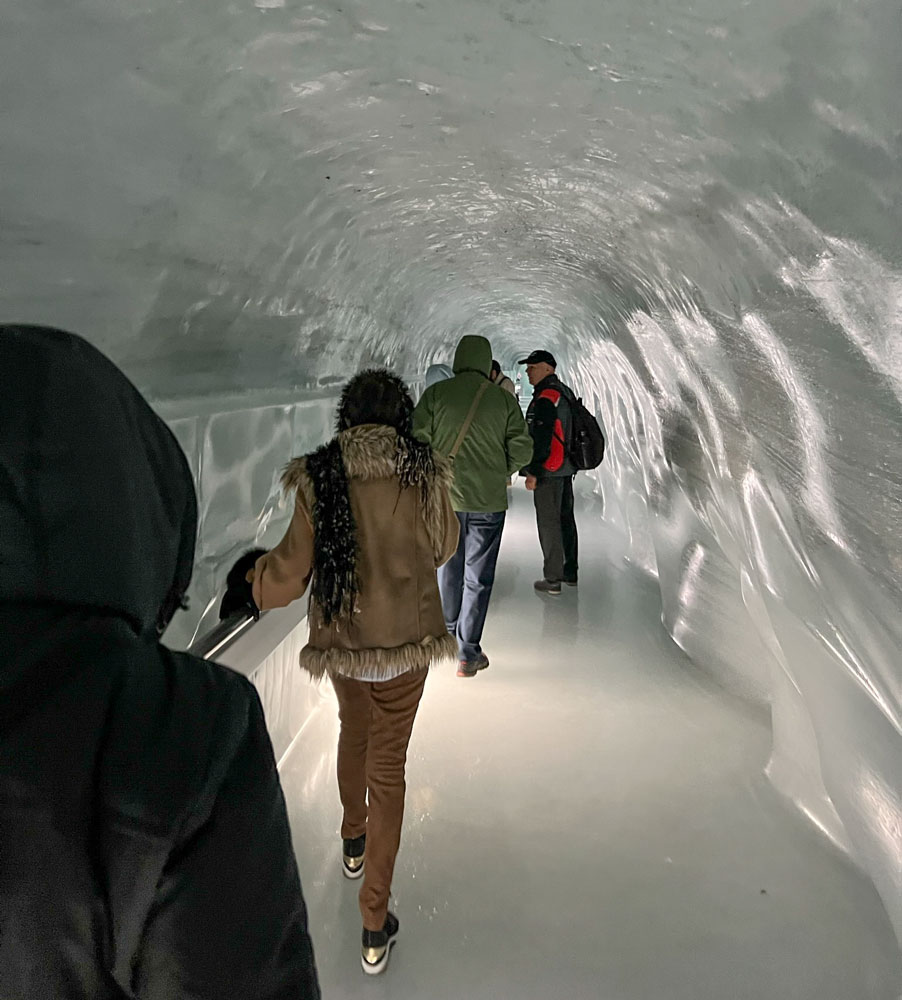
Judy in front of an ice sculpture of a piano being played by Lang Lang. He gave a performance at Jungfraujoch in 2015.
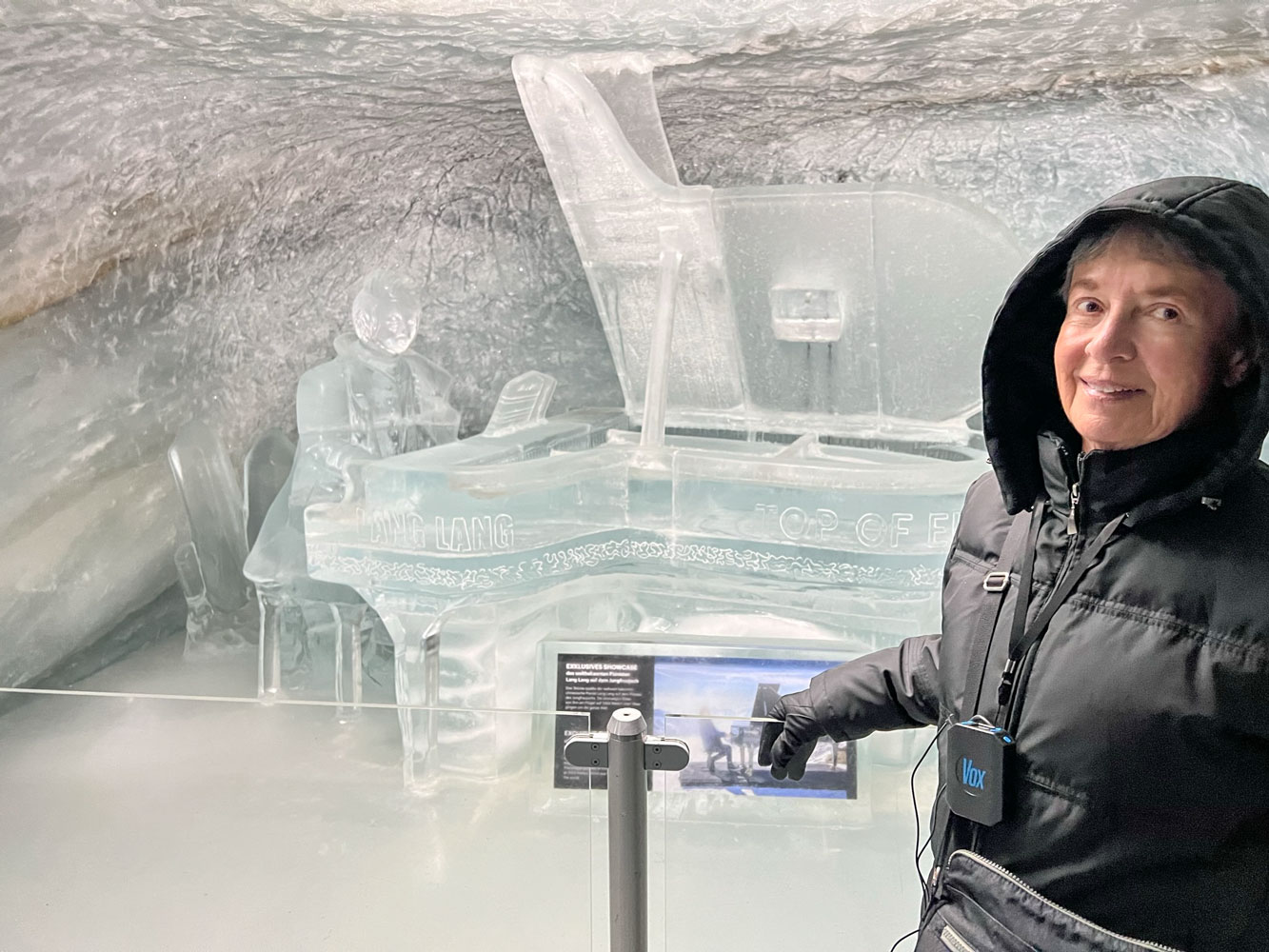
This sculpture represented the year of the rabbit. There were a LOT of Asian tourists at the Jungfraujoch while we were there. I don't know for sure, but many were probably Chinese.
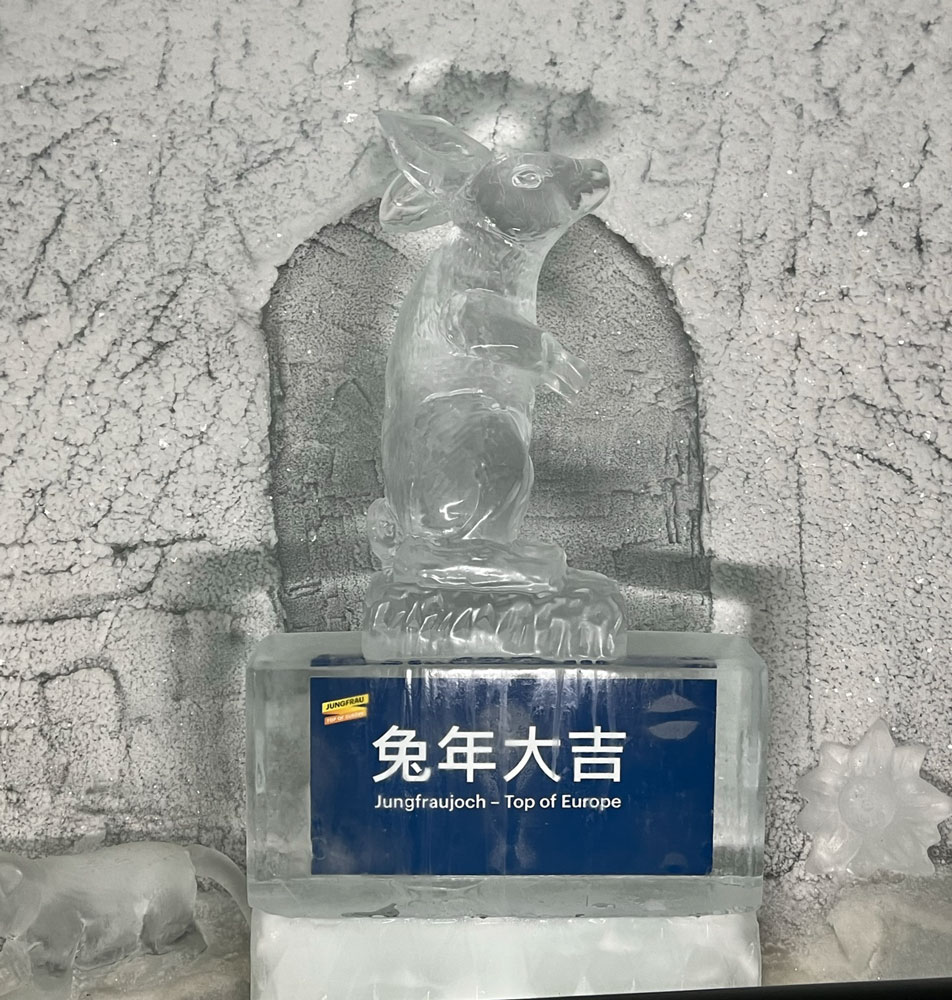
Judy going through an ice tunnel - with no handrails. It was not fun.
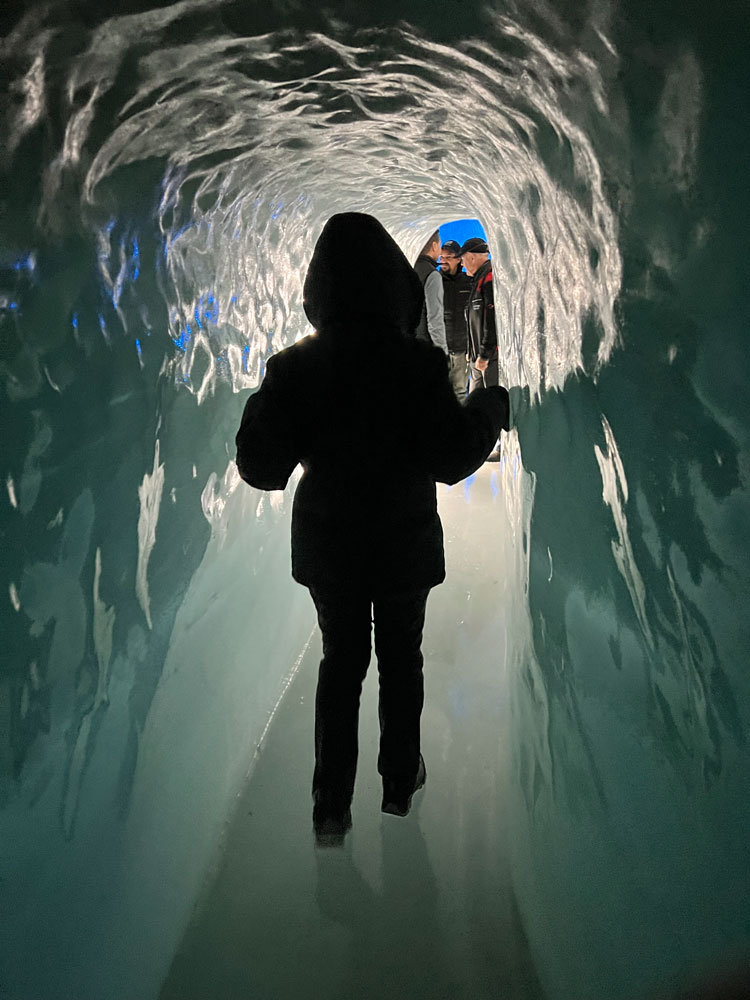
Just as I turned away from taking this picture, I started slipping on the ice and came very close to going down. I don't know how I managed to keep from falling down, but I made it.
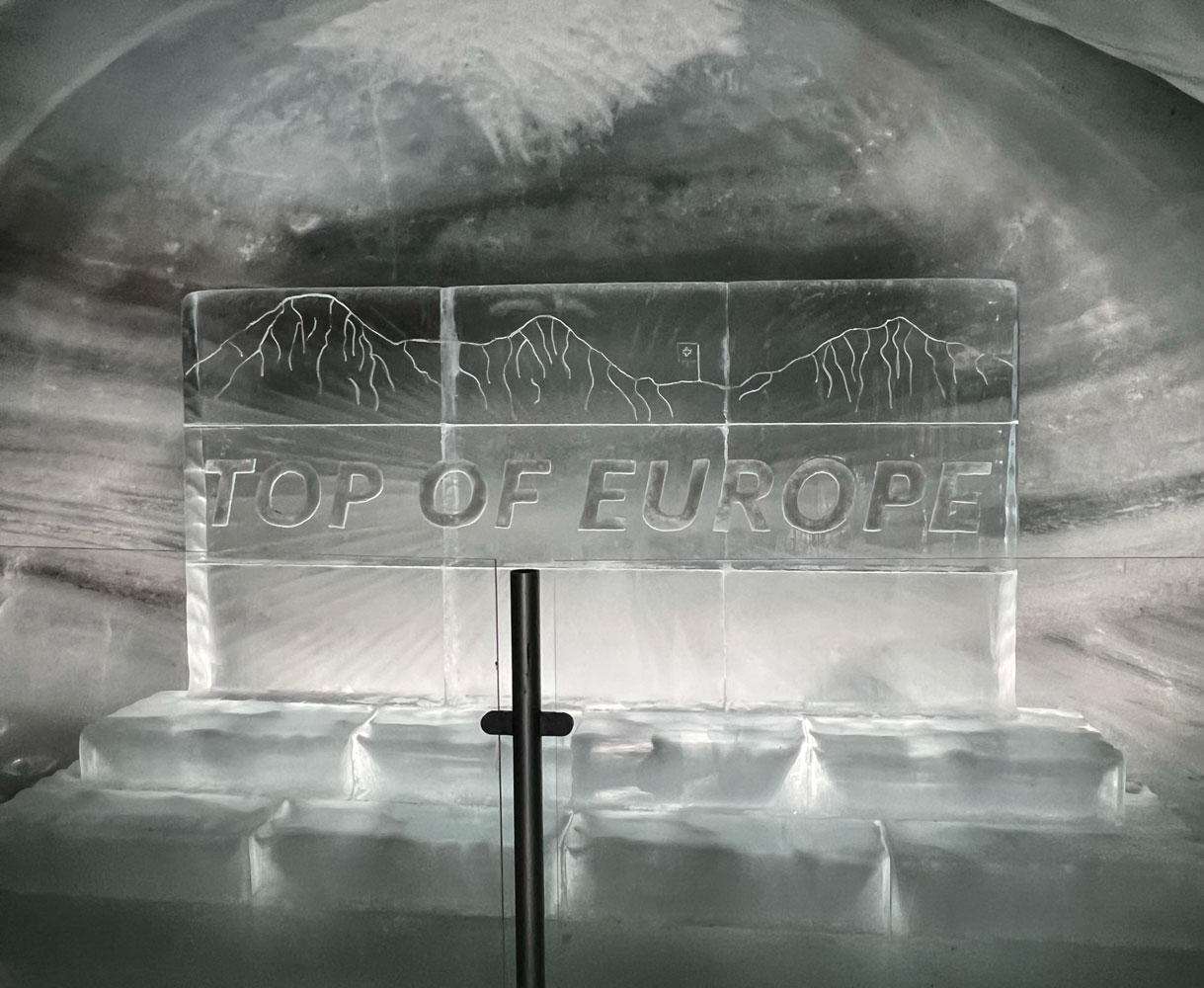
Then Carrie opened a door that lead to a stairway (not an ice stairway, thank goodness) and we climbed the stairs to the Ice Bar. Here's a picture of the stairway, taken from the top.
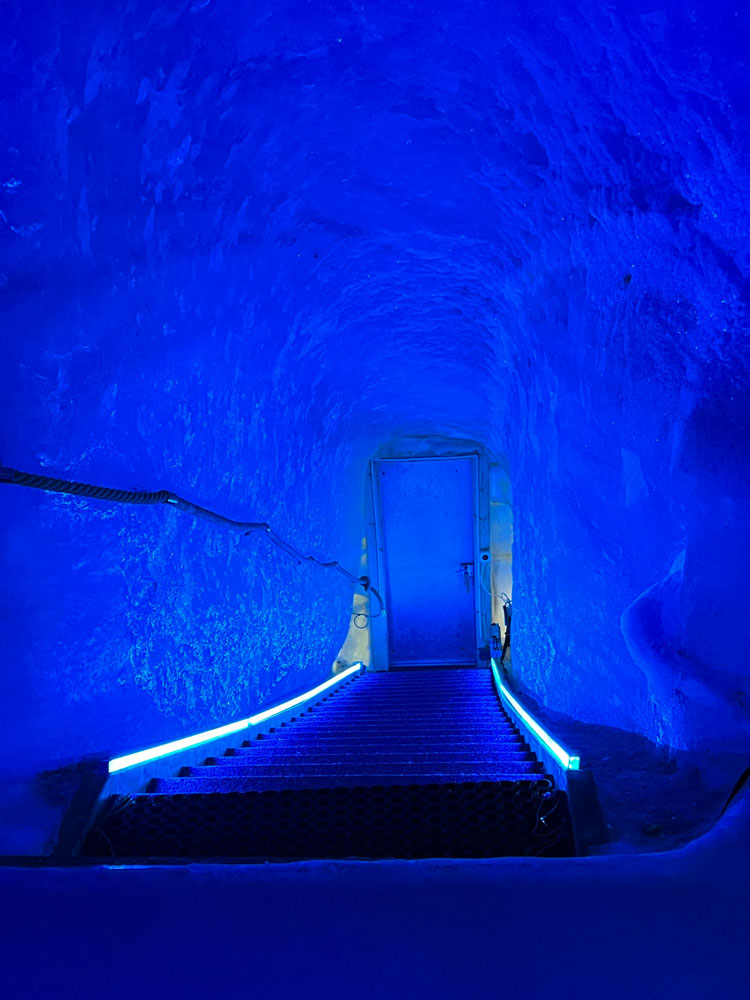
But as soon as we left the stairs, we were on ice again and were not comfortable. There was a rope handrail, and we held on to it. If they had put down mats for us to walk on, or sanded the floor, it would have been a much more enjoyable experience.
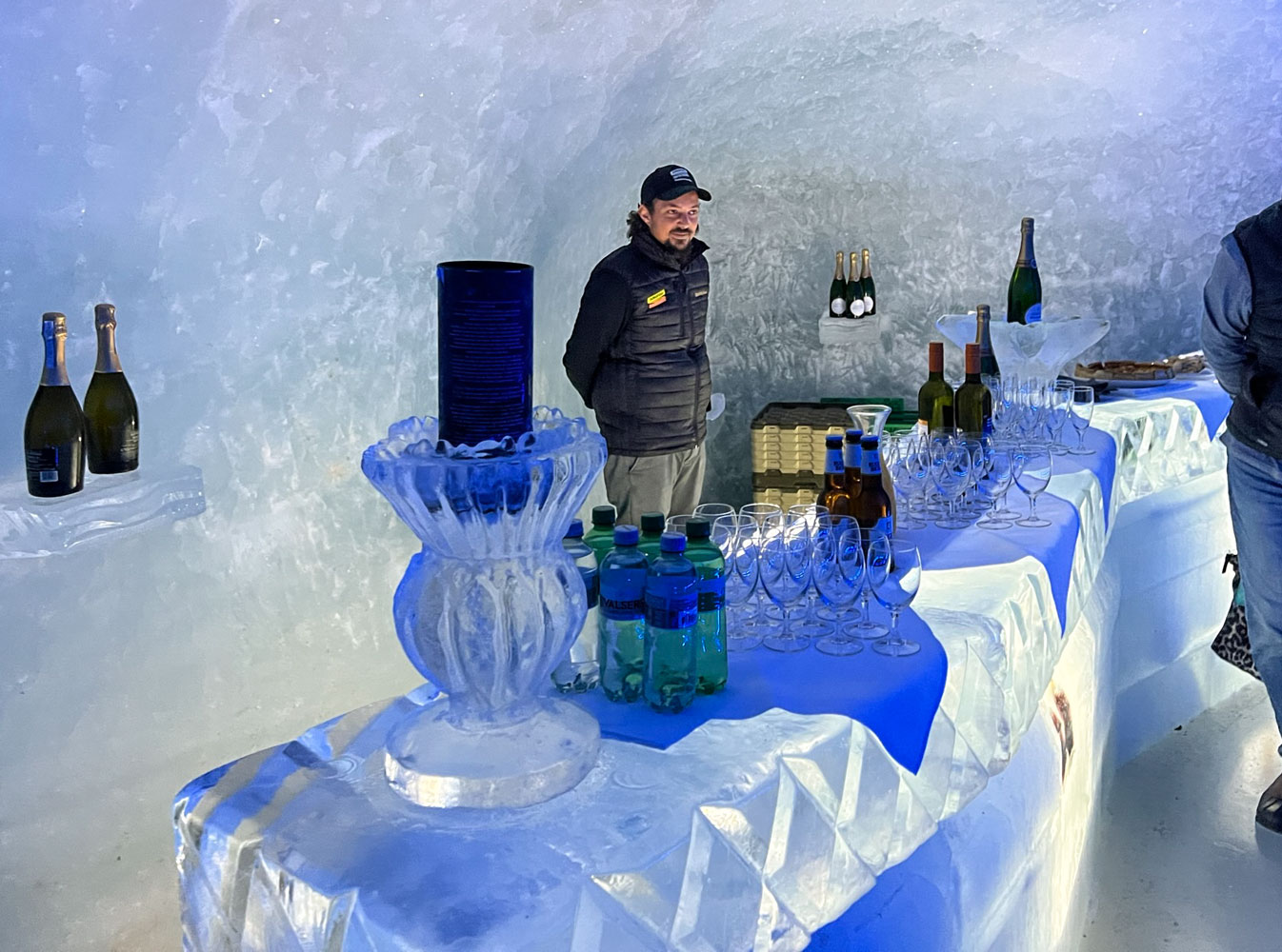
They served some food as well as various alcoholic drinks, but we had to let go of the handrail to go up to the bar.
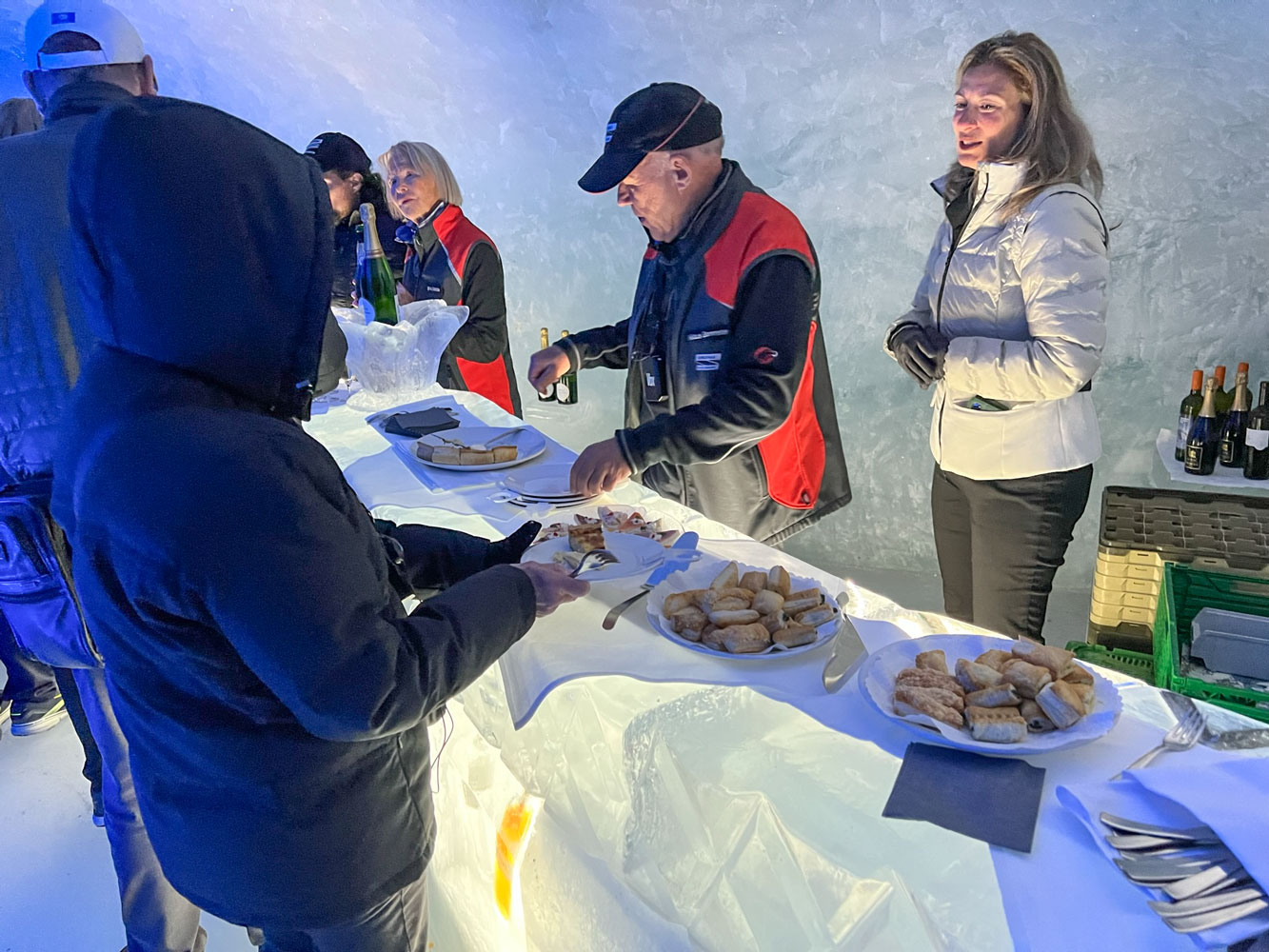
Judy, Jean and I went as far as the end of the bar and held on to the bar while we had our food and drink. This picture was taken from the end of the bar where we camped out. At least we were not cold. My hands got a bit cold - I had to leave my gloves off to take pictures - but I think Judy and Jean had gloves.
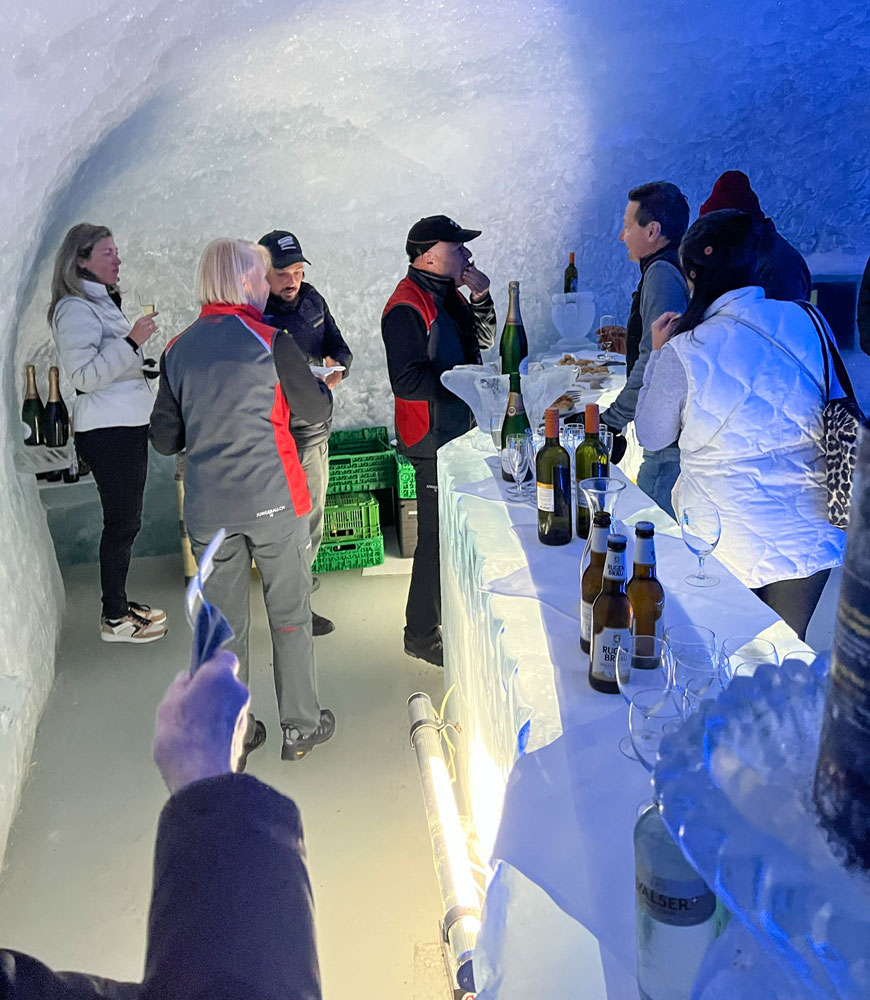
It seemed like we spent a long time in the Ice Bar, but it was probably less than it seemed. I was very glad to leave the Ice Bar and the Ice Palace. It was not a pleasant experience.
After we got out of the Ice Palace we were offered the chance to walk out on the glacier. Here's the room with the door to the glacier. It's labeled "Plateau".
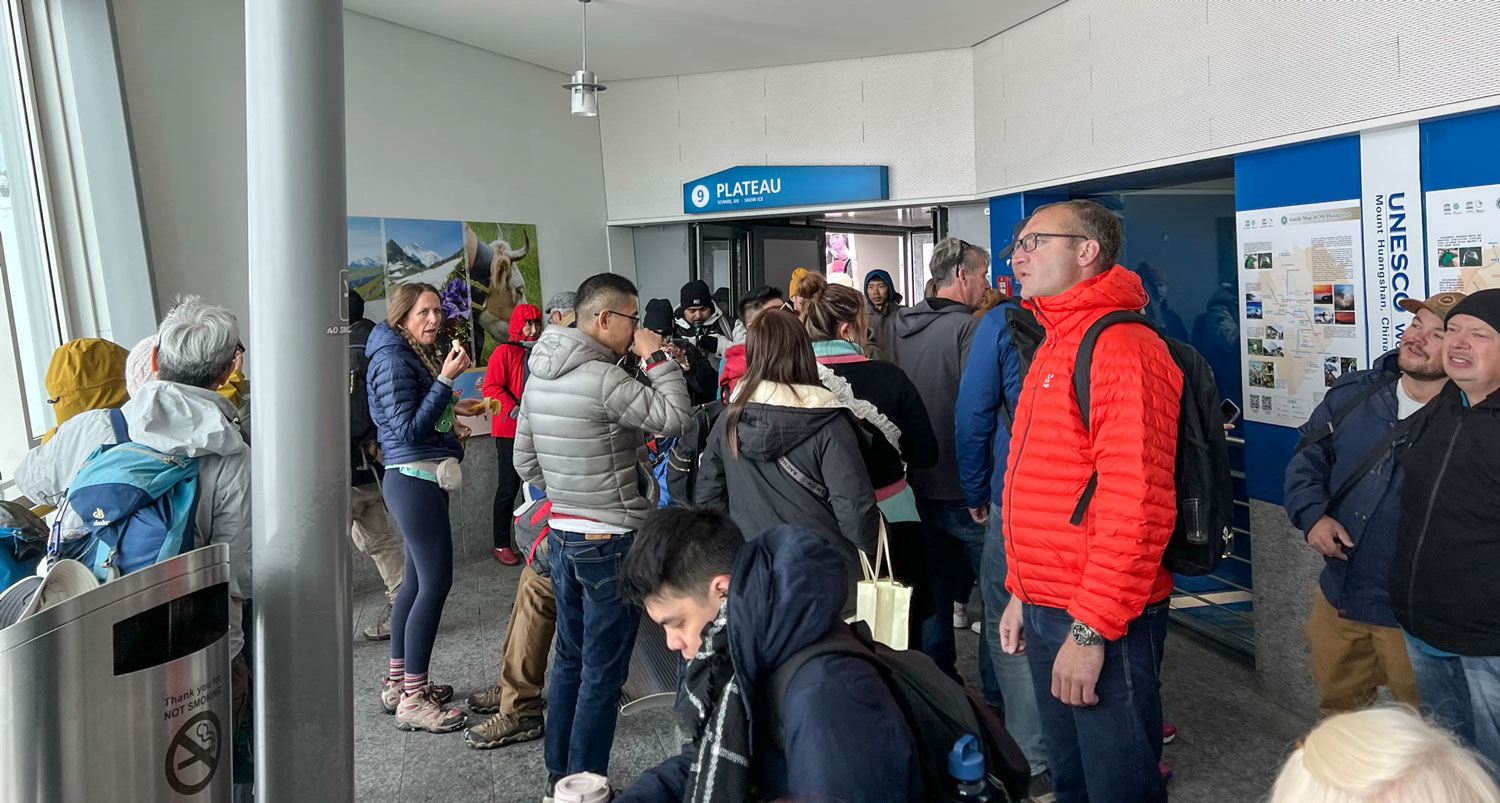
But after slipping and sliding in the Ice Palace I was not anxious to walk out on an icy surface again, so I stayed at the doorway. It probably would not have been as bad, since the surface was more snow than ice, but I still stayed at the door.
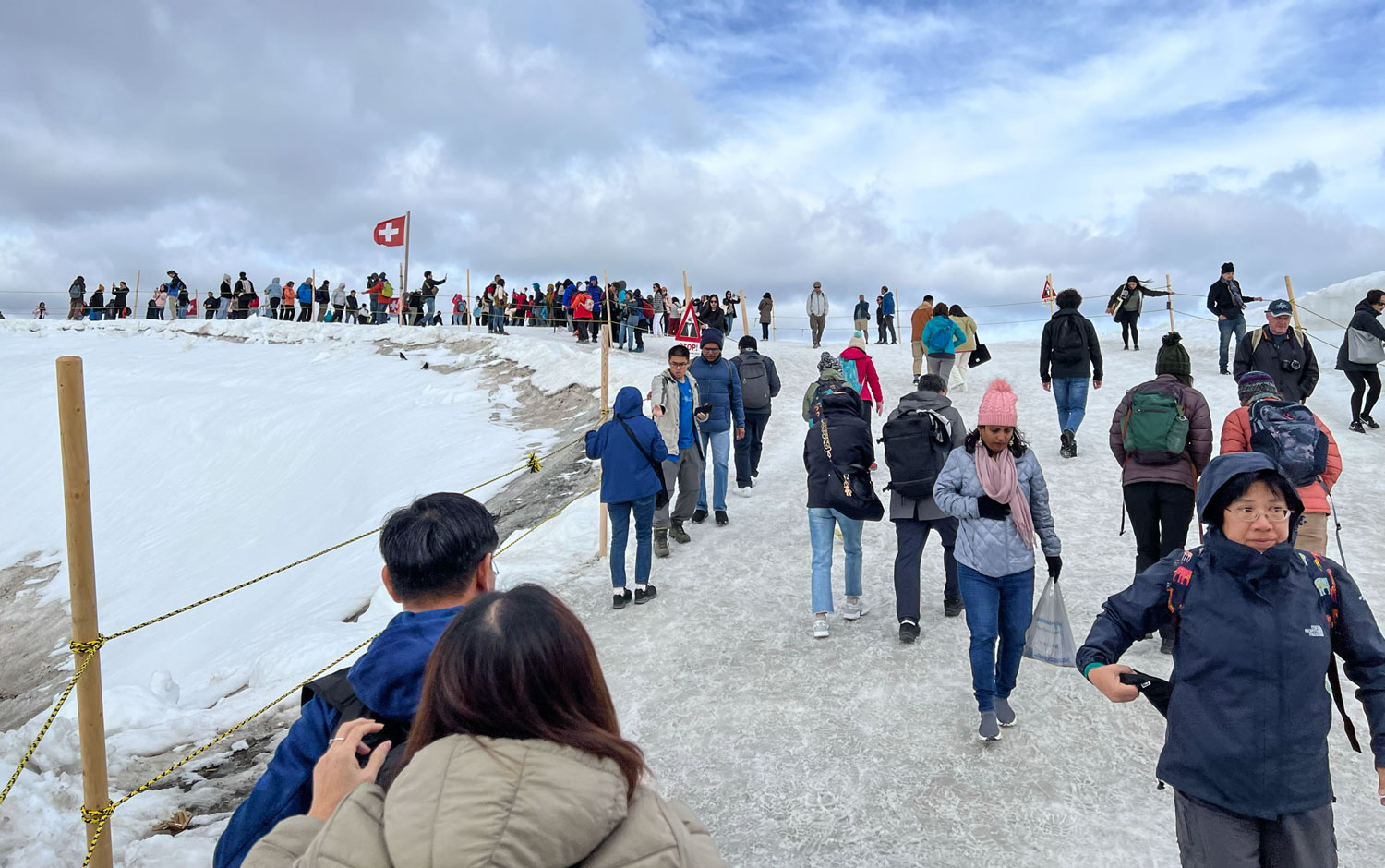
Here's Jean inside that room.
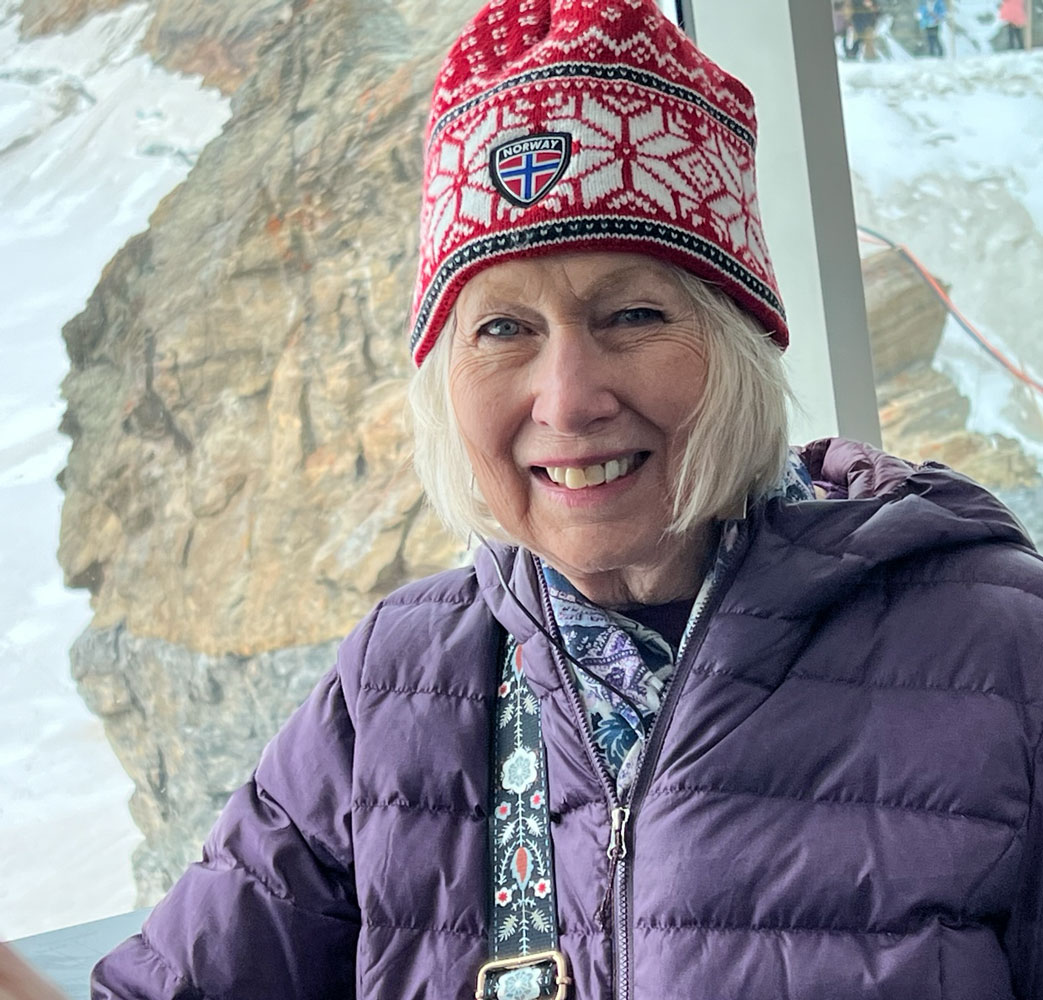
Judy, same place.
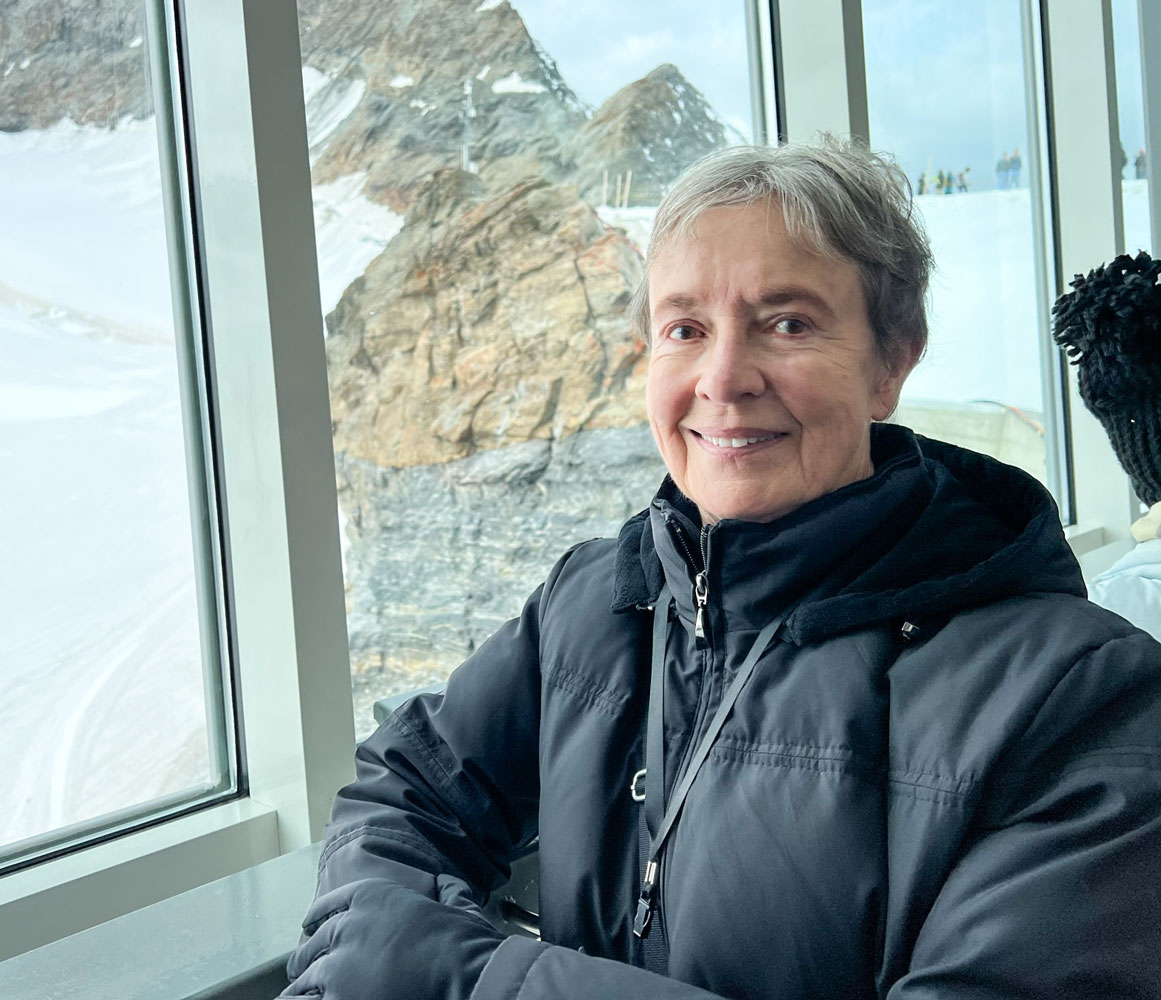
Jean, Cathy, Julie, and Jean.
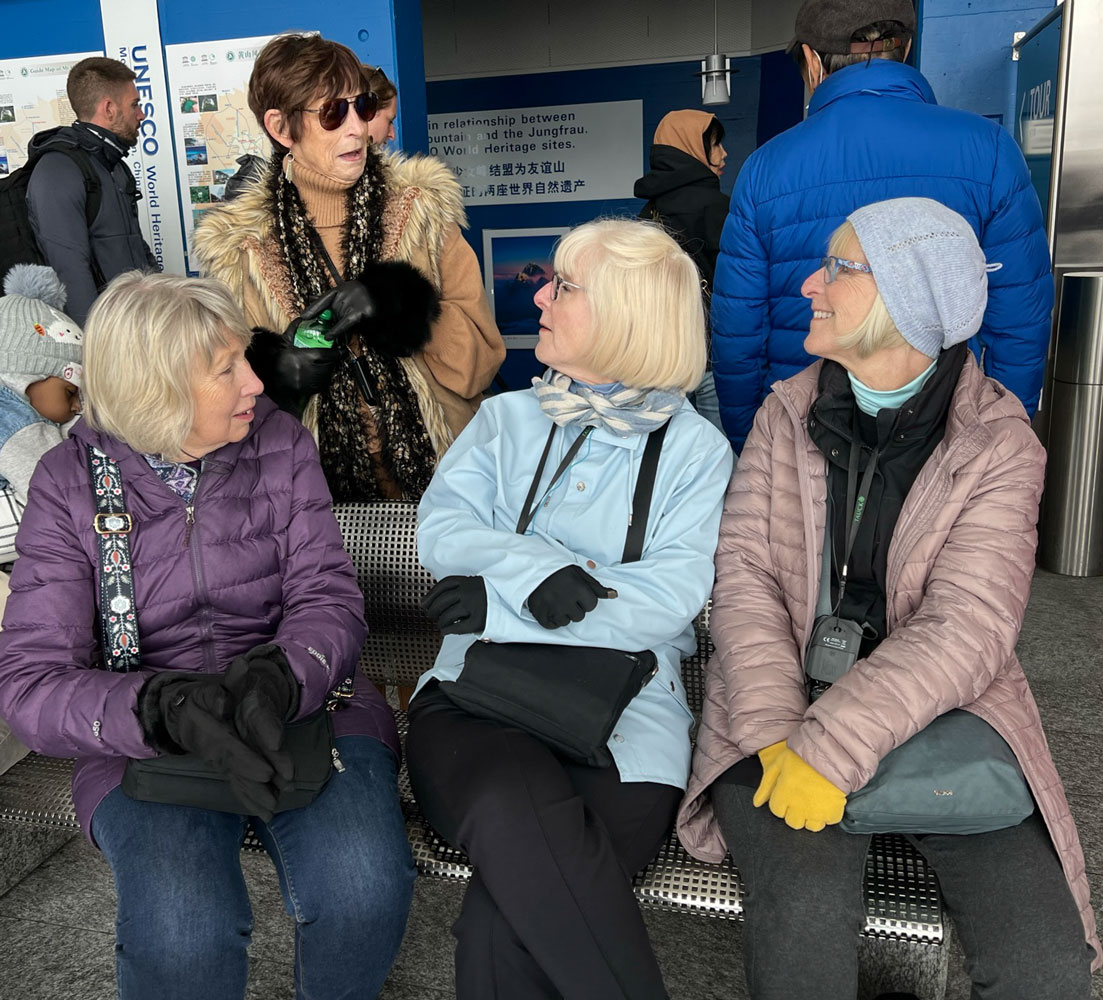
A long tunnel led us to the elevator bringing us to the Sphinx platform at the very top of the Jungfraujoch.
The lighting wasn't really that blue. It's an artifact of the LED lighting they use and the camera.
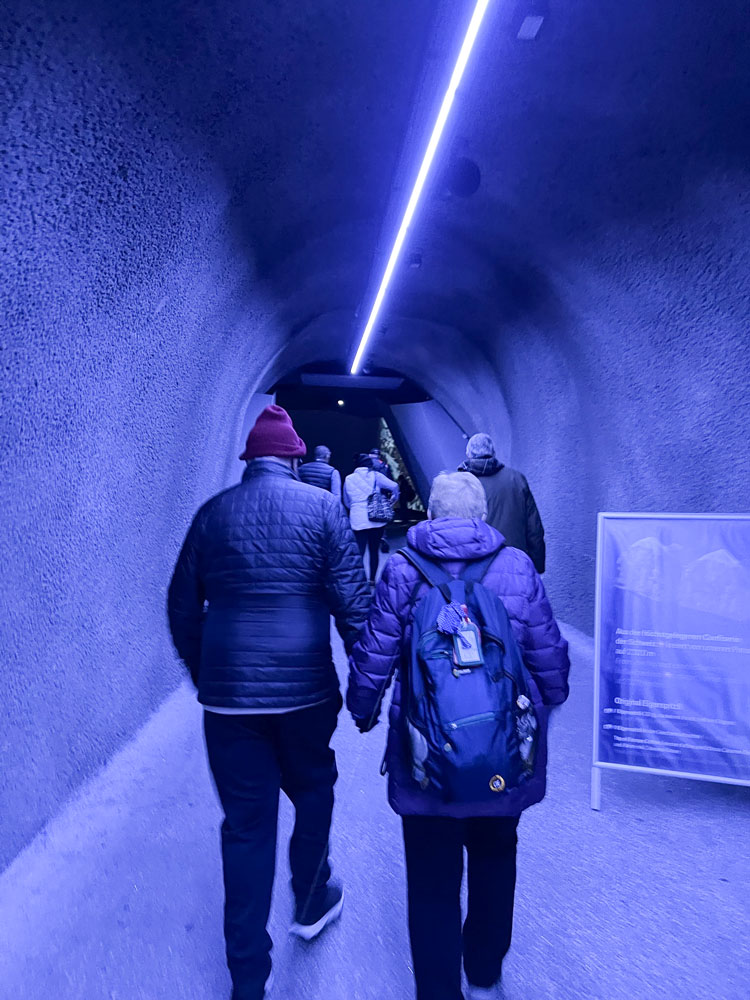
Here we are at the elevator. It was a long lift to the top.
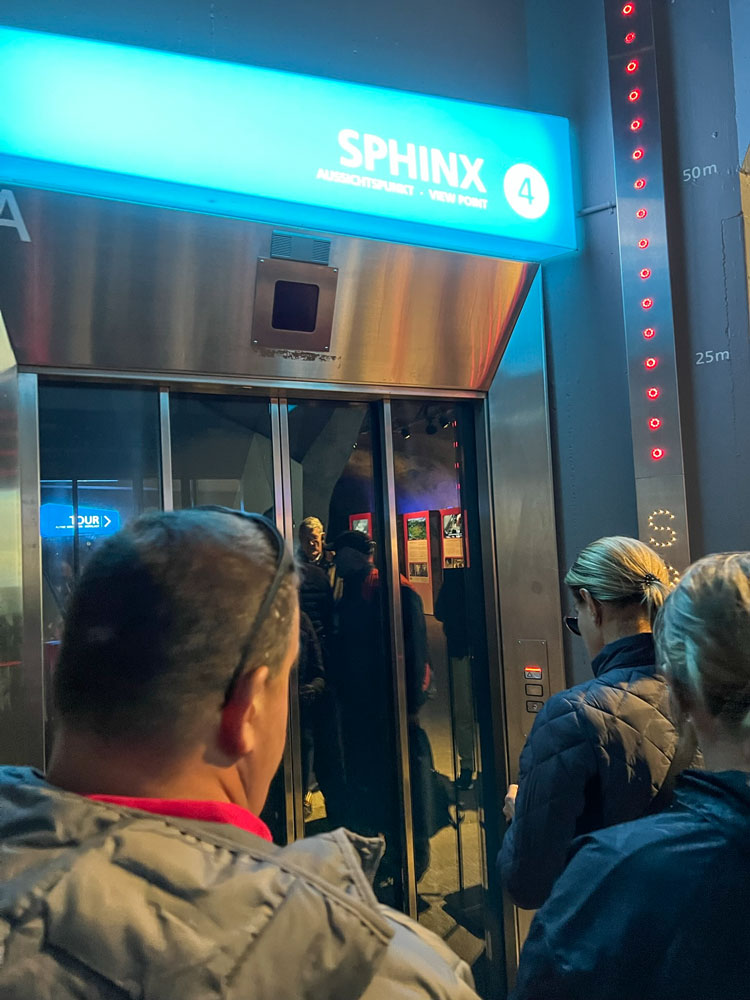
I didn't take a picture of the platform at the top, but here's a view from the web, with no one on it. It's at 11,684 feet.
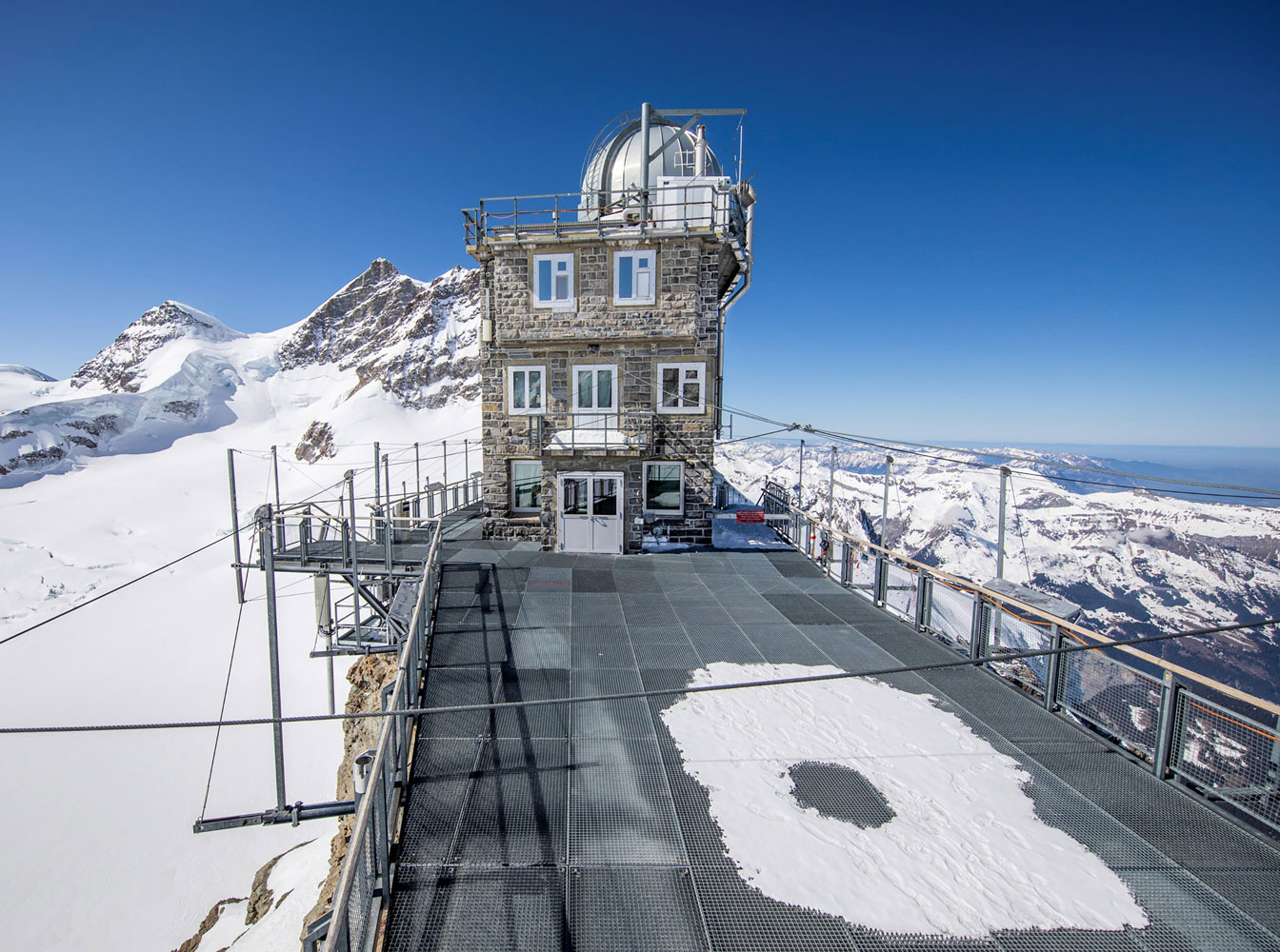
It was very crowded when we were there. I went around the outside and took pictures in each direction.
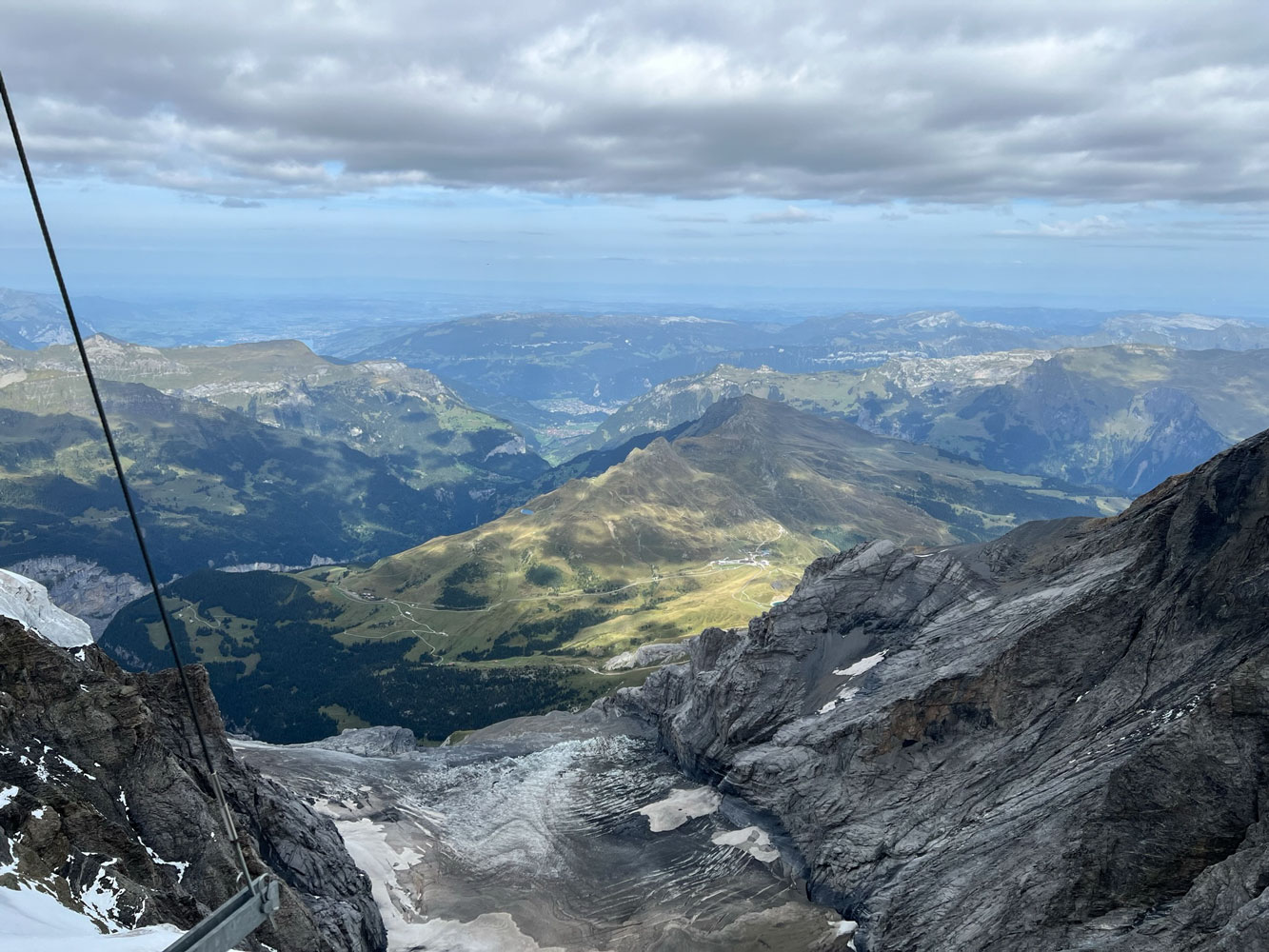
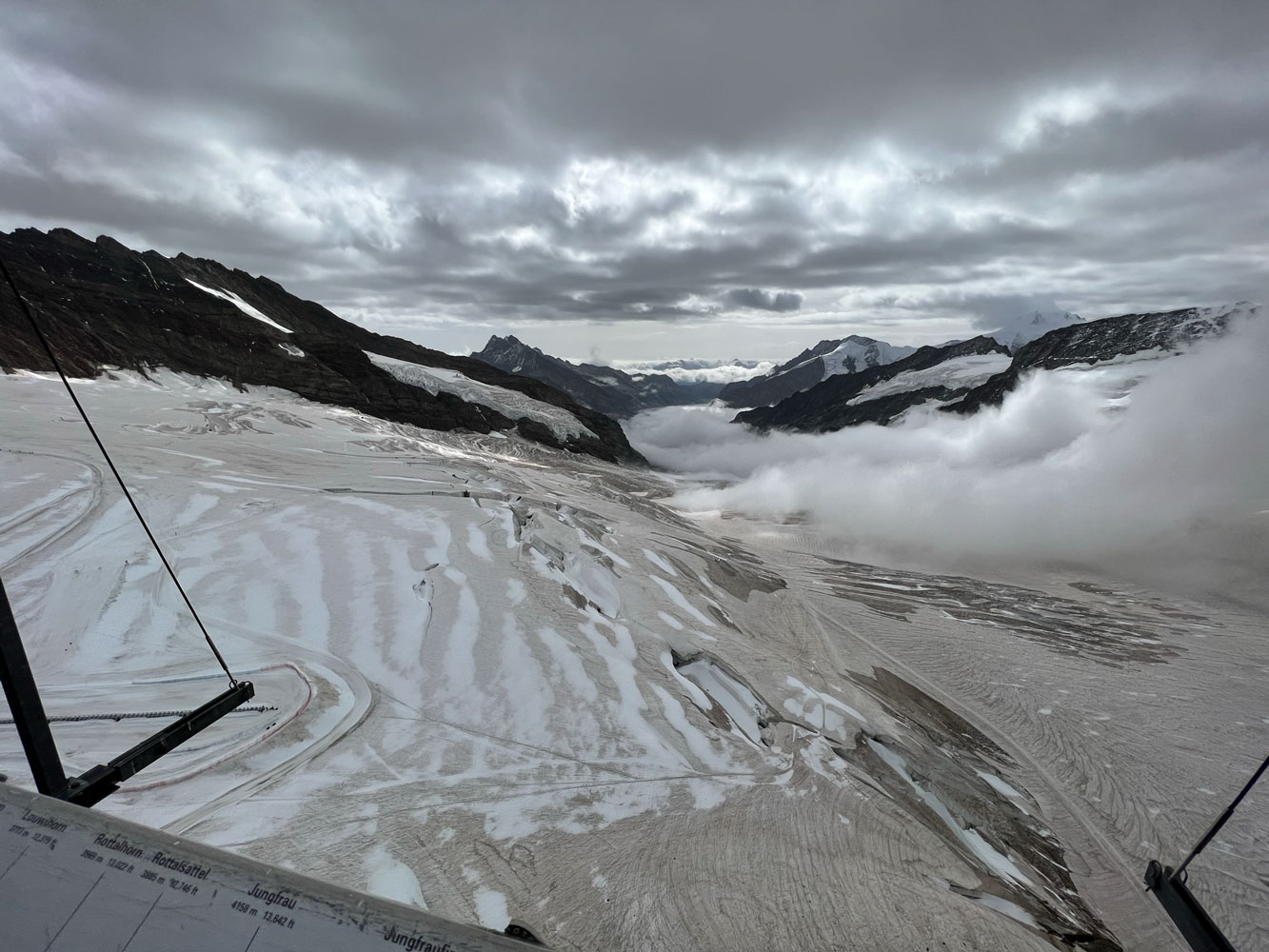
In one direction we saw skiers being brought in by helicopter, but shortly after that the runs were closed because weather conditions had opened crevasses, and conditions were dangerous.
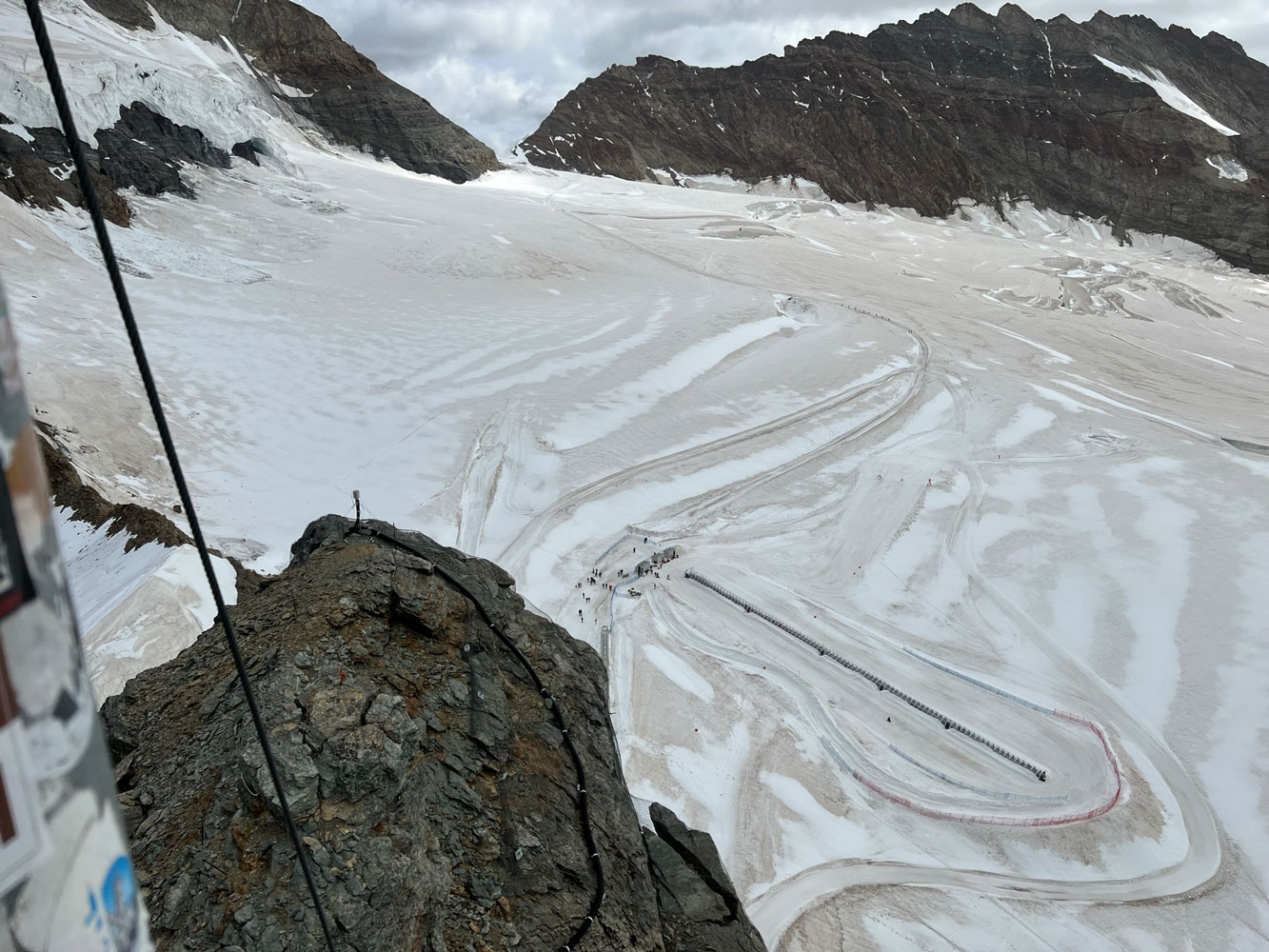
A closer view of the skiers and one groomed circular run.
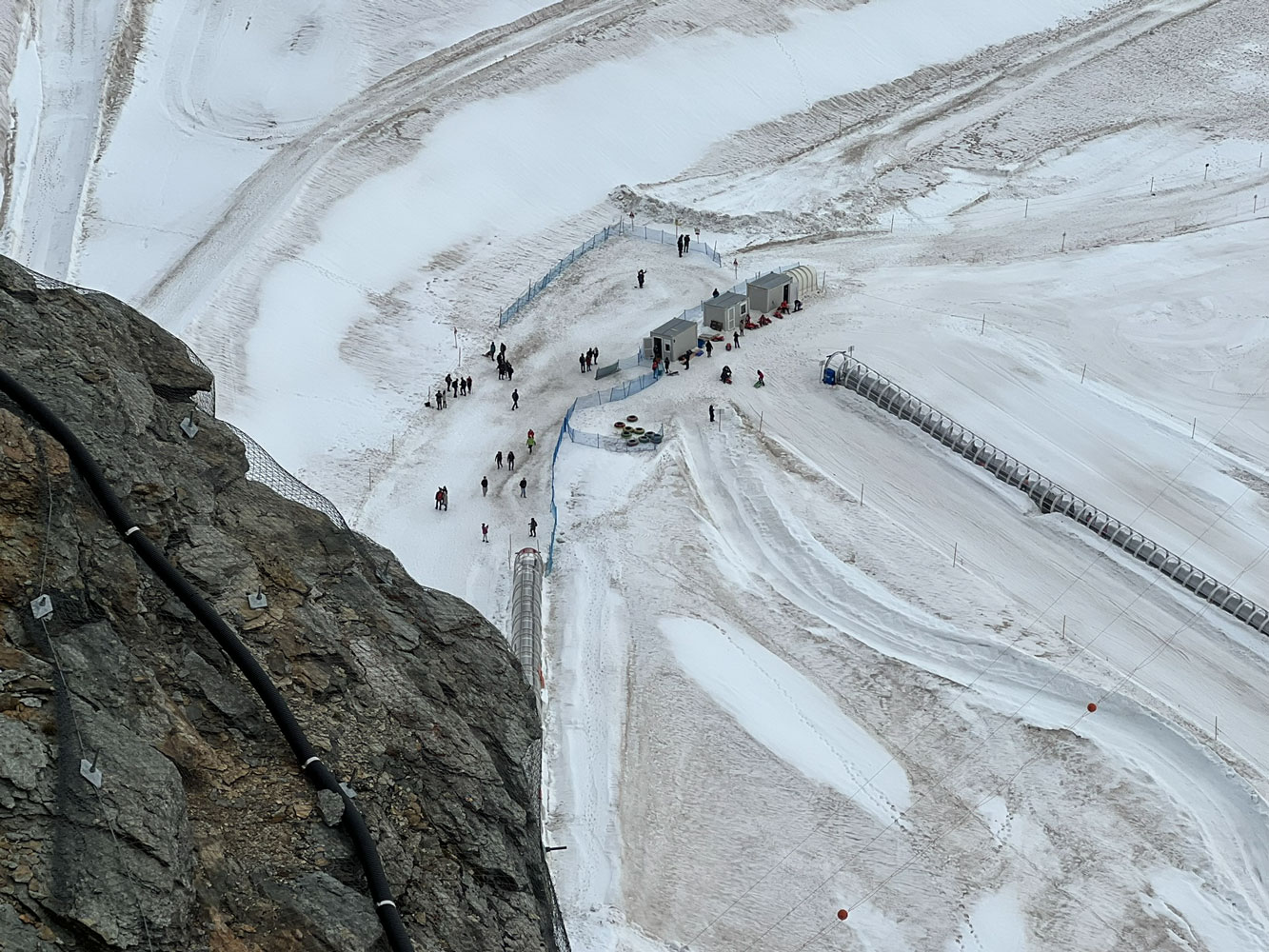
Jean up on the Sphinx.
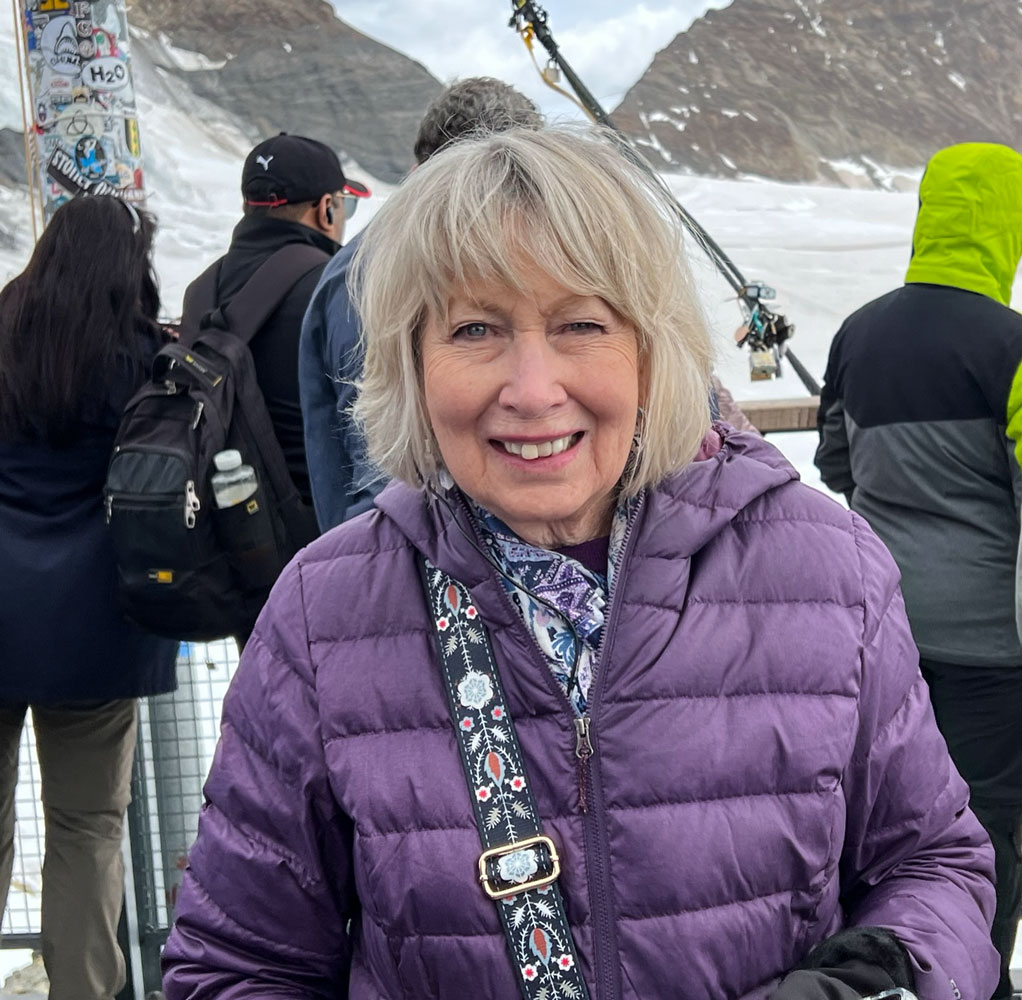
And Carrie.
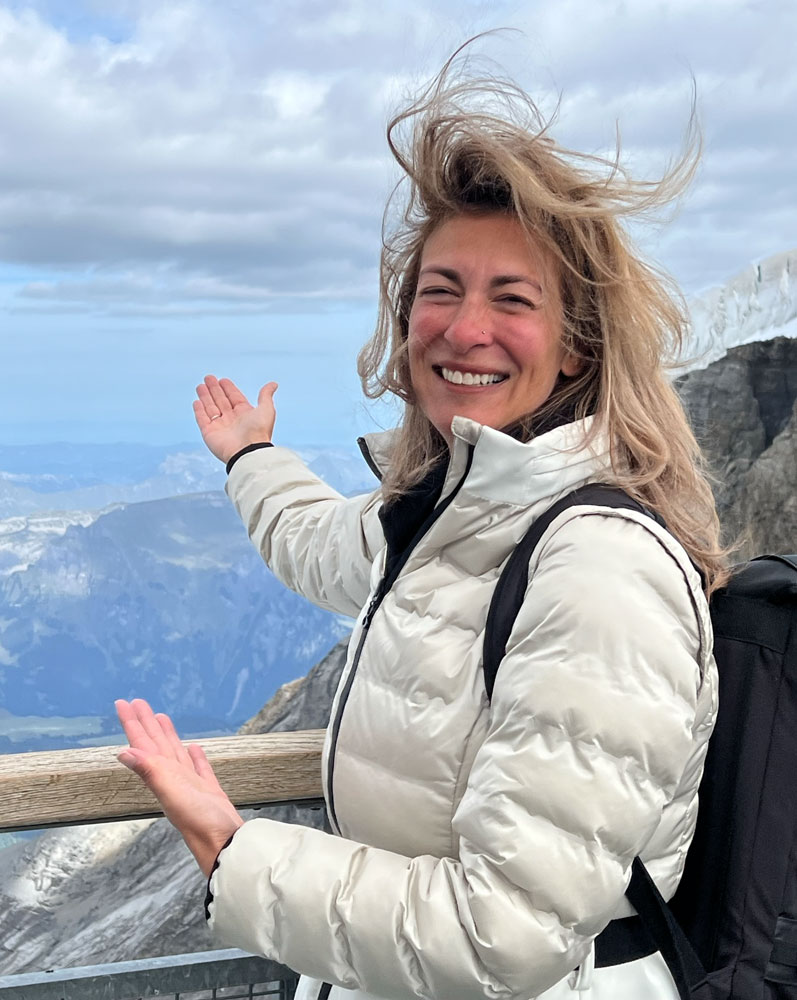
Only some of the tour people were on the Sphinx, and we got them together for a partial group picture.
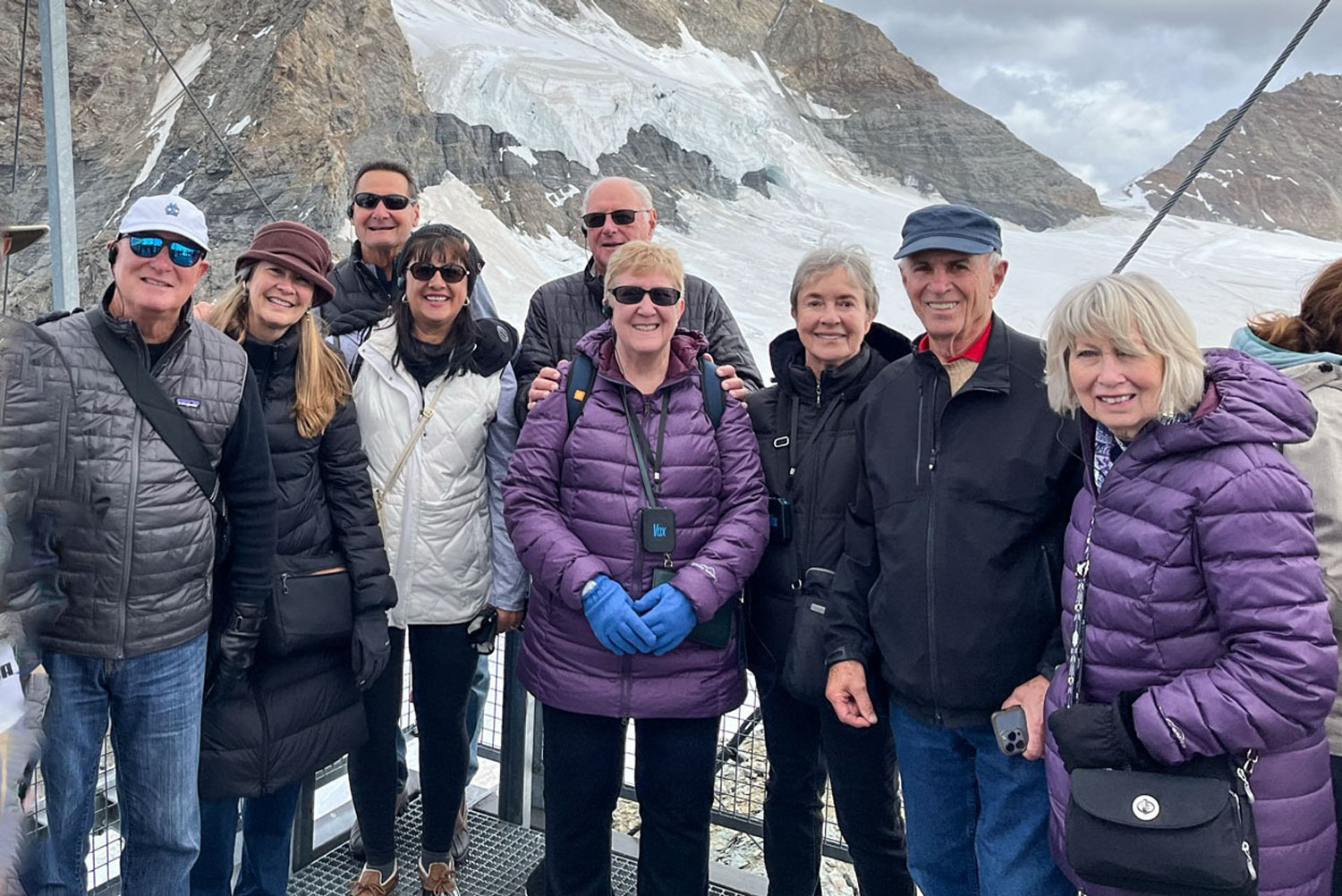
Then it was time to begin our trip back down. We took the elevator down, and then walked through a different tunnel back to the main part of the Jungfraujoch, and gathered in the cafe.
Carrie bought hot chocolate for each of us.
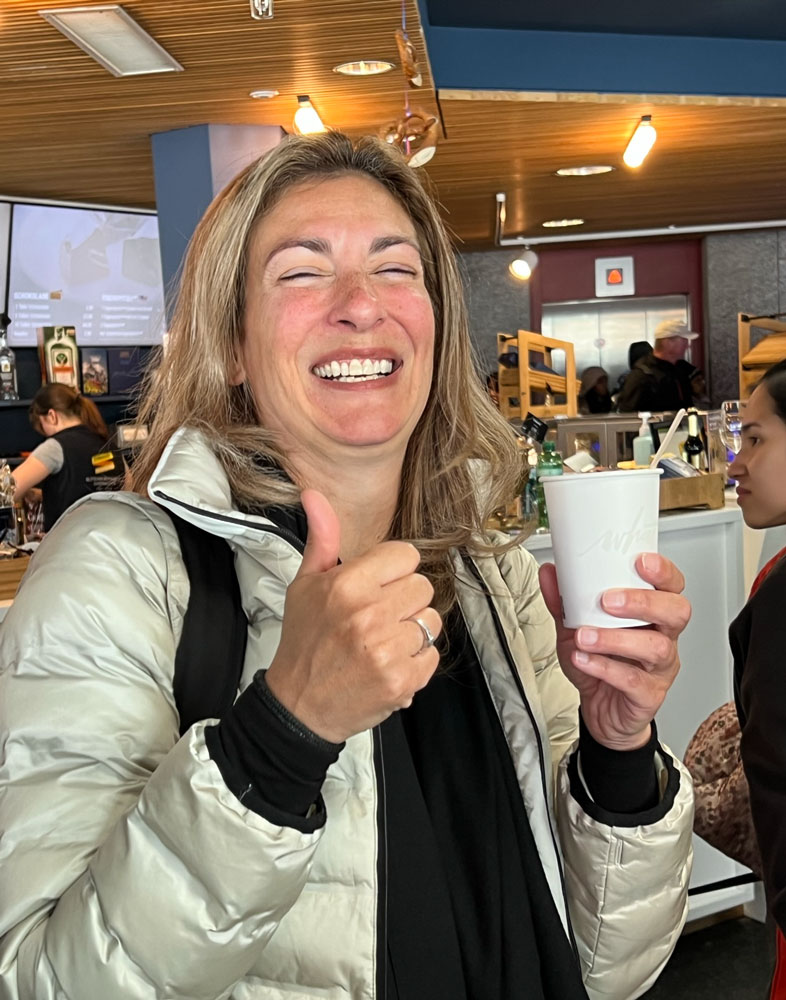
Then, we went to the train station and caught the train down. Overall, I suppose the Jungfraujoch is something you have to experience once. The views were great but the crowding, and the resulting pushing and shoving, was not pleasant. The Ice Palace was interesting to see but too dangerous to go back to. Maybe with the curling grippers it would be more enjoyable. Shame we didn't know about them before we went there.
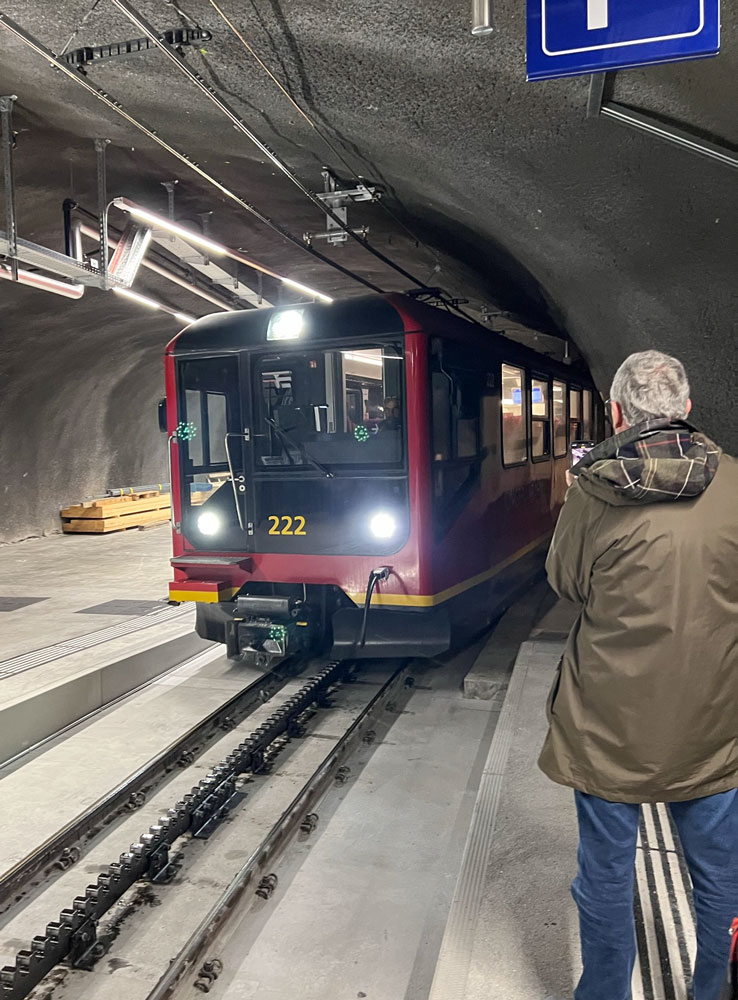
This time, we got off the train at the Eigergletscher railway station and caught the new Eiger Express cable car down to Grindelwald. Here we are at the cable car station. You step on board the car as it's moving.
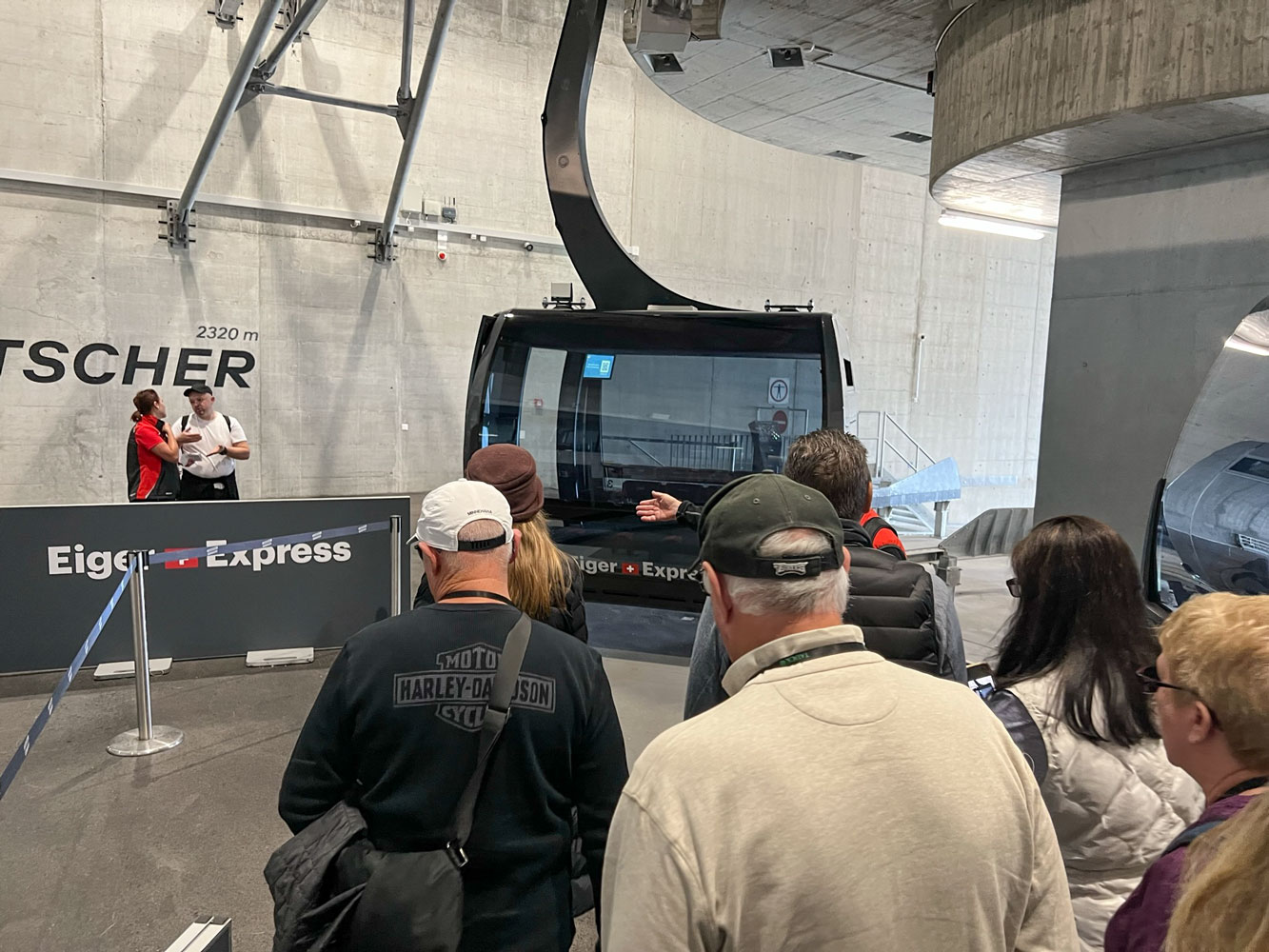
Here we go! The two outside cables are the support cables - they don't move. The center cable is the traction cable that the car is attached to and it is pulled around the cable car track, thereby pulling the car up or down.
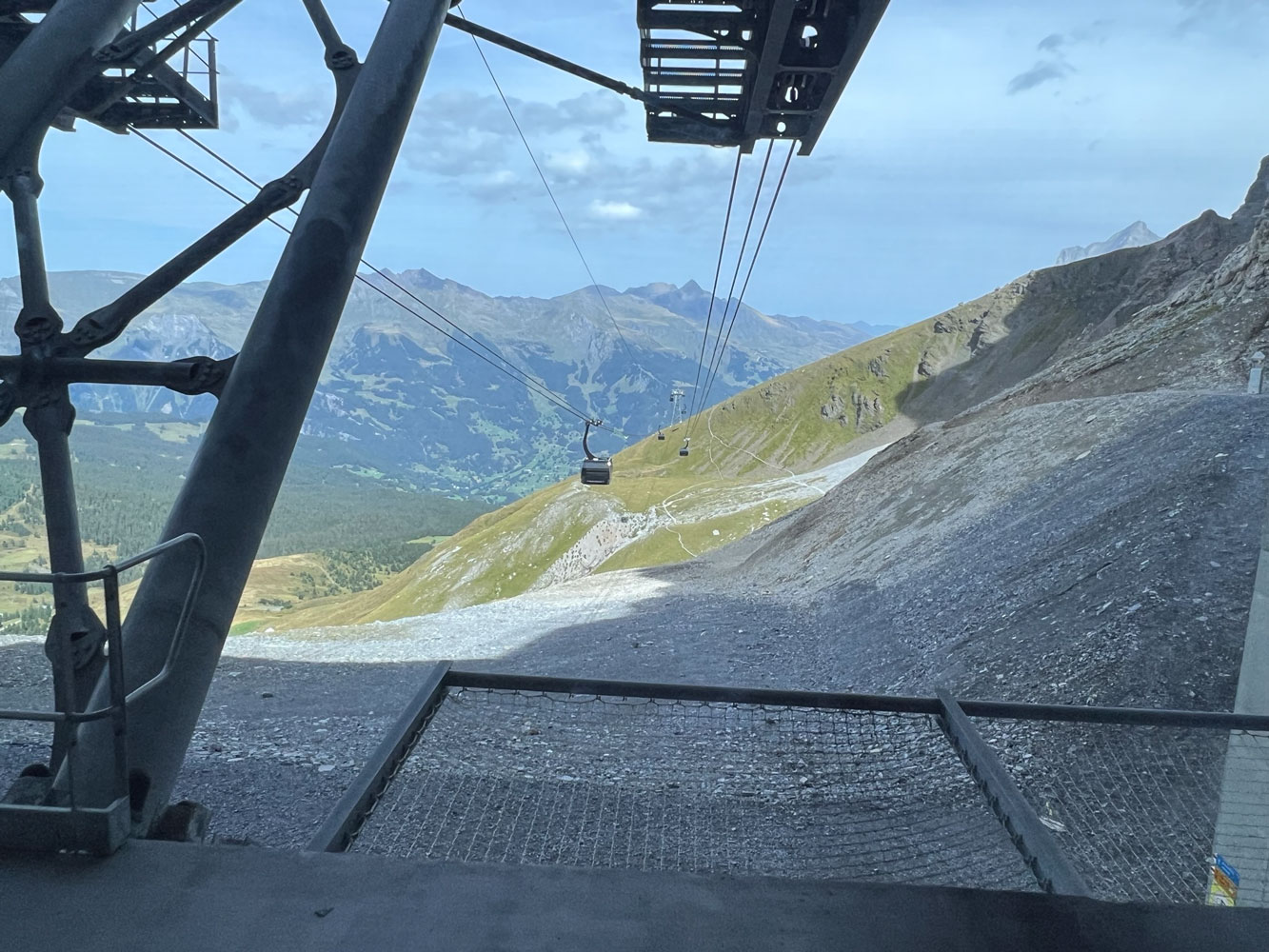
A view of a snow shed over the cog railway.
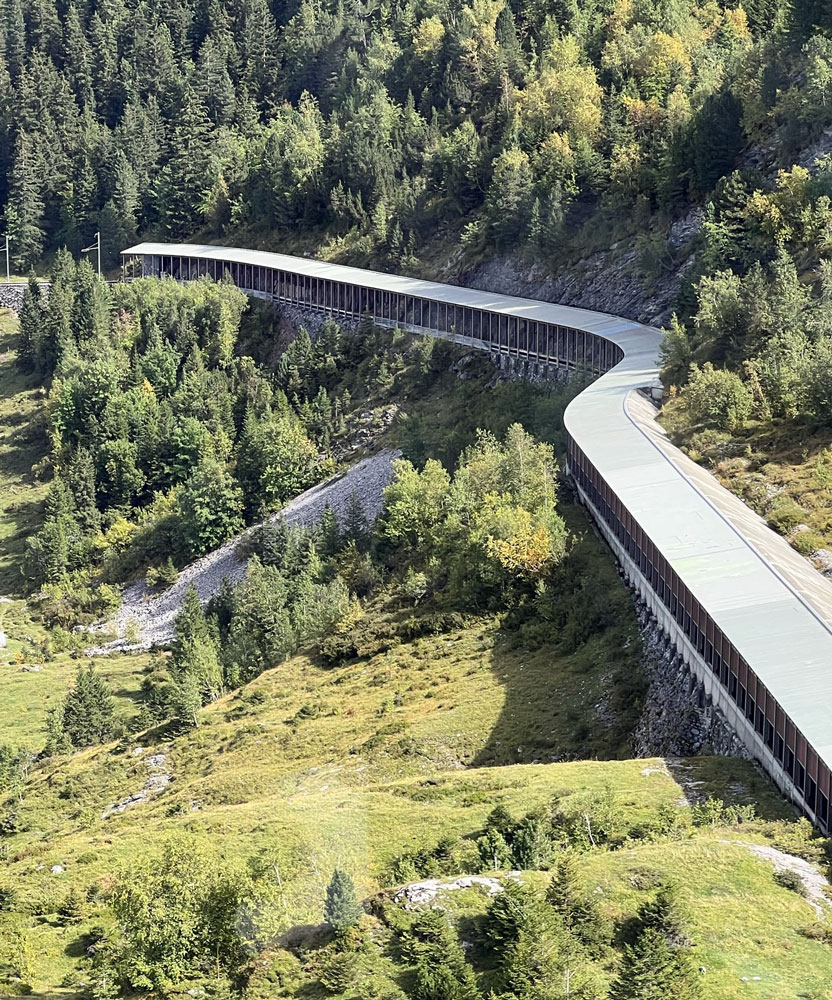
And a view of one of the cable cars coming up as we were going down.
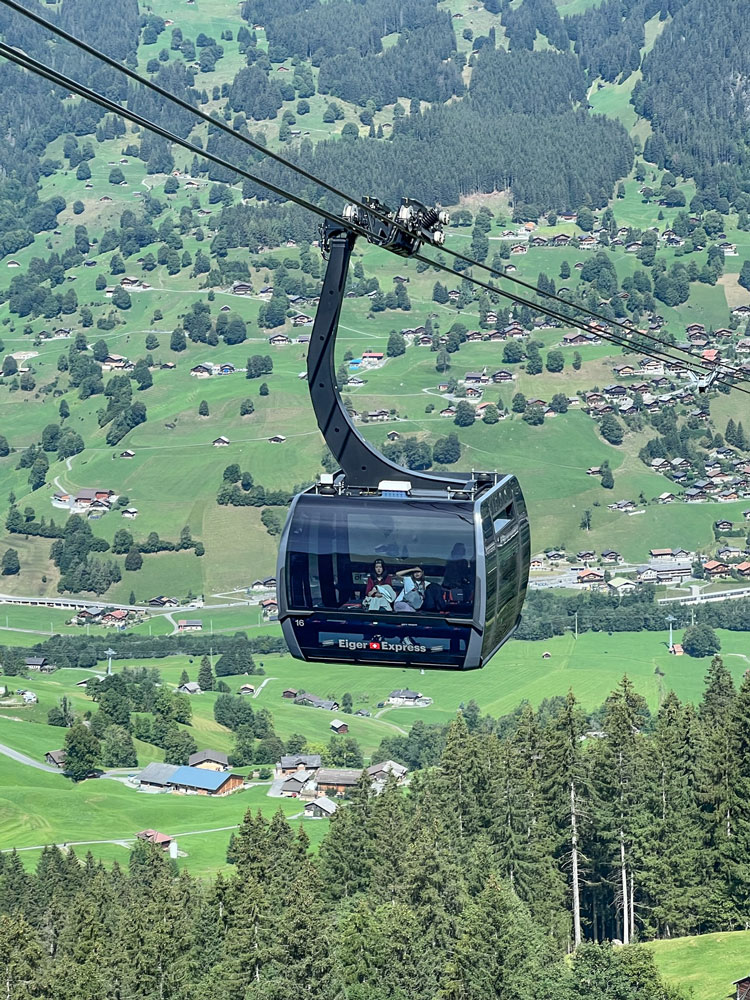
At Grindelwald we boarded the bus and headed back to the hotel. We had dinner at the hotel's Italian restaurant, with seating outside. Here's Judy and Jean at the outdoor table at the restaurant. It was a mild evening.
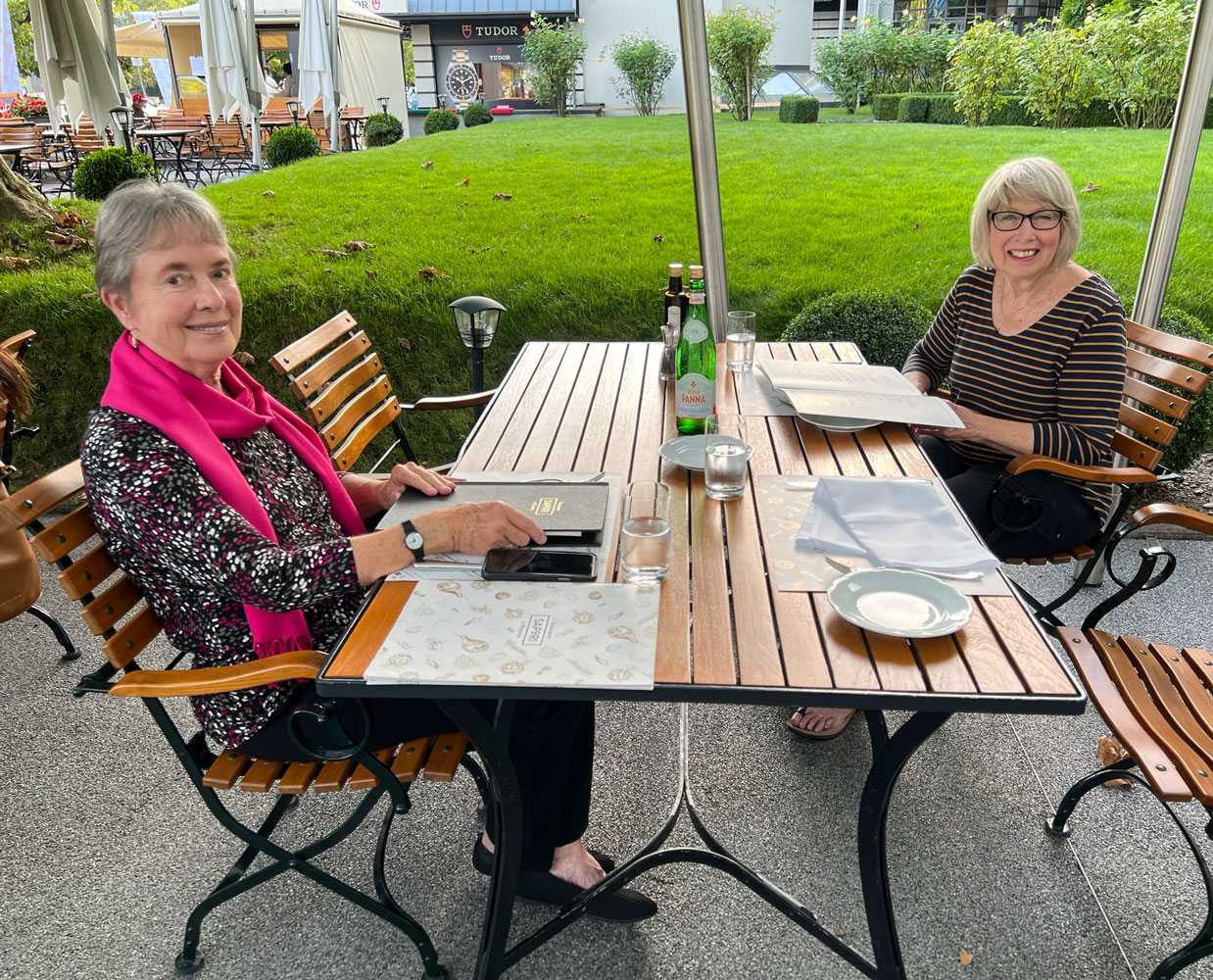
That was the end of our day. Tomorrow, we head to Bern and then to Lucerne.